- Home
- Collections
- POPPELWELL MD
- Various
- Centenary Sacred Heart, Hastings 1882-1982
Centenary Sacred Heart, Hastings 1882-1982
Page 2
tu es Petrus et super hanc petram aedificabo ecclesiam meam
pasce agnos meos pasce oves meas
The Holy Father
imparts the
Apostolic Blessing to the
Sacred Heart Parish
at Hastings on the Celebration of its first Centenary since its Foundation
Ex Aedibus Vaticanus die 17. XI. 1982.
+Antonius […]
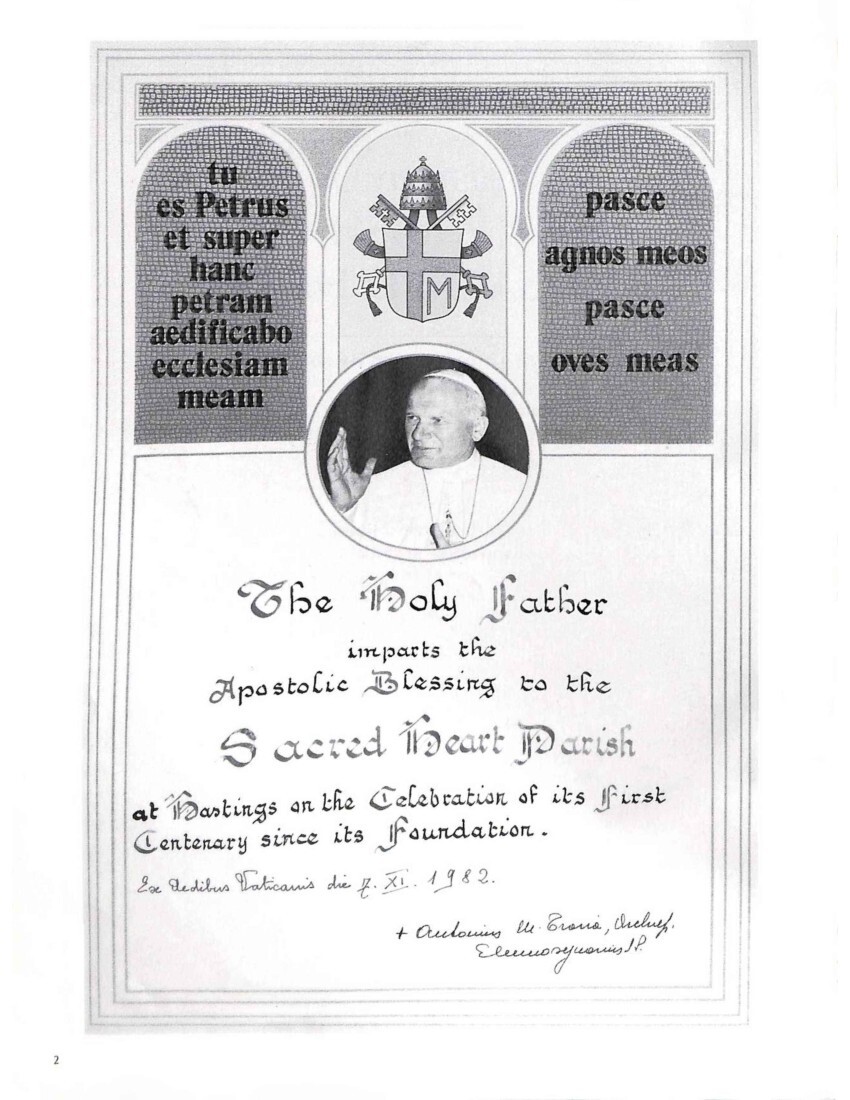
Page 3
SECRETARIAT OF STATE
No. 98447
FROM THE VATICAN.
18 October 1982
My Lord Bishop,
The Holy Father was pleased to be informed that Sacred Heart Parish in Hastings East is celebrating the Hundredth Anniversary of its establishment.
On this joyful occasion His Holiness is united spiritually with all the members of the Parish. He gives thanks to the Lord for the graces bestowed on the parishioners over the past century through the preaching of the word of God and through the sacramental ministry of the Church, especially through the Eucharistic Sacrifice, which in the expression of the Second Vatican Council remains “the source and summit of all Christian life” (Lumen Gentium, II).
The Holy Father prays that this commemoration will be for the Marist Fathers and the whole parochial community an occasion for renewed fervour in authentic Christian living, according to the standards of the Gospel.
With these sentiments His Holiness sends his Apostolic Blessing, in pledge of joy and peace in Jesus Christ.
With every personal good wish, I remain
Yours sincerely in Christ,
E Martinez
+E. Martinez
Substitute
The Most Reverend Peter J. Cullinane
Bishop of Palmerston North
36 Ihaka Street
Palmerston North
APOSTOLIC NUNCIATURE
112 QUEEN’S DRIVE,
WELLINGTON, 3,
NEW ZEALAND
P. O. Box 14044
Telephone 873-470
15 August, 1982.
Dear Father
It is my pleasure to greet and congratulate you and your parishioners on the occasion of the centenary of the parish of the Sacred Heart, Hastings.
Though thanks are due at all times to Almighty God for His countless blessings, there are milestones in the history of a parish at which special acts of gratitude are called for. The centenary of your parish, so happily placed under the patronage of the Sacred Heart of Our Lord is certainly one of them. Let all, then, say with St Paul : “ Blessed be God the Father of Our Lord Jesus Christ, Who has blessed us with all the spiritual blessings of heaven in Christ.” (Ephesians 1/3)
Gratitude then, for the things well done in the church, home and school, as witnessed by the firm faith, living hope and responsive charity of priests, sisters and people throughout this first hundred years.
There is something special about a centenary. It flows from the maturity of years. At least four generations have contributed to the character of the parish, none of them isolated but each of them interwoven and passing on to others the precious treasures of the Faith brought from overseas and committed to them throughout long centuries. From faith-filled home-life have sprung vocations to the priesthood and religious life as well as the unswerving fidelity of families to the love of God and of neighbour.
For these and so many others blessings thanks must go to God in the first place, and under God to the Marist Fathers, the Sisters of St Joseph of Nazareth, the Little Sisters of the Poor and the unsung heroes and heroines of Catholic families, all of whom have made the history of the parish.
May the Sacred Heart of our Saviour continue to be the source and fountainhead of living water springing up unto eternal life for generations yet to follow.
With best wishes to you and your parishioners,
Yours sincerely in Christ,
+ Antonio Magnoni
+ Antonio Magnoni,
Apostolic Pro-Nuncio.
The Very Rev, G. Officer, S.M., P.P.,
Sacred Heart Parish,
HASTINGS.
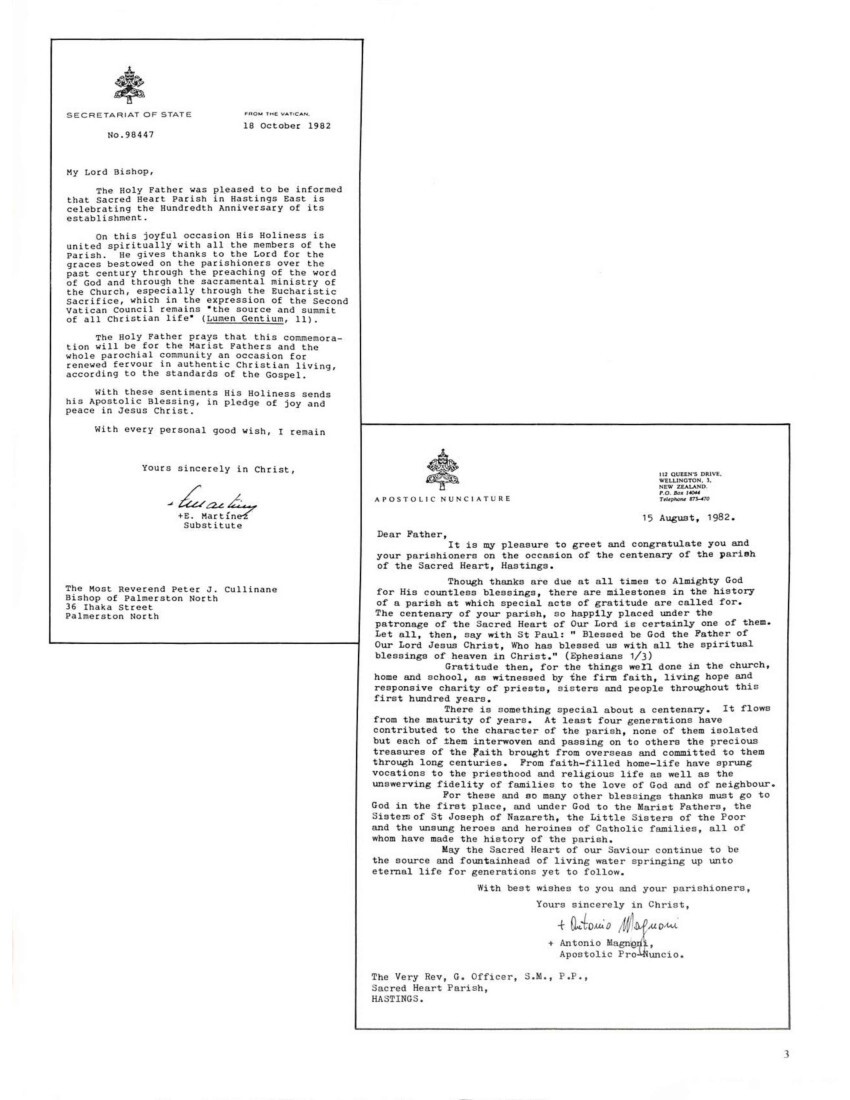
Page 4
Dear Parishioners of Sacred Heart Parish, Hastings.
A Jubilee like yours is a time to remember with gratitude those who have gone before us and whose sacrifices are the reasons why the faith has come down to us. It is also a time to look to the future with breadth of vision and courage.
We who live in the present are the ones who have been entrusted with the task and the joy of celebrating this Jubilee. I trust your celebrations will be worthy both of the past and of the future, and I have every reason to believe this will be so.
On my own behalf, and on behalf of the rest of the Diocese, I congratulate you, and I look forward to spending some time with you all.
With every best wish and blessing.
P.J. Cullinane
BISHOP OF PALMERSTON NORTH
TEL. 589.9041
CABLE MONTEVERDE
ROMA
SOCIETAS MARIAE
PADRI MARISTI – VIA ALESSANDRO POERIO. 03 00152 ROMA
CURIA GENERALIS
September 12th, 1982
Feast of the Holy Name of Mary.
The Rev. Father G. Officer, s.m.
Parish Priest, Sacred Heart Parish
HASTINGS. N.Z.
Dear Father Officer,
It is with great joy that I associate myself with you, with the Marist Community, the Parish Council, and the Religious and Laity of Sacred Heart Parish, Hastings East, in giving thanks to God through His Holy Mother, on the occasion of the Centenary of Faith of the Parish. United with me in my expressions of good wishes are the members of the General Administration and, indeed, the whole Society of Mary. From the vantage point of Rome where one is in touch with the very dawn of Christianity, one hundred years may not seem a long time, but we know that in the eyes of God the maturity and stature of a local Church are not measured in terms of anything so fleeting as time.
The foundations, so well laid by the indefatigable Apostle of Hawke’s Bay, Father Euloge Reignier, and his sparse flock, have been blessed by God through the zealous labours of successive pastors, so that three parishes now flourish in the original mission area.
The task of Christian Education began almost simultaneously under the care of the Sisters of Saint Joseph of Nazareth, who over the years have continued to guide towards God the first steps of the young setting out on the road of life. More recently, the Little Sisters of the Poor have been another valued physical and spiritual support to those whose steps approach their heavenly home.
The vigorous ecclesial life of the Laity is attested by the many Vocations to the Priesthood and Religious Brothers and Sisters that have come from their ranks. A local Church has grown to adult stature when it sends out from its own numbers those who will, in their turn, be heralds of the love of God and of His Gospel.
I see a special significance in your celebrations planned for the month of November, a month in which the Church is liturgically remembered in four feasts. We rejoice with those who have come to the full presence of the Lord by the ministry of the Parish; we pray for its departed members still in Purgatory; for the present Parishioners: may a spirit of gratitude for God’s generous graces in the past together with fidelity in the present be pledge of many blessings in the years to come.
Sincerely and fraternally in the Society of Mary,
B.J. Ryan SM
B. J. Ryan, s.m.
Superior General.
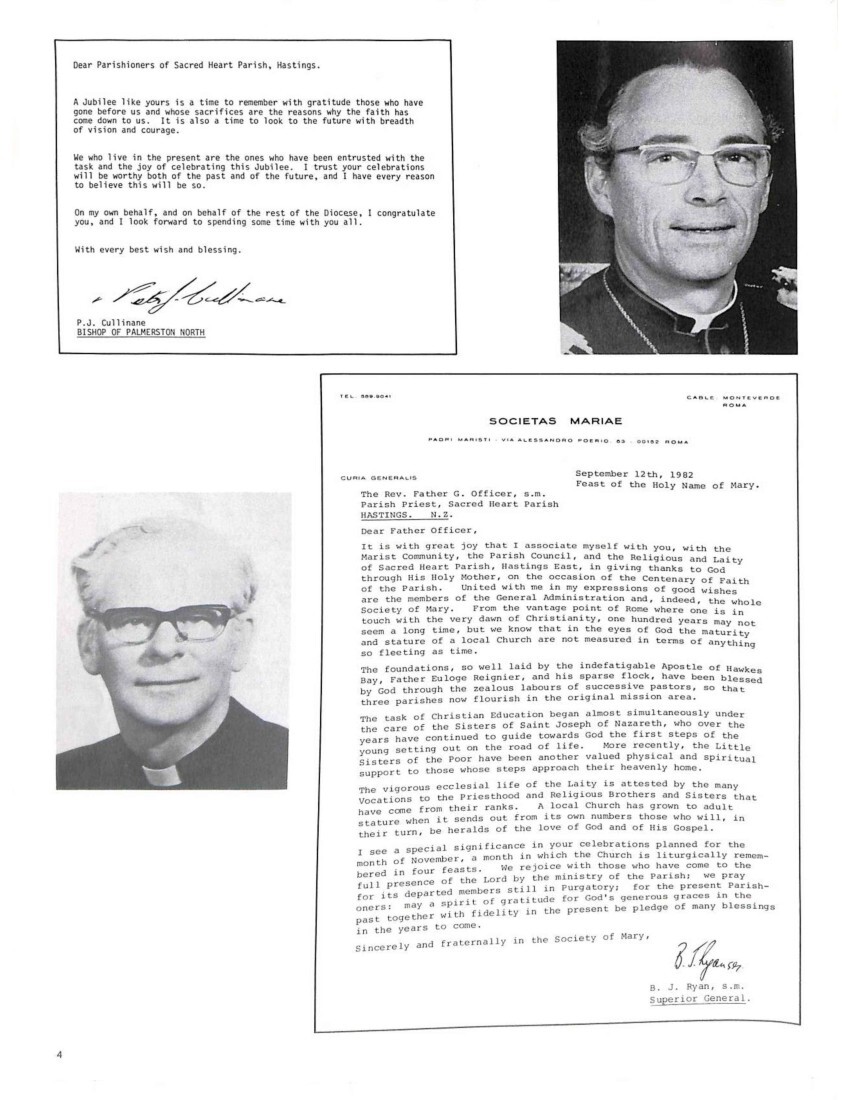
Page 5
Marist Provincial House,
“Cerdon”,
342 Oriental Parade,
Wellington 1. N.Z.
The Fathers & Brothers of the Society of Mary
Cables/Telegrams:
“Procure” Wellington
Telephone:
850-641 (2 lines)
Rev. Father G. Officer, S.M.,
Parish Priest,
Sacred Heart Parish,
Hastings.
Dear Father Officer,
I am sure you regard it as a great honour to be the Parish Priest of Sacred Heart Parish in this centenary year. The honour which is yours is shared by the entire Society of Mary because we have been so long associated with the people of Hastings.
One hundred and twenty four years ago Father Reignier, S.M., founded the mission at Meeanee. From this centre Marist priests cared for the spiritual needs of the few Catholics of the area, including Hastings, and carried on their missionary work to the Maori people.
Even in 1882 when Father Reignier was sent to reside in Hastings and built the first church and presbytery, Hastings was still a very small settlement. It is this building of the first church and establishment of the parish and the unbroken record of work to Maori and Pakeha which we are presently celebrating.
The people of the parish are indeed the People of God, a People with a unique mission to fulfil. In the first instance, it is to be a community of disciples, around their Lord, and in support of one another. From the strengths gained through membership of this community, they earnestly seek to spread the Kingdom of God and its values.
Today, as ever, the Church needs to be visibly and actively present in all human affairs. It is one thing to glory in the achievements of our forebears : those good men and women who took their places in civic and religious life, the sacrifices made in the cause of Catholic education, the lives of people spent in the service of freedom and the Gospel. More importantly is how we receive our inheritance and translate it into effective evangelising in our own time.
What should give all of you confidence : Priests, Religious and Laity, is that your inheritance is not a deprived one. It is very rich.
May I, on behalf of the Society of Mary, congratulate you on your heritage and encourage you all to step into your next century with generosity and purpose to share the Gospel, the Good News, with your fellow citizens.
24th August, 1982.
FM Bliss S.M.
F.M. Bliss, S.M.
Provincial
12 October, 1982
My dear People of Sacred Heart,
To have been appointed Parish Priest in the Centenary Year of the Parish of Sacred Heart was for me a singular honour. The celebration of a Centenary in the life of a Parish is an occasion for rejoicing and thanksgiving as well as a time of hope.
During the months preceding the celebrations we have had an opportunity to give thanks for the great foundations of faith that have built this Parish, Baptism, Marriage and the Priesthood. The Centenary celebrations are a time when we can give thanks that a little over one hundred years ago a group of Catholic Irishmen asked one of the great Maori Missioners, Father Euloge Reignier, to build a Church for them in Hastings. These early pioneers wanted the Church and the Mass in their midst.
With their initiative and the money they raised, a Church was very quickly built in 1881 and dedicated by Bishop Redwood in 1882. Soon, the Catholic population increased and Father Smyth, the second resident priest, and first official Parish Priest saw the need of a larger building.
Supported by an enthusiastic congregation, he built the present beautiful Church of the Sacred Heart. This building bears eloquent testimony to the solid faith and deep love for God, of the early Catholics of this region.
Looking back one hundred years, we thank God for the faith of those pioneer families. Many of these families are named on the windows of the present Church and it is to them that the Catholic Church in Hastings owes its foundation. We feel a responsibility to them to grow in that faith. In a true sense each generation pioneers its own age. We pray that this generation nourished by the spirit of these early first families, will lay foundations for a greater and deeper life of Catholic faith.
We humbly thank all those of the past 100 years who have brought us to this moment of history. Some record of their accomplishment is contained within these pages. Much is found in the love and service of those who have preceded us, and still more from those yet to come.
But the full story is found only in the Sacred Heart of Jesus.
I ask a blessing on you all, this Centenary year.
G. M. Officer, S.M.
PARISH PRIEST
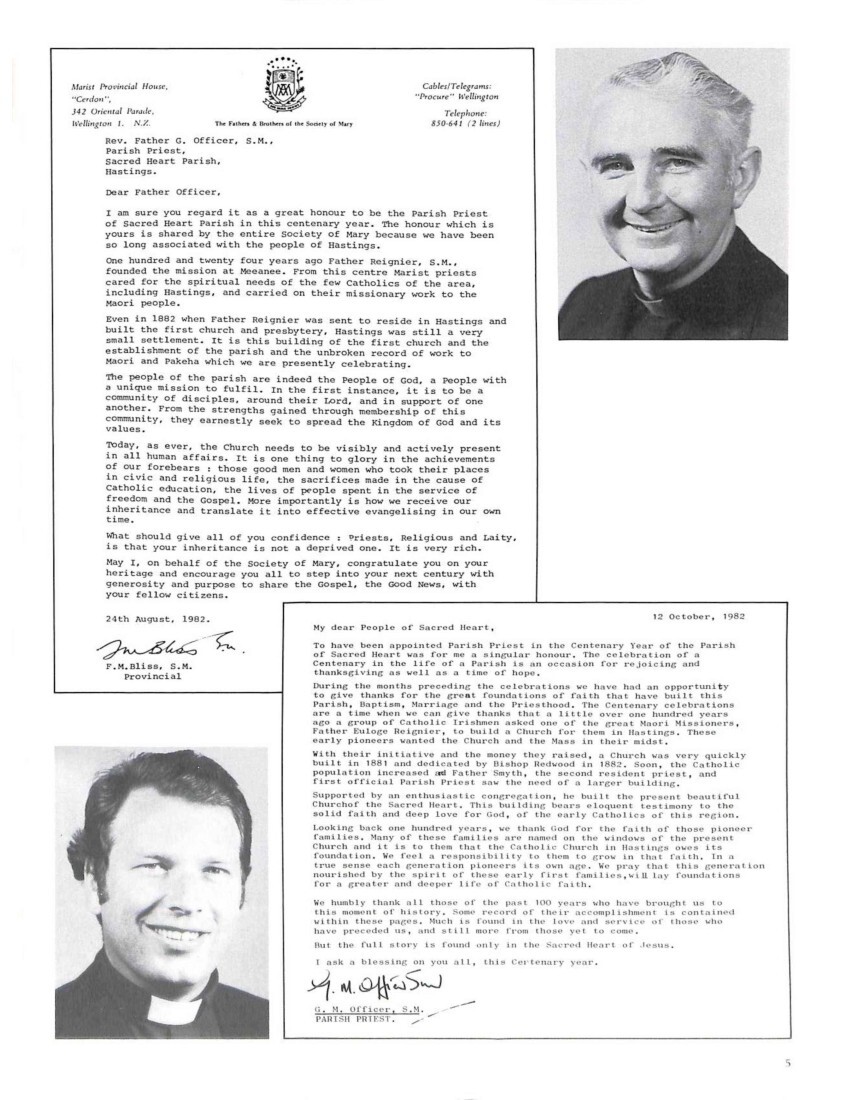
Page 7
Heretaunga St East, 1883.
HISTORY OF HASTINGS PARISH
In celebrating the official opening of the first Catholic Church in Hastings, 100 years ago, it is well to glance back over the beginnings of the Faith in Hawke’s Bay – the beginnings of which culminated in the establishment of the parish of Hastings.
Some time in 1840, a group of Maoris at Terekaka, Mahia, urged one of their leaders Tohi, to go to Bishop Pompallier, then in the Bay of Plenty, to ask him to send them a priest. There is evidence too, that in various Maori pas north and south of Ahuriri, the Catholic ‘karakia’ (prayers) were recited daily. In February 1841 Bishop Pompallier landed at Terekako from the ship ‘Sancta Maria’. There he celebrated the first Mass (as far as we know) in Hawke’s Bay. Later, on September 30th of the same year, Father Baty, S.M, was put ashore at Mahia, which became a centre of mission activity. Father Baty covered a great deal of the region, moving as far south as Wairoa where he offered Mass on December 19th, 1841.
When Wellington became a separate diocese from Auckland, Bishop Viard, S.M, wanted a permanent Maori Mission centre to be set up in Hawke’s Bay. Pakowhai was selected because, (a) there were Catholic converts of Pompallier and Baty already there, (b) it was a key centre of communications for tracks going north and south (c) the local chief, Puhara Hawaikirangi, was a Catholic and was ready to take the missionaries under his protection.
Father John Lampila, S.M. and two brothers Basil, S.M., and Florentin S.M., arrived at Pakowhai towards the end of 1850 and soon an organised Mission was established. Father Lampila was ordained a priest by Bishop Pompallier on Christmas Day, 1842, at Bay of Islands. He was the second priest to be ordained in New Zealand. Father Lampila moved to the Wanganui Mission in 1852. Father Euloge Reignier took his place and began his great work which has earned him the title of Apostle of Hawke’s Bay. His parish extended from Gisborne to Woodville and included Taupo and Waikaremoana, Karamu (Hastings), Havelock North, Waimarama, Meeanee, and all the villages north of Ahuriri were his nearer field of apostolate.
In 1858, after the death of Puhara in battle and the consequent surrender of the Pakowhai pa to the victor Karaitiana, the Catholic mission moved to Meeanee to an area of over 300 acres which had already been purchased by Reignier. In the 60’s and 70’s he made regular visits to Havelock North, less regularly it seems to Karamu, for it was thought that Havelock was to be the main town of the Heretaunga plains. Karamu (Hastings) was still mostly a mass of swamp and flax. Mass was celebrated at these visits and children were baptised. Earliest baptisms at Havelock of which we have record are:
Thomas Henry Marsh, May 15, 1863; infant girl Marsh (christian name not recorded) June 16 1865, John Cooper, June 10 1866; Mary Ann Monagan of Waimarama, 29 January 1867; Daniel Edwards of Waimarama, 13 October 1865; Robert Beder, 9 May 1867; Mary Ann Smith, 23 December 1867; Dora Cooper, 8 November 1868; William John Watkins, 19 July 1869; Mary Catherine Alley, 5 September 1869, Rebecca Sharp, 8 May 1870.
The first European baptisms at Karamu were Daniel Roe, 3 December 1871; Herbert Mary Roe, 14 December, 1873; William Wall, 4 June 1874; James Wall, 30 August 1875. The first baptism registered at Hastings as distinct from Karamu is Thomas Allan Vickers, 8 October 1876.
After Hastings had been set up as a town, and the railway from Napier reached it, the Catholics of Hastings asked for Mass at their own place. Sections were bought on 4 September 1879 with view to building a Church and money was collected to pay for the cost. During 1880, Mass was still fortnightly at Havelock, attended by the Hastings people. By September
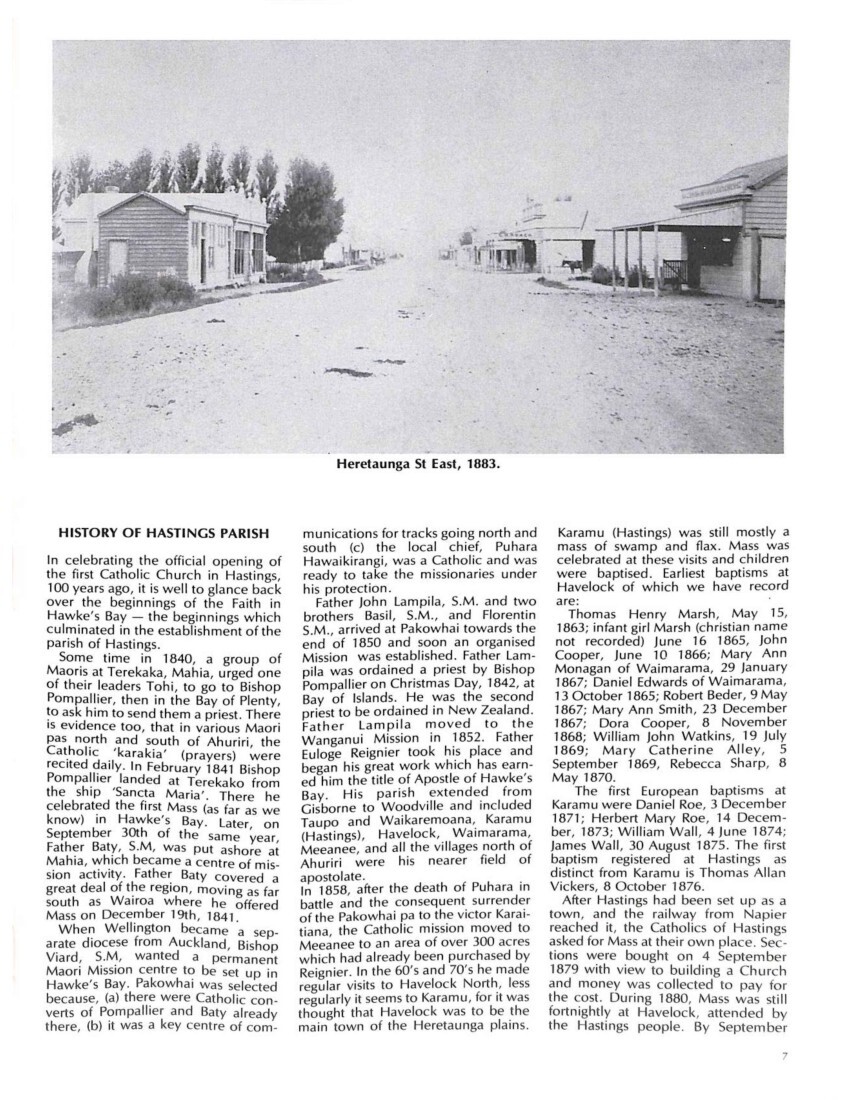
Page 8
1880 the collection for the Church amounted to $140, an architect Mr W. Dugleby was selected. He called for tenders, January 1881. The building of the Church was completed by the 2 October 1881, and Mass was celebrated in the Church of the Sacred Heart of Jesus. It was solemnly blessed an officially opened by Bishop Redwood on 16 April 1882. Father Sauzeau celebrated the Mass, with Brother Joseph of Meeanee acting as M.C. The Bishop preached eloquently on the theme “Grace and Faith”.
After the sermon, the Bishop administered the Sacrament of Confirmation to seven persons. They were Edwin Joseph Lawless, Patrick Donnelly, Annie Theresa Scanalon [Scanlan], Joseph Donnelly, Charles Donnelly, Emily Heeney, Mary Jane Donnelly. A choir from Napier assisted at the Mass and ceremony, Mr Holder presiding at the organ. The Bishop and priests subsequently dined at the Hastings Hotel, the guests of Mr J. Kelly.
Father Reignier came to reside in Hastings in 1882 and built a small two-roomed presbytery. In 1883 he was recalled to be in charge of the Meeanee Mission, and Hastings was left without a resident priest.
Photo caption – The first Sacred Heart Church in the original position on Heretaunga St. Built 1881.
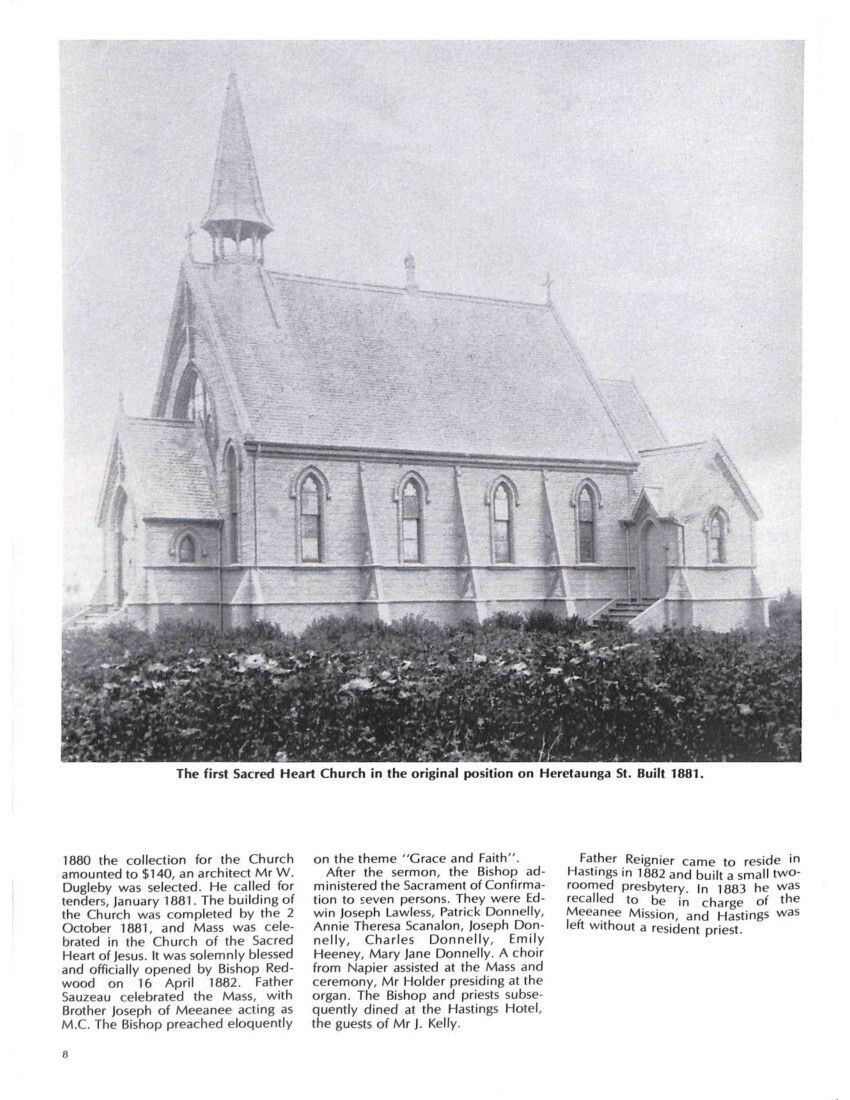
Page 9
Hastings
The Blessing of the Church of Hastings consecrated to the Sacred Heart of Jesus took place the 16 April 1882. His lordship Dr Redwood Bishop of Wellington performed the ceremony, assisted by the R.B.F.T. A Pangeau[?] and E Reignier in the presence of a congregation of two hundred. His Lordship delivered a very impressive Sermon. The Bishop administered the sacrament of confirmation to
1 Edwin Joseph Lollies[?]
2 Patrick Donnelly
3 Joseph Donnelly
4 Charles Donnelly
5 Annie Therese Scanlan
6 Emily Heaney
7 Mary Jane Donnelly
E Reignier […]
The description of the opening of the first Sacred Heart Church 1881, in Fr. Reignier’s own handwriting.
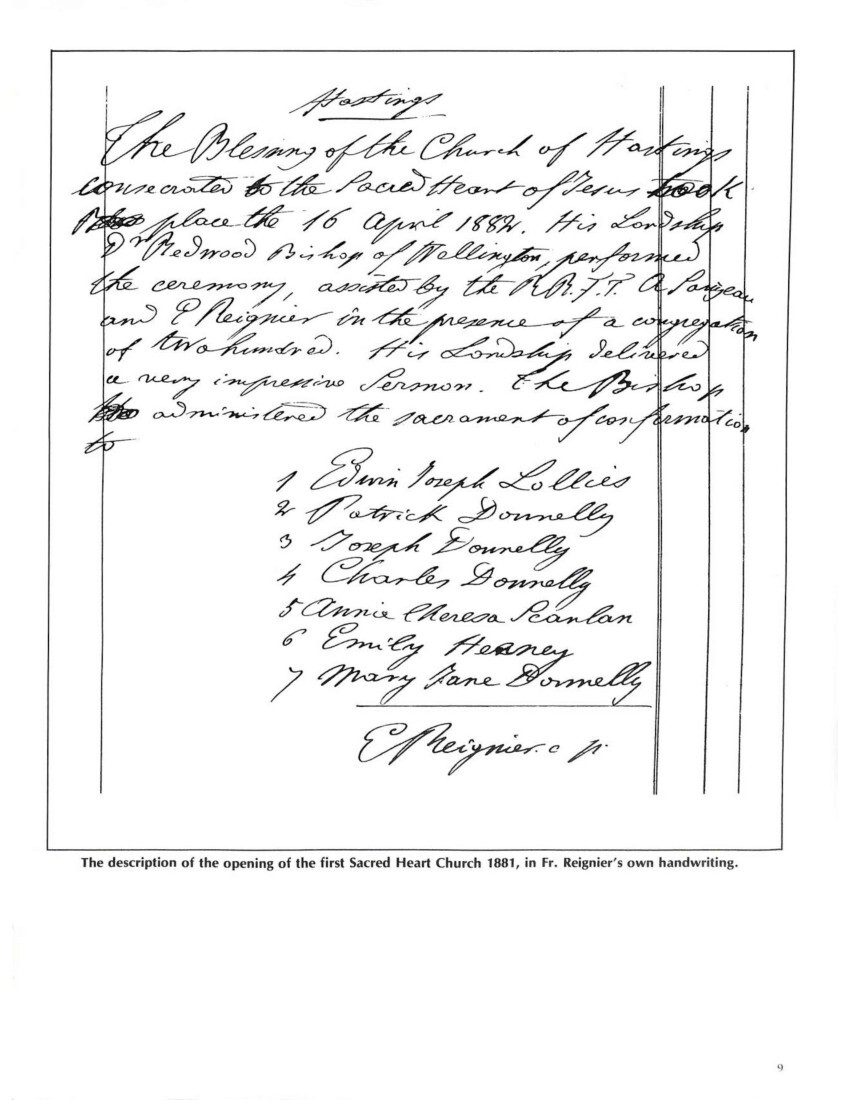
Page 10
FATHER EULOGE REIGNIER S.M.
FIRST RESIDENT PRIEST OF HASTINGS
“THE APOSTLE OF HAWKE’S BAY”
On a marble plaque in the Church of the Sacred Heart there is a list of names of priests who have served that Church well. We are asked to pray for them. At the head of the list is the name Father Euloge Reignier, S.M., as we celebrate the centennial of the Church which he began it is fitting to recall to mind who this man was, to appreciate with gratitude the fact the Euloge Reignier stood out as a giant among men, even among a group of great men. An imposing monument in the Taradale cemetery on the road to Puketapu marks the last resting place of the man who appeared to be always on the move, travelling great distances on foot or horse, bringing the ‘Good News’. Like this monument he still seems to tower over the assembly of great men who lie buried about him.
Father Reignier was born at Chateaubriand, France, in 1811. There was nothing spectacular about his boyhood or youth, apart from the fact that early in life he showed an interest in the priesthood. He was ordained as a secular priest on 20 December 1834. The reading of the Annals of the Propagation of the Faith aroused a keen desire in him to work in the new Vicarate of Western Oceania, recently established by Pope Gregory XVI. Western Oceania had been entrusted to the young Society of Mary, so he applied to become a member of it in 1839. He was professed as a Marist in September 1841 and sailed from London for New Zealand in November 1841, accompanied by Father Forest, S.M., and the Reverend Jean Lampila who was not yet ordained. They arrived at Wellington on 6 April 1842 and proceeded to the Bay of Islands.
From the Bay of Islands, Father Reignier went first to Opotiki, then to Rotorua. His zeal was unbounded and there was almost unlimited scope for his zeal. He found the Maoris eager to receive the Faith, his converts were abundant, and at times he had the joy of seeing more than a thousand Maoris at a time come to receive their Lord in Holy Communion. One of his best known converts was Te Heu Heu of the Tuwharetoa tribe, whose descendents [descendants] are still loyal Catholics in the Taupo area.
ARRIVAL IN PAKOWHAI
After a short time in Auckland when he instructed pioneer secular priests in the Maori apostolate, he went south, making a long trek on foot from Taupo to Pakowhai, with his few belongings on his back, sleeping in the open, depending for his food in the hospitality of the Maoris along the way. He arrived at Pakowhai in 1851, paused briefly, renewing acquaintance with Father Lampila, S.M., who had been ordained at Russell on Christmas Day 1842, by Bishop Pompallier. Business called him almost at once to Wellington,but he returned the same year on foot, swagging it through the Wairarapa.
From Pakowhai began his extraordinary apostolate in Hawke’s Bay, and apostolate which ranged over a vast mission parish, roughly 200 miles long and 150 miles wide, an apostolate which extended from 1851 till the year of his death, 1888. He became a well-known figure on the roads and tracks of the area, especially on the Napier-Taupo track, where he was the swagman extraordinary. In later times when he acquired his horse ‘Bob’, the two became a legend with Maori and pakeha. He was accepted by both, his courtesy and kindness endearing him to all. He regarded himself as a missionary for the Maoris, but his time and concern were at the disposal of pakeha as well as Maori. He baptised, married and buried early settlers all over his mission area, at Karamu (Hastings), Clive, Havelock, Meeanee, Napier, Wairoa, Waimarama, Waipawa, Waikaremoana and other places.
It comes as a surprise to learn that Father Reignier, in the very midst of a busy and successful missionary career, wanted to leave the Maori Missions and New Zealand. He wrote twice to the Rev. Father Colin the Founder and
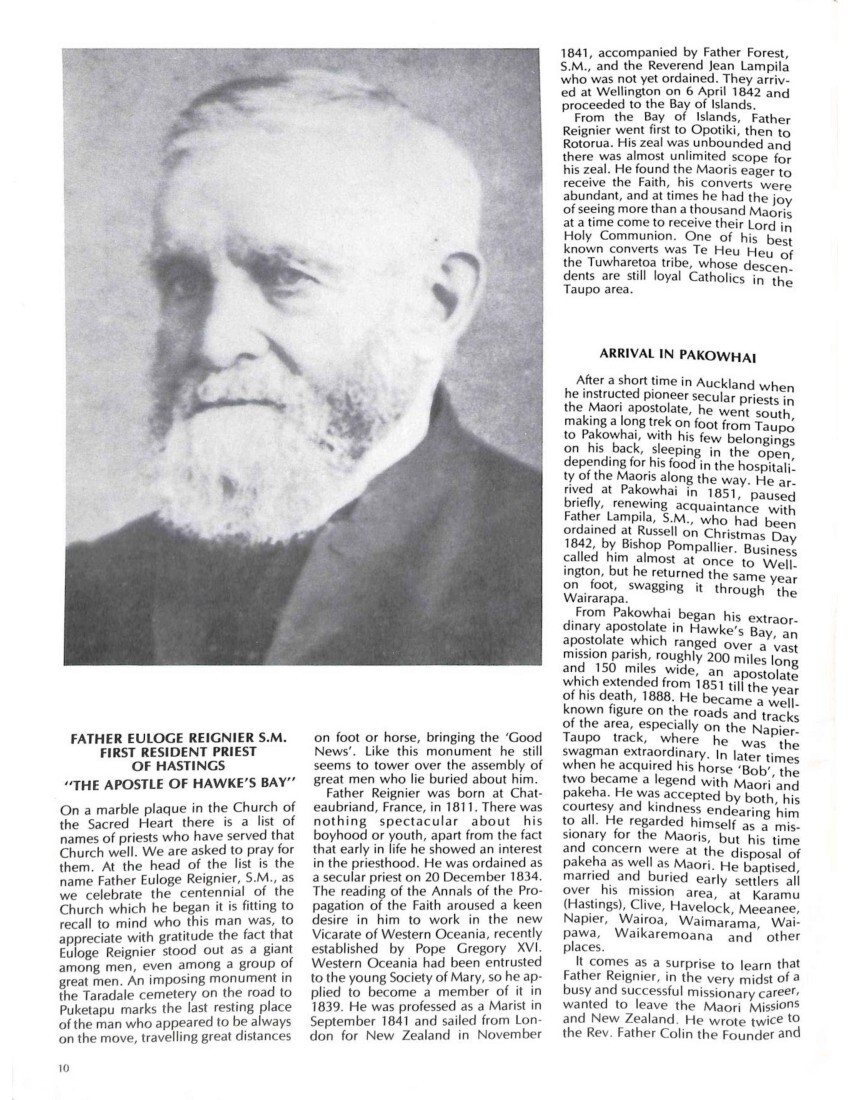
Page 11
First Superior General of the Society of Mary, asking to be released – without success. He wrote again to Father Favre who succeeded Father Colin, giving reasons why he should leave the Mission – isolation, the lack of spiritual help from brother priests, the fear of dying without the benefit of the Sacraments. He said that one needed to be an angel or a hermit to live in the way he was compelled to do. The strong, tireless, generous Reignier, who gave consolation to so many, was desperately in need of being consoled by others. This period was the ‘Dark Night’ of his mission career. Heroic apostles of other times and places have experienced that same kind of testing depression, which refines and makes even more beautiful an already sterling nature. This difficult time for Reignier ended when the region was struck by a typhoid epidemic in 1856. Father Reignier with others from the Meeanee Mission nursed the sick, comforted the dying, and buried the dead. The night of Reignier’s desolation was dissipated, and he was again completely committed to his adopted land of New Zealand, and to his dear Maori people. He would never see his ‘Belle France’ again.
TO MEEANEE
In 1858, as a result of tribal hostilities and of the death of its protector, Puhara Hawaikirangi, Father Reignier moved the mission centre from Pakowhai to Meeanee where land had been already acquired by Brother John. From Meeanee the apostle of Hawke’s Bay continued his work, tirelessly yet gently zealous. Yet another side to this apostolic zeal gradually comes into focus – his concern with education. He established Catholic primary schools in Napier (1859) and in Meeanee in 1862. In Napier the St. Joseph’s Providence for Maori girls was another of his enterprises; another was the Meeanee College for boys, which was one of the first Catholic secondary schools in New Zealand. He was keenly interested in the projected St. Patrick’s College in Wellington, selling some of the Meeanee property to make a donation for the building of that great college. He became interested in building permanent churches. In various parts of the Mission, he had built temporary Maori-style churches; but now he was responsible for more permanent church buildings – Napier (1859), Meeanee (1863), Waipawa (1874), Hastings (1881), Wairoa (1882).
IN HASTINGS
When the first Church of the Sacred Heart was blessed and officially opened by Bishop Redwood on 16 April 1882, Father Reignier resided in the first presbytery in 1882 and for part of 1883. It was then considered better for him healthwise to go back and live at Meeanee, although he still ministered to the needs of the people of Hastings and Havelock North. In this he was helped by a young Marist priest Father Lewis, soon to become the Parish Priest of Blenheim and then of Thorndon, where he was responsible for the building of the Basilica of the Sacred Heart.
In the latter part of 1879 Father Reignier was at death’s door and received the Last Sacraments. Sister Mary Joseph Aubert who nursed him through his sickness, lamented the passing of a great missionary. She was somewhat premature. He recovered and carried on his great work, in a more restricted area, it is true, but with the same great zeal. He ministered more and more to the increasing number of Europeans in the bay, which drew a complaint from Sister Mary Joseph that he was abandoning the Maoris, especially since he had become interested in schools. The criticism is a little harsh. Father Le Menant des Chesnais, who preached the panegyric for Father Reignier, pointed out that is was his love for the Maori children that made him build a Maori college; and that to get children to attend it, he would walk all over the province and bring them back by hand or on horseback. Education of Maori children was a priority with him.
Death came to the veteran missionary on 28 October 1888. He who had sighed at times to see fair France again, had closed his eyes to the wilder, more rugged beauty of a younger land. The Mass of Requiem was sung by a younger missionary Father le Pretre, who would be known as the Apostle of Wairoa. The body of the worn-out old priest lay in state in the Church till the Vespers of the Dead, sung by the combined choirs of Meeanee and Napier. Among the clergy were Dr. Watters, Rector of St Patrick’s College, and Fathers Sauzeau, Kerrigan, Yardin, and Grogan. Father Le Menant des Chesnais, Parish Priest of Hastings at the time, preached the panegyric. He said of Father Euloge Reignier, “No one can tell the good he has done. You have lost a true and faithful priest, whose name will ever live in the hearts of the Catholics of Hawke’s Bay.” The Napier Telegraph wrote, at the time of his death: “He was the beau ideal of a French gentleman and Catholic priest of the best type. It is men of the stamp of Father Reignier who are the real strength of the Catholic Church, for by their lives they show how the faith that is in them, not only ennobles them, but urges them on to a heroism second to none.”
The funeral cortege was impressive. After Vespers, the casket was carried on the shoulders of the men of the congregation, the hearse was not used. A great procession of carriages, and horsemen, and parishioners on foot moved along the straight Meeanee Road, accompanying their beloved priest to his last resting place.
An impressive tribute was paid by a colleague of Father Reignier. He wrote: “I was trying to explain to a prominent runholder in this district the grounds for acceptance of the Catholic Faith. I told him there were four marks – four means of identification – by which the Church might be recognised. He interrupted me and said: I knew Father Reignier; he will do for one; just give me the other three.”
Fr. Lampila, founder of the Pakowhai mission, 1850.

Page 12
PAKI PAKI
The Maori Mission at Paki Paki is part of the story of the growth of the Church in Hastings, and still forms part of the Hastings Parish. The resident Maori Missioners, Father R. McGowan and Father P. Brennan, S.M., are worthy successors to the outstanding men who are commemorated on the stone in front of the old Paki Paki Church.
In February, 1875, Bishop Redwood made a memorable visit to Paki Paki to meet the Catholic Maoris who lived there. He travelled by train from Napier on the line which had just been built. He was warmly received and promised to send them a resident priest when they built a Church and showed themselves worthy Catholics.
Thanks to the work of Father Soulas, S.M., and the vigorous assistance of Sister Mary Joseph, a Church was built, and on 8 June 1880 the Church was blessed and officially opened by Father Yardin, S.M. Sister Mary Joseph expressed her annoyance at the absence of Father Reignier on the occasion. The land on which the Church was built was donated by Urepene Puhara, the son of Puhara Hawaikirangi of Pakowhai, who had helped Fathers Lampila and Reignier to establish the Mission station at Pakowhai.
Bishop Redwood returned to Paki Paki on the afternoon of 16 April 1882, the day that the first church of the Sacred Heart was blessed and officially opened. The Bishop was accompanied by Father Sauzeau and Brother Joseph of Meeanee, their main intention was to administer the Sacrament of Confirmation. They were received by Father Soulas and a welcoming party of 80 Maoris. During the speeches, a Maori chief, Reuben by name, reminded the Bishop of his promise of a resident priest and of the good efforts of the Maoris to live the Catholic faith. Father Soulas built a presbytery and a school hall at Paki Paki. He went to Wanganui in 1883 and for a while there was no resident Maori Missioner, until the arrival of Father Le Pretre, who worked strenuously among the Maoris of Paki Paki, and in fact for the whole of Hawke’s Bay and the East Coast. In 1894 he became the Parish Priest of Wairoa, where his memory is still hallowed.
Freeman’s Journal of 21 April 1882 reported the above occasion: “After the speeches, Vespers are sung beautifully in Maori, then the Bishop baptised 9 convert Maoris and confirmed 22. Then Mr P. Moroney of the Paki Paki Hotel invited the Bishop and clergy to a dejeuner which was duly appreciated.”
In 1968 the old wooden Church was moved from its original site to make way for a new Church. This was opened on 28 April 1968.
Bishop Peter Cullinane of Palmerston North presided at special centenary celebrations on 8 June 1982. He first conducted a thanksgiving service in the old Church, then officially blessed and consecrated the new Church which had been opened in 1968, but had not been blessed by the Bishop. As the Hastings Parish celebrates its hundred years of faith, the Paki Paki Mission and its labourers will be remembered with joy and thanksgiving. One of those labourers who gave much to the Paki Paki Mission was Sister Mary Joseph (Mother Aubert) whose name is remembered in the name given to the Flaxmere Mission conducted by the Sisters of Compassion.
FR. JAMES RIORDAN S.M. 1929-42,
AND THESE OTHER BENEFACTORS OF THE MISSION
AGNES SHAW WILSON: AGNES MURPHY, ELIZA SHEEHAN: GEORGE OSWALD DONOVAN,
FATHER AUGUSTINE VENNING S.M. 1909-62.
Photo caption –
The first Paki Paki Church opened 1880.
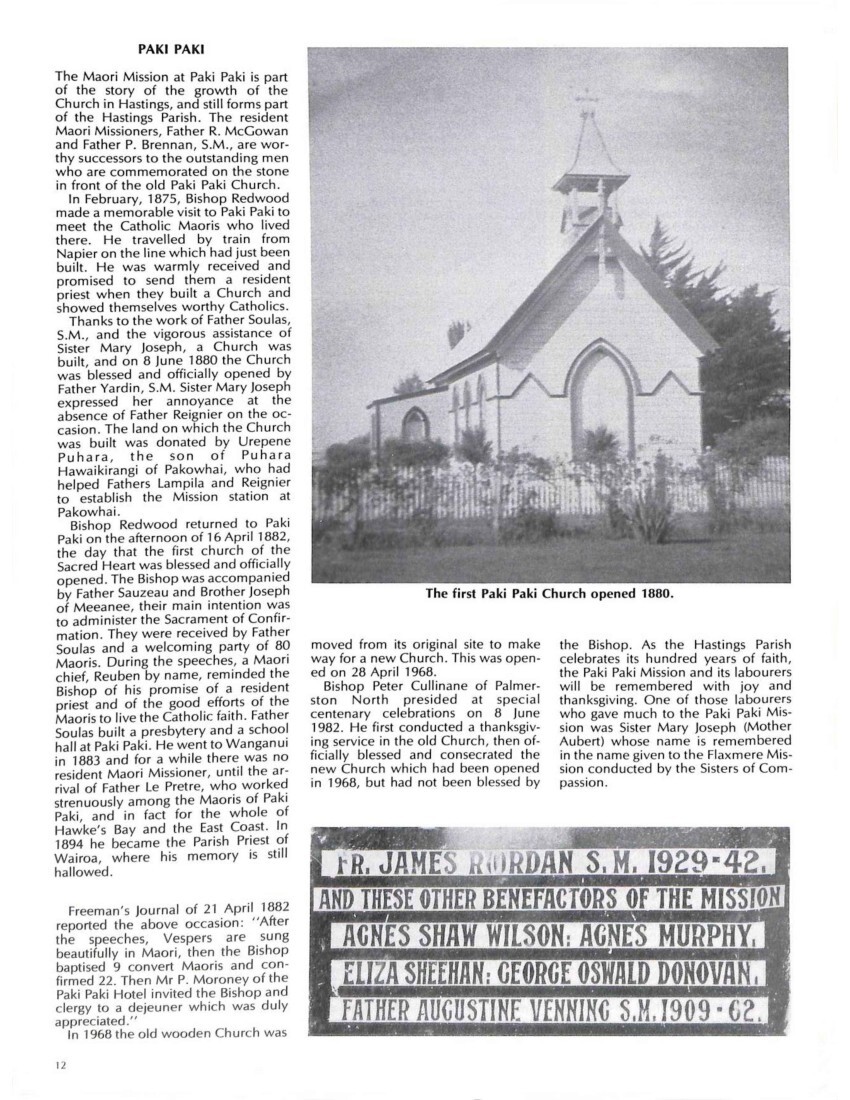
Page 13
Fr. Soulas, builder of the first church at Paki Paki and the first resident priest of the mission.
IN MEMORY OF
FATHERS: BATY, LAMPILA, REIGNER,
SOULAS, SEON, LE PRETRE, DE LACH
BROTHERS: BASIL, AND FLORENTIN,
OF THE SOCIETY OF MARY AND
MOTHER MARY AUBERT WHO LAID THE
FOUNDATIONS OF THE MAORI MISSION AND
INDEED TO THE CHURCH IN HAWKES BAY.
AND PUHARA, MAORI CHIEF, BENEFACTOR OF THE MISSION.
Memorial to the founders of the Paki Paki mission.
Catholic Marae at Paki Paki.
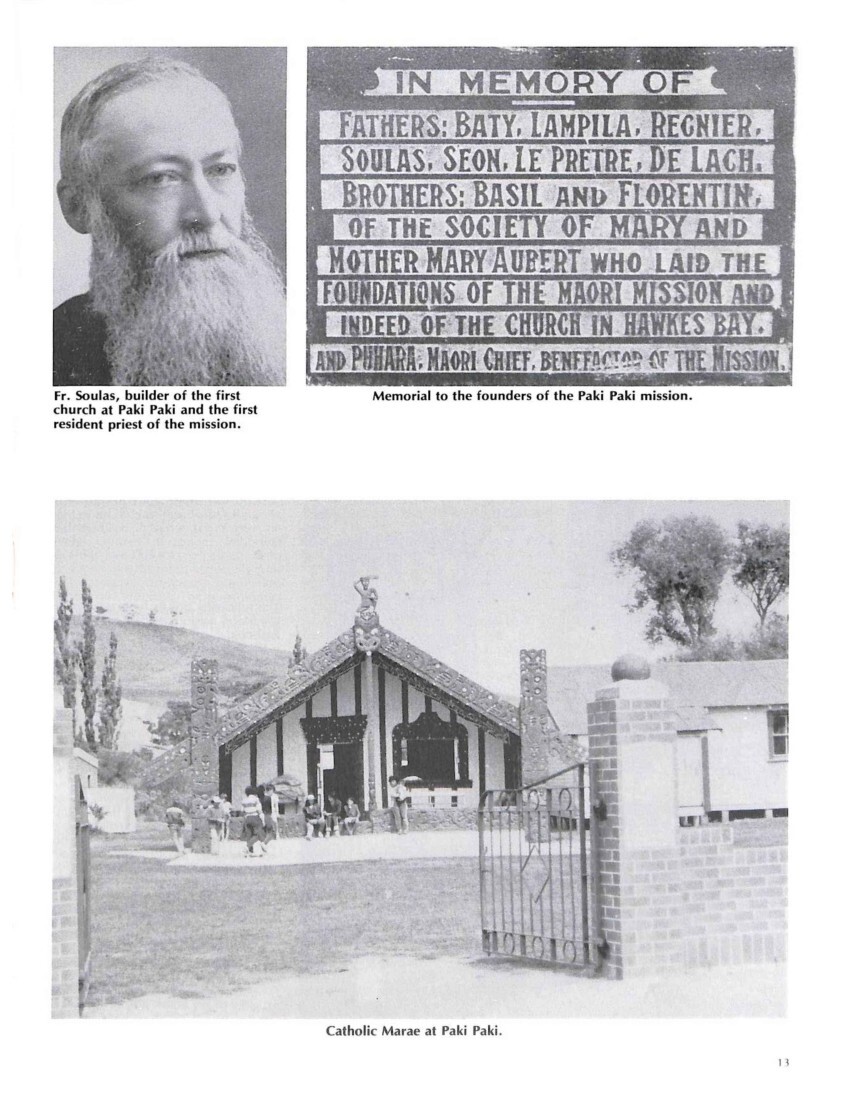
Page 14
The first church, resited.
The following priests have worked on the Maori Misions [Missions] at Paki Paki.
Fathers:
W. Te Awhitu.
P. Brennan.
J. Cahill.
M. Caulfield.
P. Cleary.
B. Condon.
J. Durning.
E. Eastwick.
R. Harwood.
T. Kerins.
F. De Lach.
R. McGowan.
J. McSherry.
P. Le Pretre.
E. Reignier.
J. Riordan.
C. Soulas.
A. Venning.
L. Whiting.
The new Church.
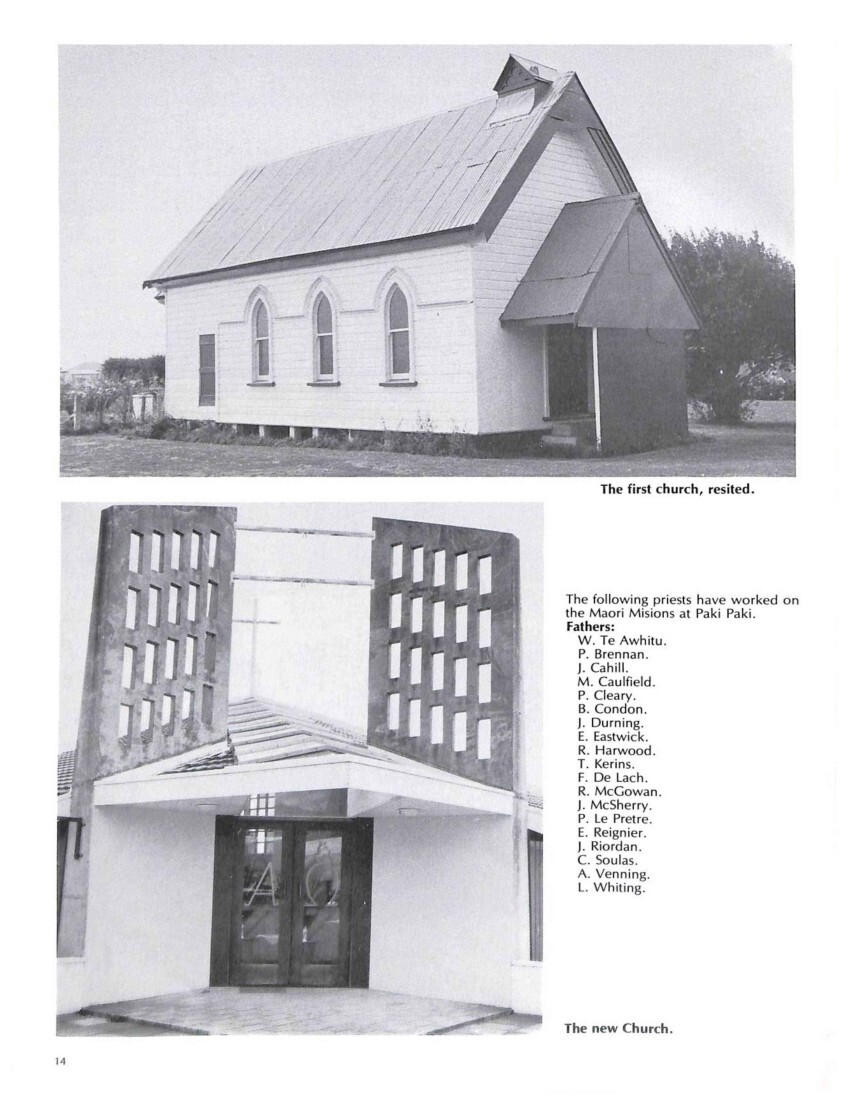
Page 15
FATHER P.J. SMYTH S.M. 1886-1901
The second name on the plaque in the Sacred Heart Church is Father P.J. Smyth, S.M., commonly known as ‘the Dean’. When Father Reignier was appointed in charge of Meeanee in the latter part of 1883, there was no resident priest in Hastings. Father Reignier endeavoured to serve about four different centres at once, including Hastings, but this was too much, even for a man like Reignier, especially with the growing European population throughout the Bay. The parishioners of Hastings were asking for a resident priest to care for their spiritual needs, and from the feeling of the Hibernian Society of the time, they were hoping for an Irish priest. Bishop Redwood on his return from overseas in 1885 gave them both a resident Parish Priest and an Irishman, in the person of Father P.J. Smyth, S.M.
Father Smyth (he liked to be called Smith) was a Limerick man, who did some of this theological studies at the Limerick Seminary, and completed them at the Marist Seminary of Belley, France. He was ordained at Dundalk, Ireland, and almost immediately went to the United States to teach at Jefferson College, which was conducted by the Marist Fathers, in Louisiana. In 1885 he accompaned [accompanied] Bishop Redwood who was returning from Europe and was on his way to the Council of Sydney, as assembly of the Bishops of Australia, New Zealand, and Oceania.
Towards the end of 1885 Father Smyth was appointed Parish Priest of Hastings. This was to be the main work of his life. He took up his duties at the beginning February, 1886.
One of his first works on coming to Hastings was to build a presbytery, which is the nucleus of the present, much altered presbytery. He built a hall on the Havelock side of the cottage which had been used as a presbytery by Father Reignier, and began arrangements for the establishing of a Catholic primary school. In 1888 he was away from Hastings, during which time Father Le Menant des Chesnais, S.M., was the acting Parish Priest. Father Le Menant’s name is the third name on the marble plaque in the Church. On 13 September 1888 the first Sisters of St. Joseph of Nazareth, four in number, arrived in Hastings. They were warmly welcomed by Father Le Menant des Chesnais. The school was blessed and officially opened by Bishop Grimes, S.M., of Christchurch, on 17 September 1888 although classes did not commence till the beginning of 1889. The school was called St. Patrick’s Primary School, although an old identity recalls that on a door of the school the words ‘Sacred Heart School’ were written. It is of interest that another large room or hall was built and used by the school. Later it was sold and became the Buffalo Hall in Warren Street.
The increasing number of Catholics in Hastings made it clear to Father Smyth that the existing Sacred Heart Church was not big enough, so he began to make plans for the building of another, of a more ambitious design. The architect he employed was Mr Sollitt of the firm of Sollitt and Allen. On 7 October 1894 Archbishop Redwood laid the foundation stone of a beautiful Church, the present Sacred Heart Church. This was Father Smyth’s finest achievement and a lasting monument to a man of great foresight and administrative skill. The tall, upsoaring tower is an ever-present memorial to the vision and drive of the Dean.
FATHER T. LE MENANT DES CHESNAIS, S.M., 1888
The third name on the marble plaque in the Church is that of Father Le Menant des Chesnais, S.M. He was appointed Parish Priest for the year 1888 in the temporary absence of Father Smyth. Father Le Menant was a prominent preacher and theologian. He wrote several books which found sale in Australia and America. He preached missions in Tasmania and the Australian mainland. Bishop Redwood appointed him to go through the diocese of Wellington to collect funds for the building of St. Patrick’s College, Wellington. While in Sydney he was appointed chaplain to the forces by Govenor [Governor] Loftus of New South Wales. Bishop Polding of Sydney appointed him as superior of the Sisters of Mercy in the diocese of Sydney. In 1885-86, he spent a year in America preaching missions and collecting for St. Patrick’s College. His year in Hastings was like a lull in a very busy career. An important event in that year was the welcoming of the Sisters of St. Joseph to Hastings, and the official opening of the Catholic Primary School.
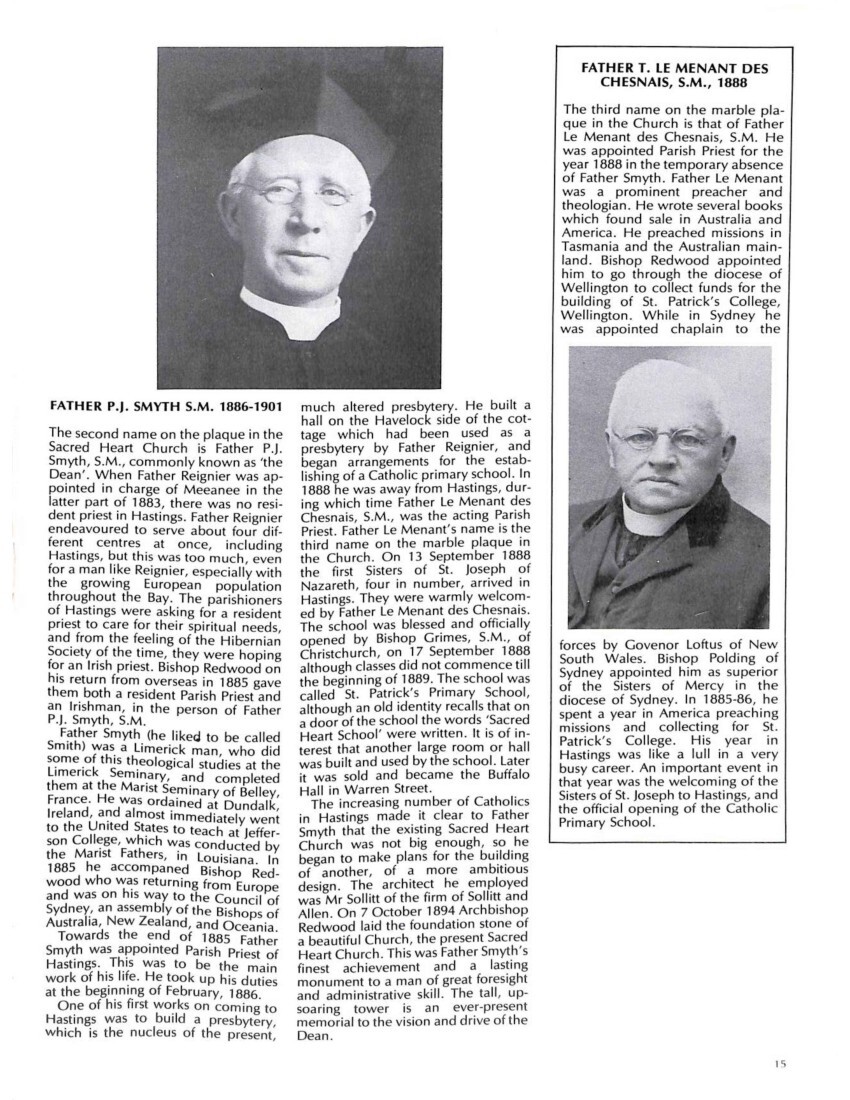
Page 16
WHAT THE LOCAL PAPERS SAID
Evening News and Hawke’s Bay Advertiser, 6 July, 1889.
“Great preparations are being made for the reception of Archbishop Redwood, this evening. The grounds of the Catholic presbytery will be tastefully illuminated and should the weather prove fine, the decorations will be very attractive. Evening News and Hawke’s Bay Advertiser, 9 July, 1889.
Concert given in honour of His Grace by the school children on Monday the 8th.
“His Grace rose and thanked the children for their kind address and the entertainment. You are right, he said, when you say that I take keen interest in your educational welfare. I hope you will always be thankful for your school and attend to the instruction given by the good nuns. They have dedicated their lives to you. I am delighted with the school which is a credit to the district. I hope it will soon be free of debt. Father Smyth has requested me to thank the band for its work on Saturday evening. Owing to the multitude of things on his mind, he forgot to do so.
“Many children took part in the concert on Saturday night. Master Vickers, the Misses Plummer and Maggie McNamara read addresses to the Archbishop, Misses Murphy and McNamara sang solos. Miss Benjamin sang ‘Kiss me Kate and I’ll go to sleep’.
“The Mayor Mr Murdock and Mrs Murdock were present.”
10th JULY 1889
Item: H.B. Herald, 10 July, 1889. A Hastings youth says that he always noticed that he can’t get a bit of dog’s meat from the butchers, after they have been making sausages.
Item, same day: The youngsters of the Catholic school have got a week’s holiday, as a reward for their labours in getting up a concert to entertain the Archbishop Redwood. H.B. HERALD: 23 July, 1889.
The Brass Band has received the following letter from the Rev. Father Smyth:
“Gentlemen, on the evening of the reception of Archbishop Redwood, I was so occupied, I did not have the opportunity of thanking you for coming to enhance the eclat of our ceremony. However I do so now, and I beg of you to see the enclosed cheque as a small token of recognition and gratitude. With kind regards and best wishes to the band.
Believe me etc.,
P.J. Smythe [Smyth] S.M.
Daily Telegraph, Monday, 8 October, 1894
The laying of the foundation stone of the new Catholic church in Hastings yesterday was an important local event.
The grounds everywhere were thronged with spectators of every creed. A covered dais was erected near the stone by the contractors Mackenzie and Perkins.
Bishop Redwood completed the laying with a silver trowel supplied by Mr A. McCorkindale. His Grace delivered an appropriate address which was listened to very attentively.
120 pounds in cash was given besides the following presents:
The high altar – 75 pounds.
The pulpit – 25 pounds
four stained glass windows – 25 pounds each
two stained glass windows – 12 pounds each
A turret bell with patent rotary gear is being specially imported from Dublin. This is the handsome present to the church from the parish priest, Father Smythe.
At the High Mass, Winter’s and Mozart’s High Masses were used and efficiently rendered by the choir.
The day was beautifully fine.
The Bishop preached morning and evening.
Trowel presented to Archbishop Redwood at the laying of the foundation stone of the present Sacred Heart Church, October 7th, 1894.
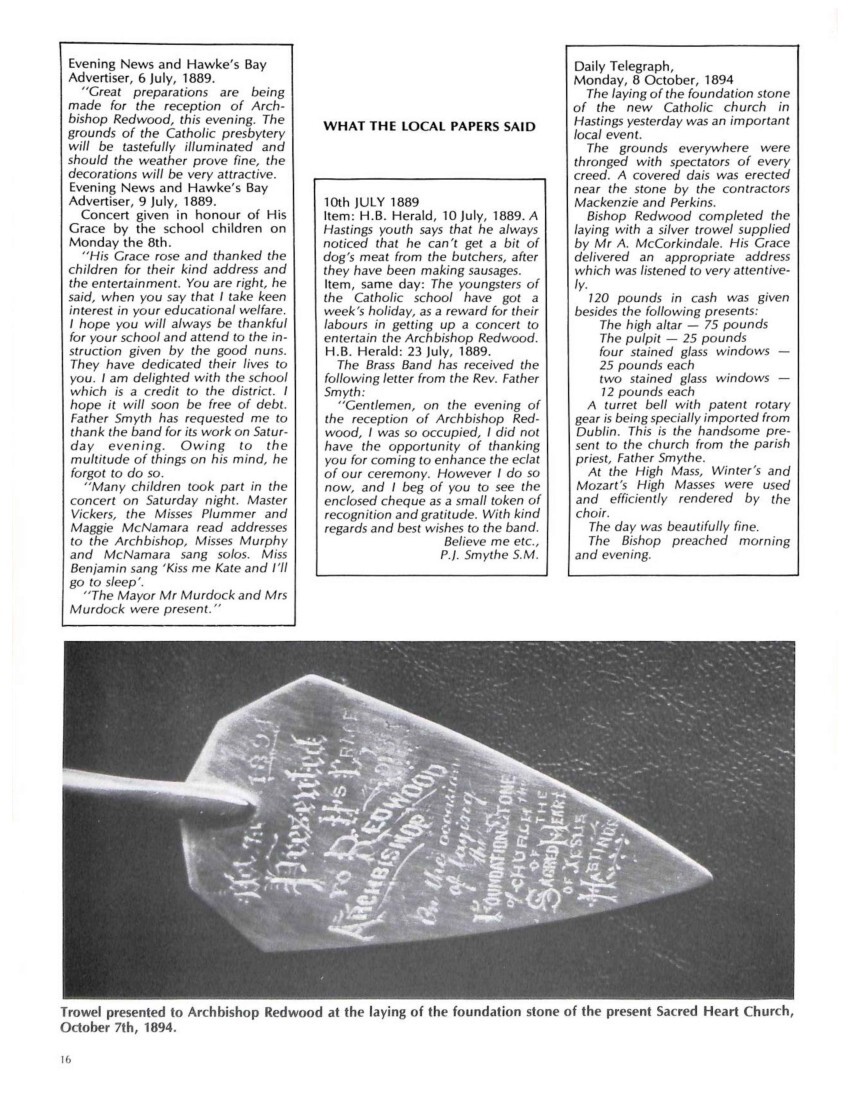
Page 18
In 1909 he was appointed Rector of the Seminary at Meeanee. The Society of Mary should always be grateful to him for the herculean task he took on of shifting the Seminary building at Meeanee from its flood-ridden position to its beautiful position at Greenmeadows. After a term as Rector of the Seminary he was appointed Provincial of the Society of Mary in New Zealand and went to the Provincial House in Wellington. After only a few years of wise administration of the New Zealand Province, death overtook him quietly. He died on 7th September 1916, in the 67th year of his age. He lies with a goodly number of his Marist confreres in the Marist plot at Karori.
A good story is told about the Dean on an occasion when he was hearing the confessions of the school children. One boy told the Dean he had stolen two ‘chooks’. “Who from?” asked the Dean. “From you Dean”. Whereupon the good Dean grabbed the boy out of the confessional and boxed his ears. It would be interesting to know how the story orginated [originated].
He realised the convent, which was the former cottage on the land bought from Mr T. Tanner, was inadequate, and built a new convent in 1901, on the site of the original cottage which had been used by Father Reignier as a Mass centre on odd occasions on his journeyings through his mission territory. He also built in 1908 the hall which after various renovations was to become the Premiere Hall.
Dean Smyth was a zealous pastor, appreciated in a special way for his eloquent sermons. He visited the school frequently, held catechism classes regularly, demanding a high standard of knowledge in these classes. He encouraged the various organisations in the parish, especially the Hibernian Society, the Children of Mary, the Altar Society, and the Rosary Society. He visited the parish constantly, and was a well-known figure in his horse and buggy or on his bicycle. Father Smyth was proud of the Church bell, which he himself donated to the Church, and it was considered a privilege to ring it.
Liturgical ceremonies and Church music were dear to Father Smyth. Whenever Archbishop Redwood came to the parish it was a time for grand ceremonial receptions, addresses of welcome, and multicoloured lights and decorations in and around the Church. The Archbishop would be escorted from the station to the presbytery by parishioners in carriages or on horseback. The Dean himself drove the prelate proudly in his flash gig, equal to the best in town and better than most. The Bishop and he in their top hats and long frock coats were an impressive pair. He was very proud of his best vestments and used any excuse to wear them. He was proud of his choir and had good reason to be, judging by the impressive programmes that the choir attempted. But the Dean could show his displeasure in a forthright fashion. On one occasion, when the choir at Benediction ventured badly upon a little known Tantum Ergo in three parts, the good Father exclaimed “Oh laws, Oh laws, what is happening!” Then he went to the altar rails clapped his hands and cried out, “The choir will please stop that nonsense, and sing something that they know.”
The Dean was an ardent admirer of Richard John Seddon. When Seddon died Father Smyth draped the Church in black, wrapping bands of black material around the pillars of the Church, and sang a Requiem Mass for repose of the soul of the great Prime Minister.
He had a great love for the children of the parish, caring deeply for their religious and secular education. This led him into long newspaper controversy with those who did not share his ideas about State aid for Catholic school children. The present set-up in New Zealand would probably contribute to the greater happiness of the Dean in Heaven. Father Smyth had a great ability in organising bazaars, socials, concerts and in other ways of gathering funds to pay off parish debts. He had a very friendly association with the non-catholics of Hastings who were generous in subscribing to his many ventures, and in helping to pay ff the debt of 3300 pounds for the cost of the new Sacred Heart Church. As an excellent judge of good horses, he had very good friends among the horse owners and breeders of the day.
Early altar boys: The Poppelwell brothers from left: George, Harry, Frank, Bert and Guy in 1909; and in 1890, Frank and William Kelly.
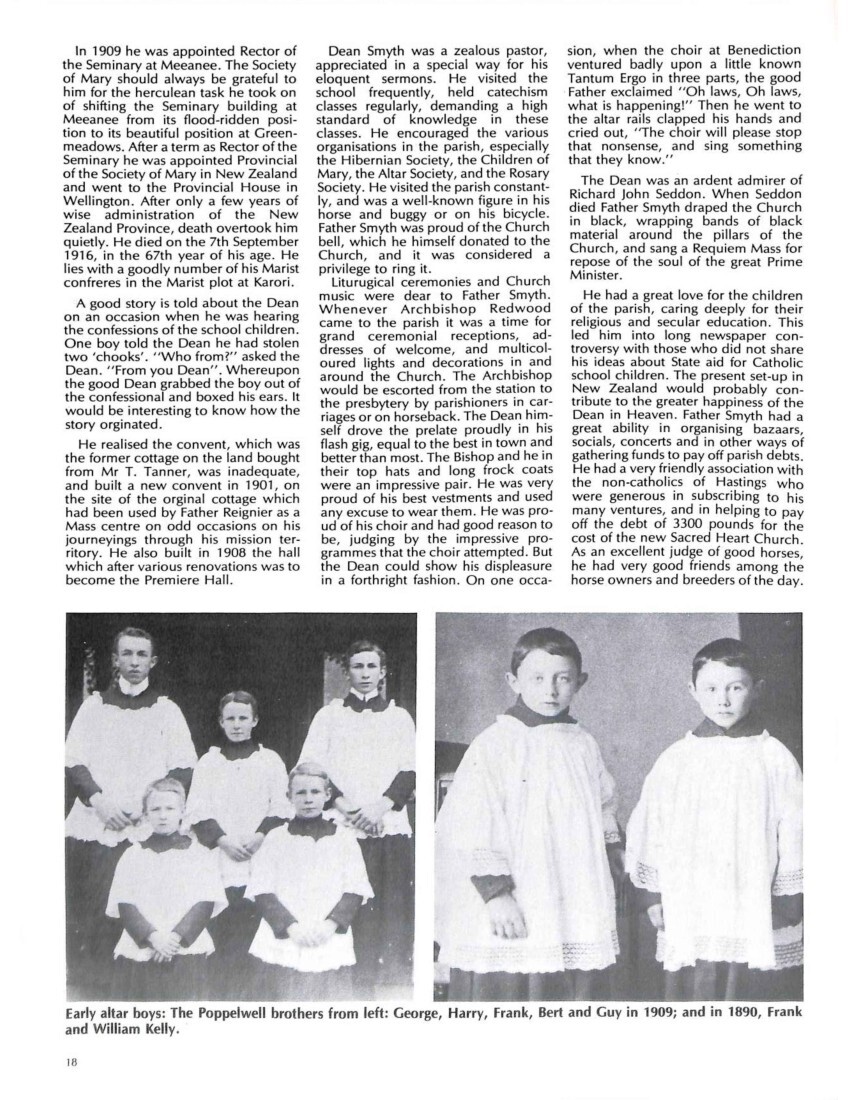
Page 19
Hastings October 3rd 1895.
To the
Reverend P. Smyth S.M.
Dear Father,
We the parishioners of Hastings desire to welcome you, on your return from a well earned rest, and trust the change has been beneficial to your health, and that you may be spared for many years to labour for our spiritual welfare.
Requesting your acceptance of this and the small token of our gratitude and esteem which accompanies it.
Asking your blessing and prayers for our future happiness, we beg to subscribe ourselves. ???
Aldridge I[?]
Ahern Mr[?]
Barry J[?]
Black [?]
Blake [?]
Blake [?]
Burns J
Begley Mr
Brady Mr[?]
Carroll J
Carroll Jne[?]
Casey J
Cassin J. H.[?]
Collins J.
Collinge J.
Conway Miss.
Conway W.
Coghlan J
Coghlan Mrs
Cox P.
Cummins D.
Cullen J.
Crowley D.
Clabby M.
Coe J.
Dennett W Y
Downes P.
Duigan J
Duigan W
Donnelly J
Donnelly C
Donnelly C Jun [?]
Donovan M.
Dean J.
Downey P.
Edwards. Miss
Elwood J.P.
French E.
Fitzgerald J.
Foster J. J.
Gilligan H
Gorman P.
Gillhooly M.
Gallagher C,
Hamill T.
Hassett J.
Hatton J
Hickey J
Hughes C.
Brandon M
McCarthy D.
Ellis Mrs G.
Howard Miss.
Hurley L.
Kearns M.
Kelly J.
Kelley J.
Kelley J.
Keys J.
Long Miss
Long P.
Lelievre A
Loughnan C. C.
Loughnan J. H.
Malone J.
McCarthy J.
McCarthy P.
McCarthy M.
McGlone J.
McHardy M.
McCleare P.
McKay Mrs[?]
McIlroy J. L.[?]
McIvor J.E.
McMahon P.
Moynihan ?.
Mahoney J.
Mitchell A. J.
Moroney D.
Moroney W.
Moriarty E.
O’Donnell P.
O’Brien W. B.
O’Halleron Miss
O’Neil C.
O’Neil N.
O’Neil J.
O’Reilly D.
O’Shea J.
Rodgers T.[?]
Ryan J.
Scullion H.
Shaw R.
Sheath M.[?] P.
Skerritt P.
Stack J. W.
Sullivan M.
Sharp T[?]
Seed T.[?]
Tully M. C.
Vickers G.
White D.
Windle P.
Quinlivan T.
McNamara P.
C.O. CLARKE. ILLUMINATOR. TOMOANA. H.B.

Page 20
Father Augustine Keogh S.M., third resident priest of Sacred Heart parish. Some boys referred to the original of this photo as “a picture of Henry VIII.”
FATHER AUGUSTINE KEOGH S.M.
A very distinguished scholar and educationalist was the third Parish Priest of Hastings, Father Augustine Keogh, S.M., B.A. He was Dublin born and educated in Marist colleges in Dublin, Dundalk, and France. He was an honours graduate of the Royal University of Ireland. He was born on 25 August on the eve of the Donnybrook Fair of 1858. Twenty five years later at his Silver Jubilee in Wellington, in replying to his toast, he said that his birthday was a momentous day for Ireland, for the Donnybrook Fair that followed his birth was the most furious and violent fair that had ever been held in Donnybrook, which is saying something, and it led to a vice-regal ruling that no more fairs were ever to be held at Donnybrook. No more fairs were ever held there.
After his ordination, he was appointed to the staff of his old school, St. Mary’s, Dundalk, and before long was appointed as Rector of the college. His health failed him, and for almost a year he rested in a Marist House at Paignton, Devonshire. From there he was appointed Rector of St. Patrick’s College, Wellington, which he guided in a distinguished fashion from 1901 to 1909.
In the latter part of 1909 he was appointed Parish Priest of Hastings, and the characteristics he showed at college were in evidence in his administration of the Parish of the Sacred Heart. He was a strict disciplinarian, but had a lively sense of humour which bubbled out of him frequently. He was intensely interested in education taking a personal interest in all the young people of the parish.
When Father Keogh arrived at the Hastings Presbytery some of the youth of the parish went to meet him and help him to settle in. He proudly showed the boys a large painting of himself in a professor’s cap and gown. He asked them whom they thought it was. One of the boys, Stafford O’Neill said, “It is Henry the Eighth, Father”. Father was taken aback. It was a painting presented to him by the citizens of Wellington in recognition of his civic activities. In fact there was a resemblance which perhaps had escaped him. When he had hung the picture over the mantelpiece to his satisfaction, he turned again to the boys and asked, “Now, what do you think of that?” O’Neill again chirped up, “Pretty decent, Father.” Looking around with pretended indignation, Father Keogh said, “Well, what would you expect? You wouldn’t expect anything indecent in a priest’s house, would you?”
Father Keogh was a clear, impressive preacher, always well prepared. Many of his sermons had more than a dash of picturesque Irish sentiment in them. At funerals he was inclined to become quite emotional, especially at the funerals of his Irish compatriots, when he would speak of the faith and devotion which the Irish pioneers brought to New Zealand from the green hills of Kerry. He loved company and he loved to entertain. He was a brilliant conversationalist and his Irish wit gave sparkle to any company. A musician of no mean ability, he sang well, and was an accomplished pianist and organist. He delighted in singing High Mass and often played the organ in the Church when the usual organist was not available. He enjoyed this and liked to improvise upon popular old tunes such as “Come into the garden Maud” and make them sound like some new hymn tune.
At the beginning of Father Keogh’s residence in Hastings he used a horse and buggy to do his visiting of the parishioners, a work which was one of his main interests. At the beginning he was not a good driver and liked to drive on the wrong side of the road, which sometimes terrified his youthful passengers who often accompanied him on his visits to look after the horse when Father was engaged. Later he was provided with a small two-seater Hillman car which had just appeared on the market. There was no shortage of volunteer drivers from among the senior boys of St. Patrick’s school. He took upon himself the work of punishing the boys of the school for their misdeeds. He reckoned that caning big boys was an undignified occupation for ladies.
So he spared the nuns but not the boys. He established a group of military cadets among the senior boys of St. Patrick’s primary. They wore a green khaki uniform, were frequently inspected by the Parish Priest, and woe betide the boy who came on parade with buttons undone or boots unpolished. The ‘troops’ took part with other organisations of the parish on ceremonial occasions such as procession of the Blessed Sacrament.
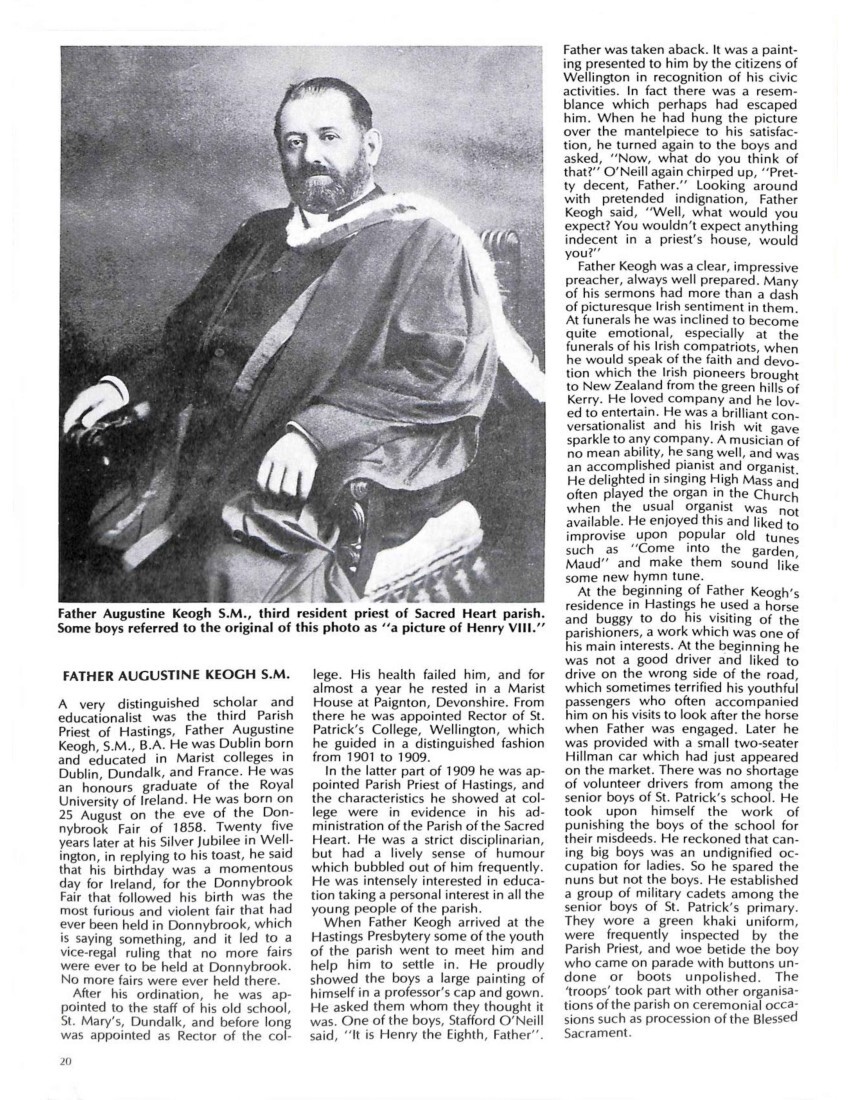
Page 21
A moment that remained imprinted upon the memories of the older parishioners was a certain night, in the gas-lit Church, when Father Keogh solemnly announced to his people that Britain had declared war on Germany. He predicted that the war would be long, terrible and devastating.
Father Keogh brought his elderly mother to live with him at Hastings. He treated her with a deep affection, akin to reverence. Nothing was too good for her. With the generous help of his parishioners he gave her all the loving care a son could give to his mother. She died in 1913.
In 1914 Father Keogh’s health had deteriorated and he was replaced at the beginning of 1915 by Father Hugh McDonnell. He returned to St. Patrick’s College on light duties but this proved too much for him and retired to Mount St. Mary’s, Greenmeadows, to recuperate. After convalescing there for a while he asked to be transferred to his beloved Hastings. There, at Nurse O’Callaghan’s private hospital in Avenue Road, his life came to an end shortly after midnight on 14 August 1917.
His funeral was a splendid affair, if the expression may be used. The open coffin lay before the high altar of the Church he had served so well, hundreds of parishioners came to view the body of the Parish Priest who had been such a dynamic element in the life of the parish. The Mass of Requiem was sung by the students from the Seminary. The panegyric was preached by the Rev. Dr. Kennedy, S.M., the third rector of St Patrick’s College. His text, very fitting for the occasion, was “Those who instruct others unto justice will shine like stars for all eternity.” After the Mass, the funeral procession, at least half a mile in length, moved down Heretaunga St. Behind the horse-drawn hearse. Many people lined the streets, and the shops on Heretaunga Street remained closed as the cortege passed down the main street. In the Hastings cemetery he was buried beside his mother, whom he had loved so dearly in life. Even in death he did not want to be separated from her.
Photo captions –
Convent school girls 1909
Left to right: Carl Lee, Gregory Lee, Mrs Kath Johnston, Mrs Alice McMillan, Mrs Nell Pierce, Mrs Sarah Begley, Miss Margaret Allison, Miss Nettie Reston, Mrs May Fennessey, Sister Borgia (1st day pupil and 1st vocation), Mrs Mina Harrison, John Allison, Mrs Jessie O’Donoghue.
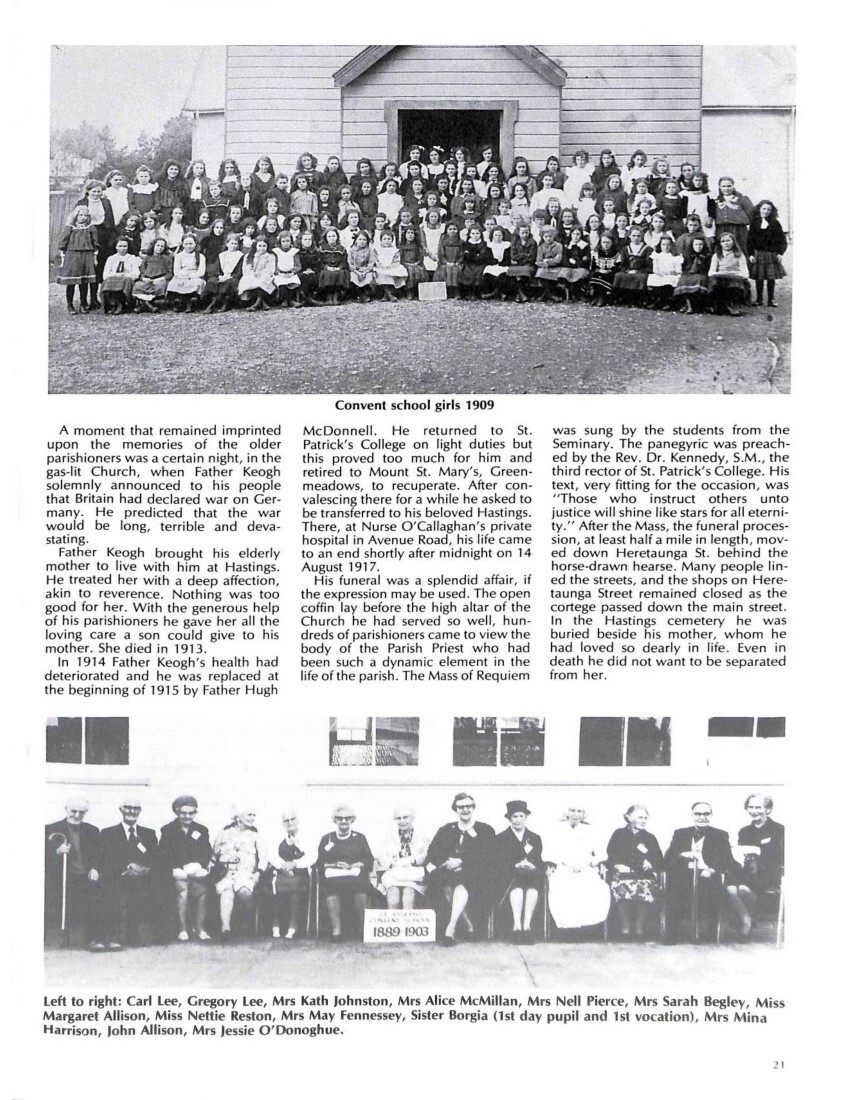
Page 22
To
Very Reverend
Father Keogh SM
Very Rev’d and dear Father,
We have heard with sincere regret of your approaching departure from the pastoral charge of Hastings, where you have ministered to our parochial needs for the past five and a half years.
We cannot allow you to go from us without giving expression to our gratitude for the valuable services you have rendered to the church, to us.
By your genial and kindly manner you have endeared yourself not only to the members own flock, but you have moreover gained a host of admirers amongst those who are not of the fold.
We are deeply grateful for the untiring zeal you have displayed in our spiritual welfare.
That your efforts in this direction have
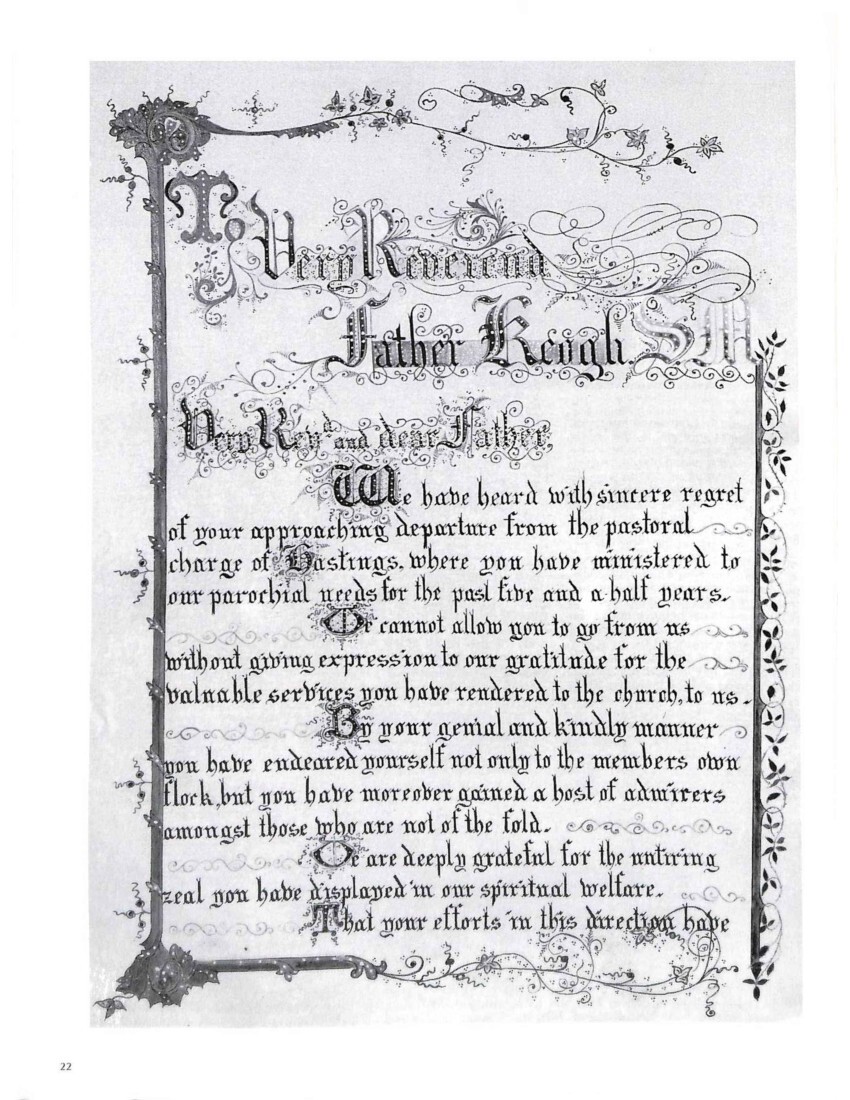
Page 23
been appreciated is evidenced by the ever increasing church attendance and the marked increase in the number of those who receive the Sacraments frequently.
Both in the pulpit and the press you have proved yourself a worthy and fearless champion of the Church. Your scholarly and lucid exposition of the doctrines of our holy Faith have made on us a deep, and we hope, lasting impression. When occasion demanded you were ever ready to place before the press reading public the Church in her proper light and to pillory those who would try to besmirch her fair fame.
The Catholic Federation owes you a debt of gratitude for the interest you have taken in its work and for those timely lectures on the war and its true lessons.
In the cause of Catholic Education you have shown an intense practical interest. The proud position now held by our Primary Schools, second to none in the district, is largely due to your praiseworthy efforts.
The sick and afflicted of the parish hold you in grateful remembrance for your generous constant attendance on them and your kindly sympathy extended to them in times of sore trial.
In conclusion we wish you every success in your new sphere of action and ask you to accept the accompanying gifts as a slight token of our gratitude and esteem.
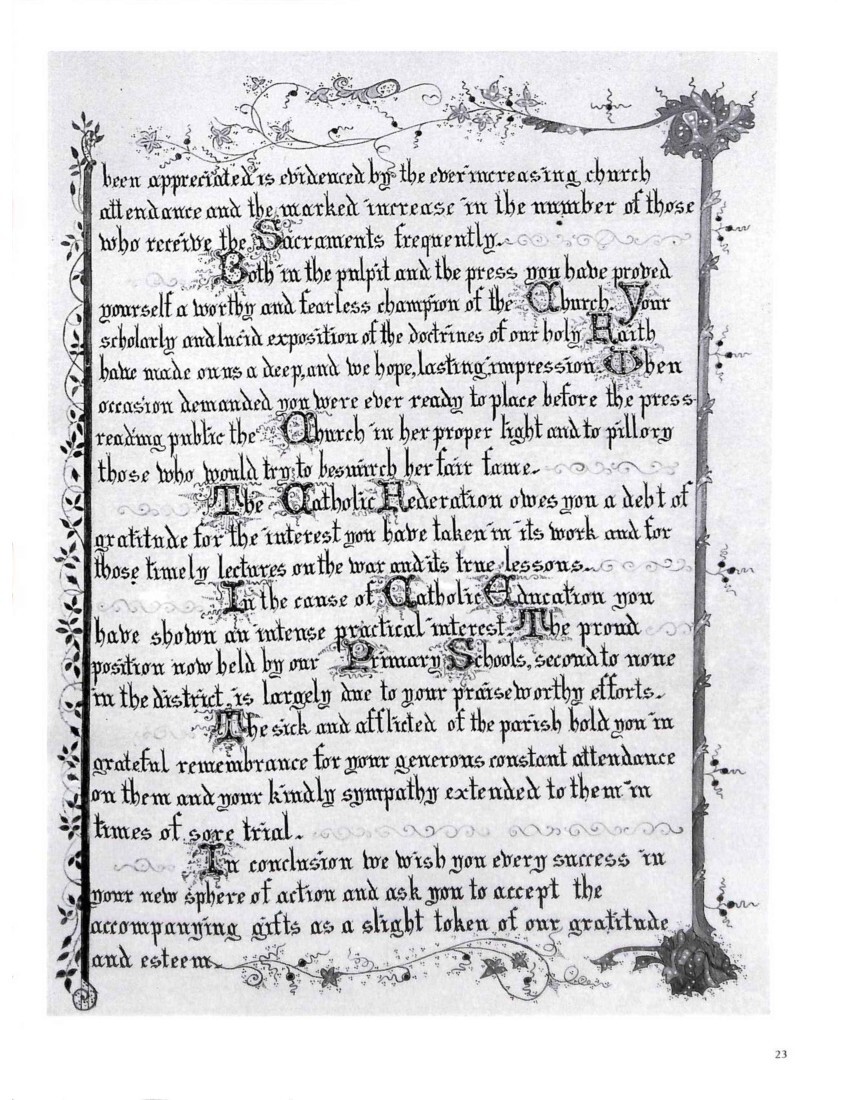
Page 24
Hibernians
First Row (Left to right): J. McCarthy, D. Wallace, -, P. McCormick, W. O’Donoghue, T. Downing, Dean Smyth, T. Kennedy, G. O’Shea, P. Maggin, P. McGahan, T. O’Connor, T. Scanlon.
Second Row: M. Carney, J. Flynn, T. Aldridge, J. Maggin, -, J. Good, D. McNamara, -, -, -, – Richards, J. Carroll, P. McCarthy, A. Downey, P. O’Kane, T. Sullivan, -, -, J. Donnelly.
Third Row: W. Beck, J. Begley, P. Nihill, F. King, -, P. Carroll, W. Allison, J. Fitzgerald, J. Donovan, -.
THE HIBERNIAN SOCIETY
St Joseph’s Branch 172, Hastings, of the Hibernian Society (commonly known as the Hibernian Society), has had an interesting history in the Hastings Parish.
It was shortly after 1880 that efforts were made by some enthusiastic Hastings Irish parishioners to establish a branch, but despite these efforts, it was not until 5 October 1884 that a preliminary meeting, chaired by the Hastings Parish Priest, Father Reignier, S.M., was held in Kelly’s Hotel, later known as the Hastings Hotel. The temporary secretary for the meeting was Mr W.A. Shanly. A minute from the meeting is worth recording. It was proposed by Mr Quin, seconded by Mr Hughes “That it is advisable to start a branch of the H.A.C.B.S. in Hastings”. Carried unanimously. This historic meeting closed with a vote of thanks to Mr Kelly for the use of the hotel room.
Another important meeting was held at Mr Shanly’s house on 25 October 1884. Among recommendations made were: (1) That a branch of the H.A.C.B.S. be formed in Hastings; (2) That it be called St. Joseph’s branch; (3) That the Napier Branch forward the application to the Executive Directory in Melbourne; (4) That meetings be held fortnightly in the Oddfellows Hall. Further, the secretary was directed to write to Bishop Redwood asking for a chaplain. Before long the Executive in Melbourne was to disapprove of the meeting place and asked that another venue be arranged.
The official opening of the branch took place on 3 January 1885. Present was a full delegation of the Napier officers of the H.A.C.B.S., including Br. J.A. Rearden, who was appointed by the Executive in Melbourne to open the Hastings Branch. Mr Rearden read out his authority from Melbourne, dated 8 December 1884. Hastings members were then elected and officially welcomed into the H.A.C.B.S.
The first officers of the branch should be recalled: Charles Hughes, President; John O’Brien, V. President; W.A. Shanly, Secretary; John Collinge, Treasurer; D.M. McNamara, Warden; Edmund O’Donohue, Guardian. The first chaplain appointed was Father Lewis, S.M., the assistant to Father Reignier. However, in the same year, Father Lewis was appointed Parish Priest of Blenheim. Father Reignier’s words to the H.A.C.B.S. on the departure of Father Lewis are quite touching, and give us a picture of the grand old Apostle of Hawke’s Bay now burdened with the years. He said he was aware that they had been much disappointed by the removal of Father Lewis and he sympathised deeply with them. The loss to him was as much as it was to the branch. He was pious, gentle and energetic. He (Father Reignier) regretted the need for the
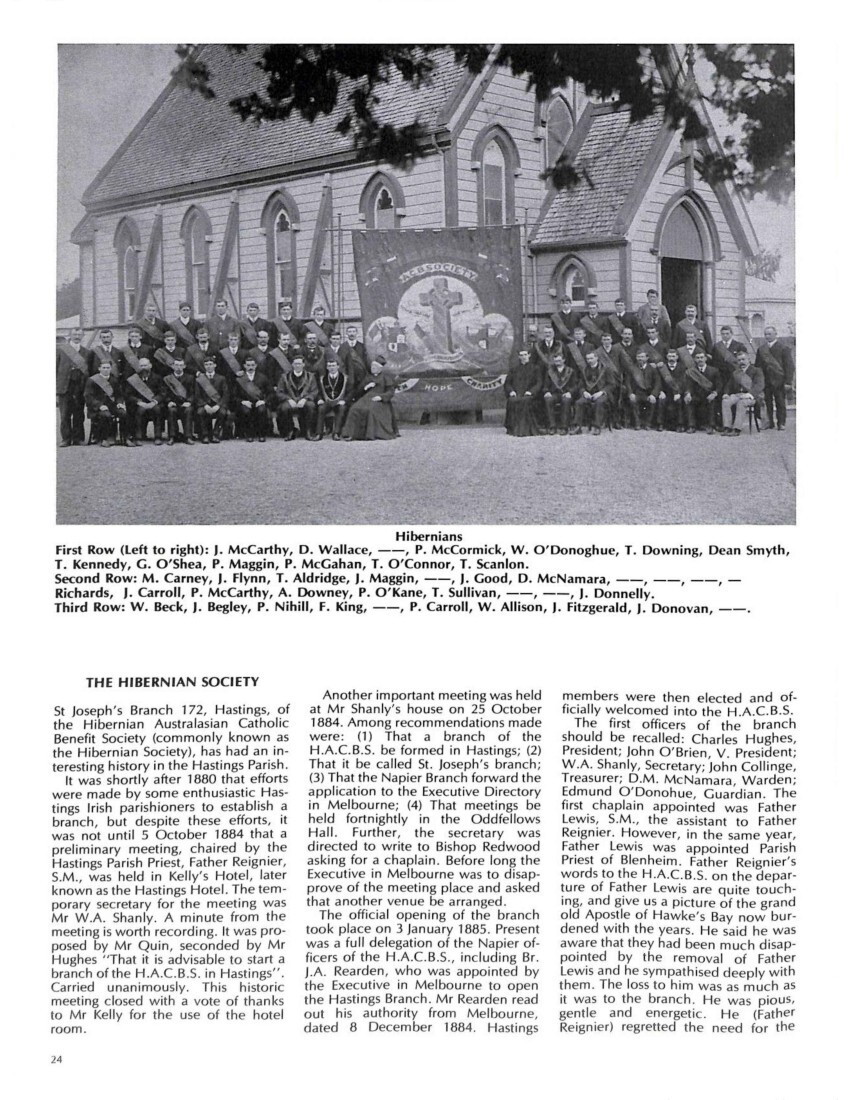
Page 25
change. The infirmities of age prevented his attending the meetings, but he wished them every success. He asked their forbearance with him, for he had been more than 50 years in the priesthood and was growing too old for his numerous duties. He was glad to inform them that the active work of the Mission would be undertaken by the Rev. Father Yardin, S.M., who although not young, was still active and energetic, and would no doubt take great interest in the branch.
In 1886, an incident is reported in the minutes which at the time would have caused some concern, but when looked at almost a century later was an element of humour in it. A carefully prepared address was to be presented to Cardinal Moran of Sydney on his visit to Napier and Meeanee. The President Mr Hughes and the Vice President, Mr Wallace, travelled to Napier to present the address. The unfortunate thing was that His Eminence did not arrive till the following day! All was not lost; the address was read, with much approval, to the branch at the next meeting and was considered a credit to the Hastings Branch.
Addresses of welcome and loyalty, in flamboyant and laudatory language, were a feature of those days, and the H.A.C.B.S. was in the forefront of the fashion. Bishop Redwood made several visits to the Bay in the early days of his episopacy, and unfailingly the President of the Hibernians was there to pay loyal tribute to the religious leader as he stood on presbytery steps or Church steps or within the Church itself. It is known that one such address was made at no less a stadium than the local Railway station.
In 1884 and 1885 there was no resident Priest in Hastings, the parish being served from the Mission centre of Meeanee. The H.A.C.B.S. were the protagonists in requesting for Hastings a resident Priest who would be an Irishman! The scene was set for the coming of Dean Smyth.
With the advent of Social Welfare in 1938, some of the Society’s functions were in part done by that Department, but the Society still pays a proportion of the member’s medical, dental, and funeral expenses.
One achievement of the Society, unique to this branch, was to borrow money to purchase a house for the purpose of a men’s club. Later, enthused by the success of the first venture, further money was borrowed, and the present Hibernian Club was built and leased to the club executive. It is now a chartered club, known as the Hastings Hibernian Catholic Men’s Club, and owned by the club. It is a well-known and successful venture. As a result, the St. Joseph’s Branch is one of the few branches with sufficient and stable finances to look after its members. It is a pity that other branches did not have the vision and initiative to follow the same or similar ideas.
With a current membership of 180, the branch now has life assurance and building society facilites available to its members. It has come a long way since its humble beginnings. Within a few years the H.A.C.B.S., Hastings, will celebrate its hundred years of existence.
Hibernian Dinner, c. 1910.
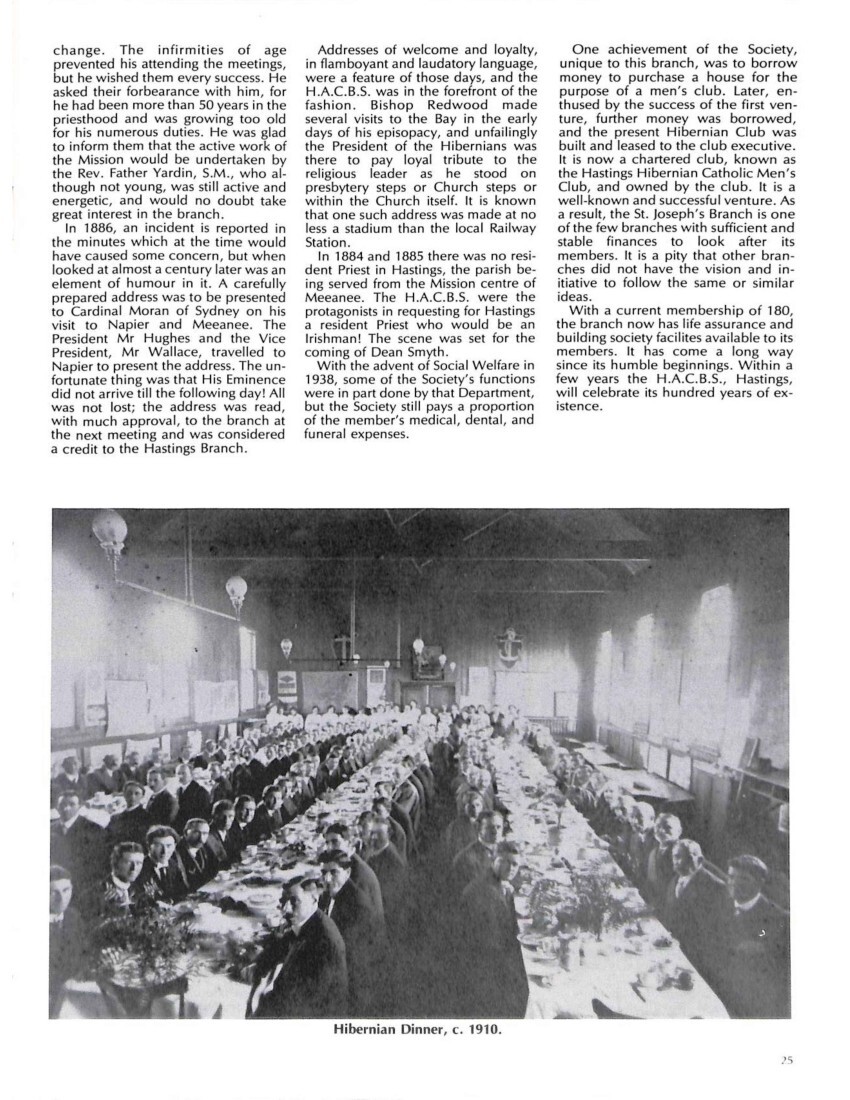
Page 26
THE SISTERS OF ST. JOSEPH
The Sisters of St. Joseph’s of Nazareth trace their foundations to Perthville, N.S.W., Australia, in 1876. They were founded by Father Julian Tenison Woods. In 1880, four Sisters arrived in Wanganui. Their first branch house was Hawera in 1885 and in 1888 three Sisters came to Hastings. They were Sisters M. Teresa, Philomena and Bernard.
Sisters M. Teresa Schmidt had been one of the original bands of four Sisters who had come from Australia in 1880. She had gone up to Jerusalem on the Wanganui River to help re-establish the Maori Mission there after the HauHau disturbances. She was accompanied by another Sister of St. Joseph and the indomitable missionary who we now know as Mother Aubert.
In 1884 the decision was made to withdraw the Sisters of St. Joseph to Wanganui and Mother Aubert was left free to found the Institute we now know as the Sisters of Compassion. After serving in Hastings, Sister Teresa returned to Wanganui to become Novice Mistress and later General of her Order. She outlived the other pioneer Sisters who came to New Zealand.
IN HASTINGS
At Hastings a school was opened in 1889. One of the foundation pupils was Mary Kearns, from Whakatu, who became Sister M. Borgia.
The Catholic community increased rapidly and the Sisters found themselves conducting a school for both boys and girls and with both primary and secondary sections. Well-known names among the Sisters who worked in Hastings were Sisters Patricia, Lucy, Enda, Felicitas, and Pauline. As well as teaching in the schools the Sisters visited the sick. A modern order of local origin they had the freedom and approach that enabled them to become very involved in the life of the parish.
During the influenza epidemic in 1919 the Sisters spent much time nursing the sick and one of them, Sister Thecla, died during this time. The aftermath of the earthquake of 1931 saw the Sisters out and about among the people who were injured, bereaved, homeless, and shocked. The police asked the Sisters to identify victims of the earthquake and fires.
The present convent replaced earlier accommodation and was built in 1901. The new wing was added in 1954.
Until the introduction in more recent years of the stipend system of payment for religious teachers in our schools, the sisters supplemented their meagre income from fees by teaching music. One of the music teachers to spend many years in Hastings was Sister Fidelis. She was awarded the Queen’s Service Medal for services to the community; ill-health forced her retirement to Wanganui where she died in 1982.
Photo captions –
Sister Teresa
Sister Borgia
Sister Lucy
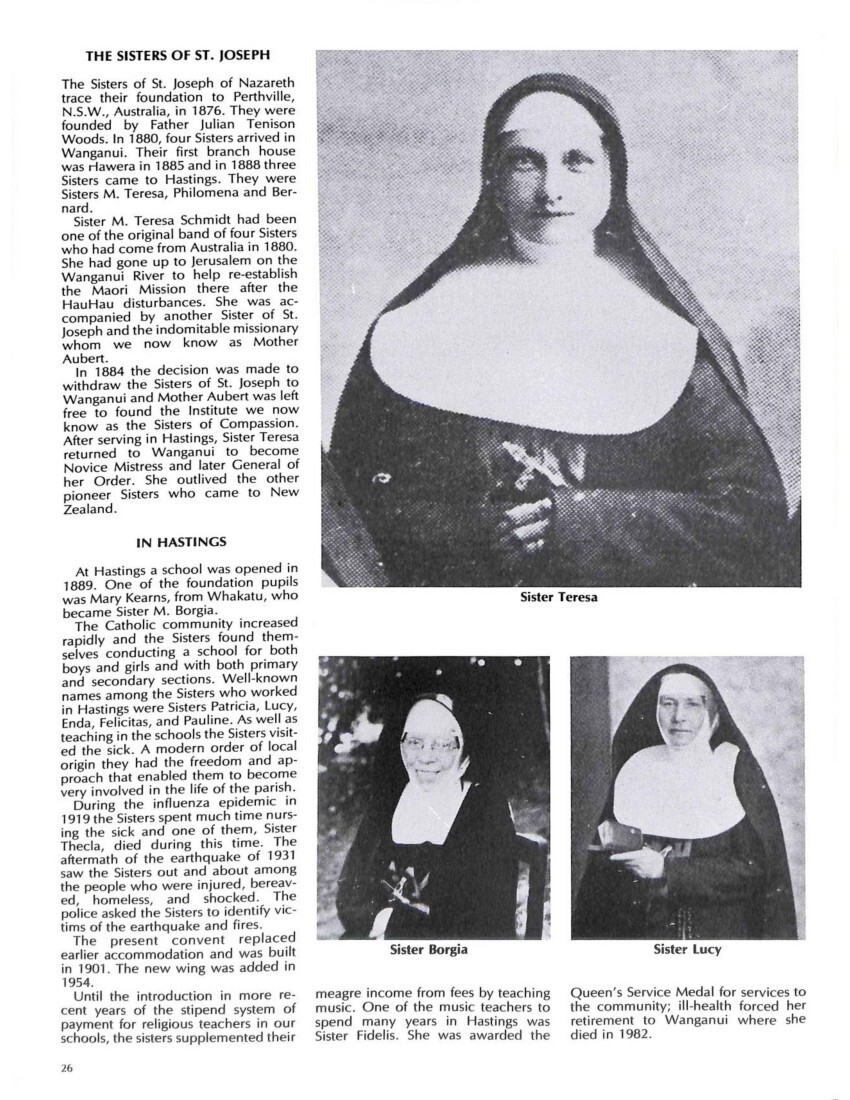
Page 28
Children of Mary in the convent garden very early 1900s.
Front row (left to right): M. Donnelly; M. Allison; D. Popplewell [Poppelwell]; Mrs Munroe; -; M. Conway; -; M. Casey; E. Lynn; -.
Back row: N. Maggin; H. Lynn; K. Donnelly; M. McCarthy; K. Hannah; – Heeney; -; -; M. Conway; E. Sweeney; L. Moore.
CHILDREN OF MARY
This sodality for single women was a feature of Catholic life in most parishes and Hastings was no exception. The members held monthly meetings and would wear regalia of a blue cloak and white veil to Mass and devotions. It was the custom for a member who was being married to enter the Church with her blue cloak on over her bridal dress and then proceed to Our Lady’s Altar where the cloak was laid.
The Hastings sodality dates from the 1890’s and Madame Le Lievre was the first President. A foundation member was Miss Margaret Donnelly.
The Children of Mary in the Blessed Sacrament Procession, 1912.
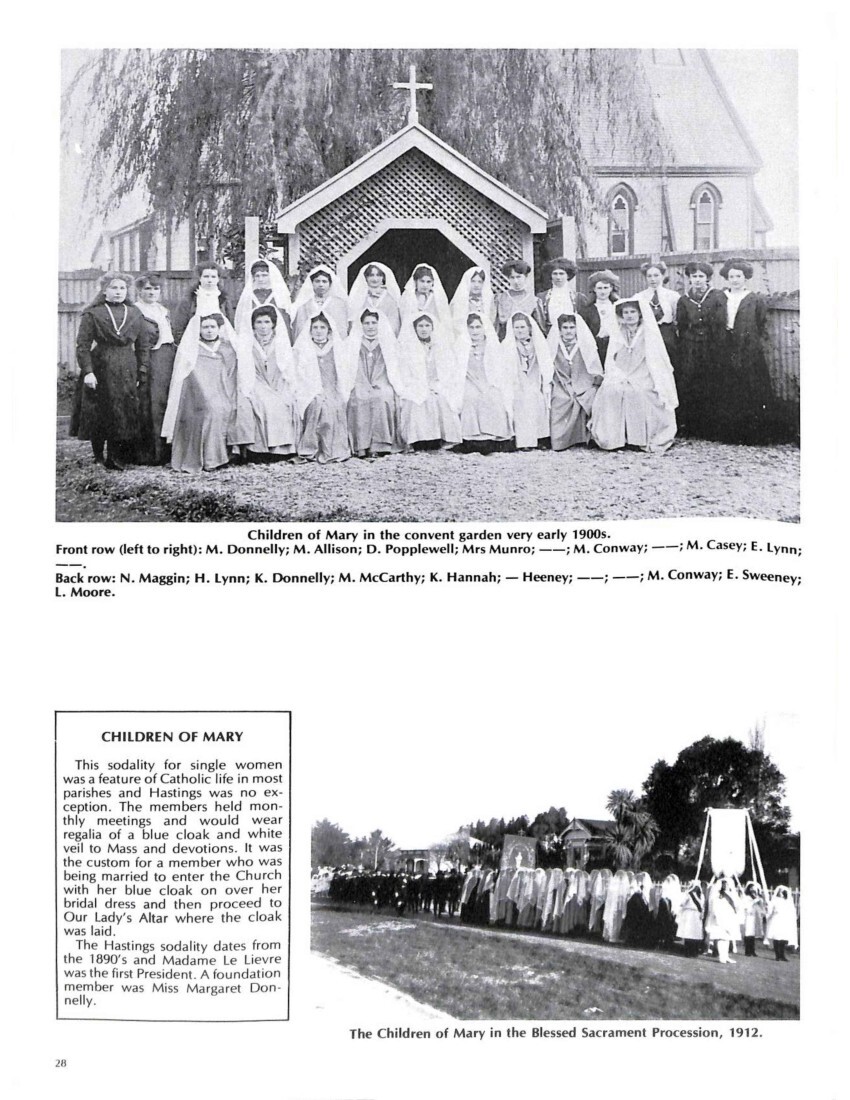
Page 30
ST JOSEPH’S CHURCH, CLIVE
In early days, the Catholics of Clive were cared for by the priests of the Meeanee Mission, among whom were Fathers Pertuis, S.M., Regnier, and Sauzeau. The first baptisms at Clive of which we have record are Mary Ellen Hennessey, who was baptised by Father Pertuis on 19 December 1865; Florence Avelline Caldwell, baptised on 26 January 1866 by Father Pertuis; and Oswald Walter Caldwell, baptised on 21 February 1867 by Father Reignier. It is likely that people of Clive were married in St Mary’s Church, Meeanee, or at St. Patrick’s in Napier, but there are some marriages entered into the Meeanee Register which took place at Clive long before a Church was built there. The first marriage at Clive of which there is record is that between Henry Burndrett, painter and Catherine Moffett, dressmaker. The marriage was celebrated by Father Reignier on 15 May 1866. The witnesses were Phillip Copeman and Annah Warfeld. The second marriage at Clive was that of Denis Cronin and Sarah Stuart, celebrated on 5 May 1869 by Father Reignier, the witnesses were Joel Masey and Maria Masey of Clive. The marriage of Frank Stanley and Kate O’Connel celebrated on 30 January 1881 by Father Reignier is the next one at Clive.
The distinguished Church in School Road was built by Father Smyth, S.M., on land donated by Joseph Burns of the well known Clive family. It was officially blessed and opened by Archbishop Redwood on 7 July 1889. After the disastrous flood of 1907, which rose as high as the windows of the Church, covered the altar and ruined the vestments, Father Smyth had the Church raised as it is today. In June, 1960, there was interior alterations to the Church and at this time the brass Tabernacle was donated by Mr T. Burns.
Disaster again struck the Church in 1974. At the end of the Mission in St. Joseph’s Church, during the evening of 29 April a fire broke out in the sanctuary. The Sanctuary was gutted by fire, but quick work by the Hastings Brigade saved the Church from being destroyed. The altar was completely burnt and the ceiling above the altar and the nave were extensively damaged. Fortunately the Church was insured. Renovation work started almost immediately, and parishioners worked at salvaging and renewing vestments and altar requisites. While repairs were being carried out Sunday masses were celebrated in the Presbyterian Church. The cost of repairing the sanctuary was estimated at about $8000.
On Sunday 13 October 1974, the Church was rededicated by the late Bishop Snedden. The readings of the occasion were given by Patricia Burns, David Kennerly (now Father D. Kennerly, S.M.), and Father Michael Cross, S.M. After the blessing of the new altar, the vestments and chalice, and the rededication of the Church there was solemn Benediction. At the conclusion, the Clive parishioners provided afternoon tea for all who were present.
The troubles of 1974 did not end with the fire. Another big flood isolated the Church once more on 17 June.
Although a relatively small area, Clive has been blessed with five vocations to the priesthood. Father John Goulter, S.M., who was born at Clive but did not live there very long, Father Michael Cross, S.M., Father David Kennerly S.M., Father Bliss, S.M., and Father S. Lorrigan.
A note of historical interest is that Mother Aubert, foundress of the Home of Compassion, often visited Clive in the seventies and used to stay at the house of Joseph Burns. Father Reignier too, often had meals at the Burns’s house. His choice of a breakfast was three brown eggs done in butter.
The Church of St Joseph at Clive still carries on its tranquil part of being a “A house of prayer for all the nation.”
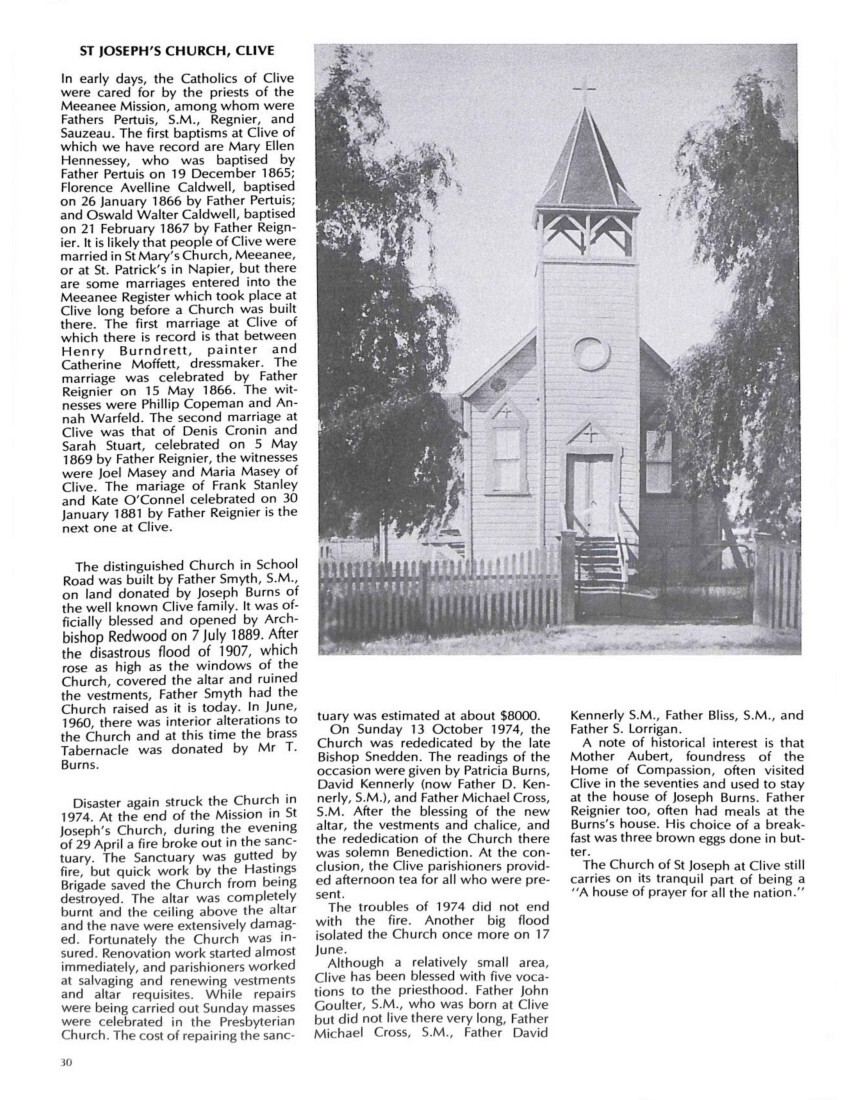
Page 32
FATHER H. McDONNELL, S.M., 1915-1917
The Parish Priest of the war years of World War 1, has been described as the most lovable and quietly effective of New Zealand Marists. Father McDonnell was born on the Feast of Our Lady’s Visitation, 2 July 1873, of pioneer parents, deeply rooted in the Faith. Five of his sisters became Sisters of Mercy. In 1888, at the age of 15, he went to St. Patrick’s College, Wellington, and was noted for his quiet studiousness. Although he was not of robust build, he played for College First XV, achieved distinction in the boxing ring, and enjoyed turning his hand to any sort of physical, hard work. The latter was a characteristic of him right to the end of his life. Father McDonnell was among the first New Zealand born students to go to the Meeanee Seminary. He was ordained to the Priesthood by Archbishop Redwood, 30 November 1897. After various appointments, he was named Parish Priest of Hastings, succeeding Father A. Keogh, S.M. The Provincial who appointed Father McDonnell, was Dean Smyth. It was the highest compliment the Dean could pay, to entrust to him his own beloved Hastings to which he had devoted the best years of his priestly ministry.
Father McDonnell was a model priest and religious, whose advice and experience were much sought after. Both Australia and New Zealand are deeply indebted to the priesthood of this humble, trusted friend and counsellor. He died on 25 August 1956 at the Marist Novitiate, Armidale, N.S.W. Bishop Doody of Armidale summed up this former Parish Priest of Hastings, saying: “If ever a man went to his God with hands full of priestly and religious merit, that man surely was the priest whose Requiem we have sung today.”
FATHER JOHN SEYMOUR S.M. (1941-51)
Father Seymour came to Hastings with a background of wide experience in parishes in New Zealand and Australia. He had many facets to his character, but above all he was a priest with an ability to make deep, lasting friendships. He loved flying and was an experienced pilot. Intensely interested in providing suitable facilities for the schools, he concerned himself with various activites to raise funds for St. Joseph’s High School (later Tenison), and the School Memorial Baths. In this, he linked with stalwarts as Jack Blake, Harry Poppelwell, Phael Geor, and Felix Hodgins. Father Seymour was an outstanding chaplain to the Holy Name Society. Although not possessing a powerful speaking voice, he had the ability to appeal powerfully to the men of the Parish. As a result the Sacred Heart Church would be full of men on the evenings of the Holy Name meetings. Father Seymour was a quietly spoken man with an intense sincerity which appealed to those fortunate people who came to know him.
FATHER GEORGE MAHONY, S.M., 1918-1923
Father Mahony was a curate to Fathers Keogh and McDonnell, before his appointment as Parish Priest of Hastings, so he knew the parish well before he took up the reins of authority. He was born in London, 1869, and came with his family to New Zealand in 1874. He was one of the first students of St. Patrick’s College, Wellington. After a course of studies for the Priesthood at Meeanee Seminary, he was ordained a Priest by Archbishop Redwood in Wellington, 1898. He came to Hastings in 1912. A biographer of father Mahony spoke of him as ‘one who loved his fellow man.’ He was a humble man, a trier, a friend of the poor. Sport, especially rugby, was one of his keen interests. One highly successful team he coached in 1917 included three Blake brothers of whom the future All Black, Jack Blake, was one. He was also an active executive member of the Hawke’s Bay Rugby Union. Three Bishops attended his requiem in Wellington, at which his brother Father Stan Mahony was the main celebrant.
Photo captions –
Fr. John Seymour
Fr. McDonnell
Fr. Mahony. The people of Hastings wanted him to be Mayor.
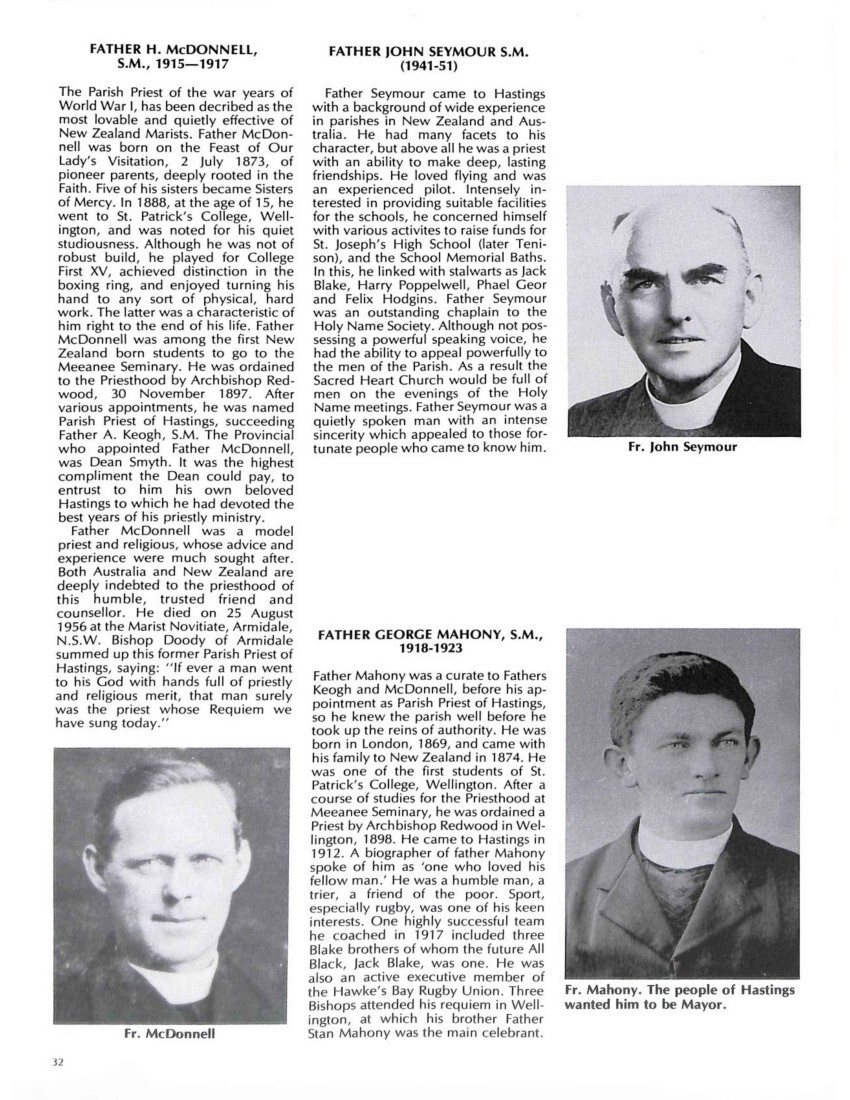
Page 33
FATHER A.F. McDONALD S.M.
1924-1928; 1936-1941.
Father Alex McDonald came from the small country town of Oxford in North Canterbury. Born of Catholic Scottish parents he was always proud of his Scot’s ancestry, and was related to Mother Mary McKillop, foundress of the Brown Josephie Sisters, whom he knew personally. Father was a man of many interests, among them, boxing, photography, literature, music and history. He had a special liking for and acquaintance with the Latin Classics. In World War I, he was chaplain to the N.Z. Mounted Division, and suffered an injury when a horse rolled on him. This injury affected him for the rest of his life. On the troopship to the Middle East, Father ‘Mac’ literally fought his way across half the world – a popular and competent figure in the boxing ring on board ship. In Hastings he was noted for his well-planned and well-delivered sermons, and his anecdotes (drawn largely from World War 1 experiences), his musical ability (Mr Marsicano and Madame Le Lievre were his close friends), his motor bike, gun and his ubiquitous dog. He played a large part in the founding of St. John’s College at Frederick Street.
FATHER FRAHER, S.M., 1929
The man who followed Father McDonald, S.M., as Parish Priest was Father J. Fraher. He had been assistant priest in Hastings for several years before his appointment as Parish Priest. To many he was an enigma, possessing remarkable abilities. He attracted a good number of young men to the priesthood. He was a controversial figure, attracting intense loyalty, or arousing strong opposition. He had an intense love of the Faith, which showed in the challenging way he preached and conversed with people. He did not brook opposition, and was intolerant of others’ views. His frank expression of views aroused several minor ‘Battles of Hastings’. After Hastings he was appointed to a Marist Parish in Brisbane, where he died 7 January 1931. A parishioner summed up Father Fraher by saying he had two loves – love of the Faith and love of the priesthood. On the day he left Hastings, he is said to have cried like a child at the Railway Station.
Photo captions –
Fr. McDonald.
Sister Anthony (Emma Cassin). First vocation to the Sisters of Compassion. A remarkably distinguised [distinguished] Religious sister.
Fr. Fraher.

Page 34
HASTINGS CELTIC RUGBY CLUB
HISTORY
The Celtic Rugby Club was formed in 1910 by a group of enthusiasts who wished to give Catholic youth of the town the opportunity to play the game of rugby together.
Since 1910 many thousands of young men have taken the opportunity to participate in this wholesome team game and the close relationship with the Parish of Sacred Heart goes back to 1910 when the club was formed following the inspiration of Father G. Mahony who had recently moved to Hastings and who had established a Marist Rugby Club in Timaru, his previous parish.
From the small beginnings the club went through good times and bad but has always retained a spirit and fellowship which has seen it put a team on the field every season for the past 72 years. There has always been a band of administrators who have believed in Celtic and what it stands for. The support and encouragement of the clergy of the Sacred Heart Parish has played a large part in the promotion and success of the club. So much that one Priest, Father Lionel Dean, who served in the parish in the late 50’s, was made a Life Member of the club for his efforts, particularly with the formation of Celtic schoolboy teams. Father Dean is now serving in Australia but still keeps contact with several club members and follows the club’s progress with great interest.
The club has not been able to boast many All Blacks but Jack Blake and Neil Thimbleby are two who will be well remembered. Mike McCool played all his rugby for the club until he moved to Wairarapa Bush Union territory to establish his own farm. He was selected for the All Black tour to Australia from his new union but the Celtic Club took great pride and satisfaction from his selection.
The club has been successful in winning the Maddison Trophy, the premier title in Hawke’s Bay club rugby, in 1935 and 1978.
One of the most memorable achievements in recent years was the winning of the Spillane Cup, the premier trophy played for each year by all North Island Marist clubs. The win came in 1978 when the club hosted the tournament for the first time.
In 1982 the club fielded four adult teams catering for some 100 players. The schoolboys were well catered for with teams covering all age groups from bantams to form 2 level.
Facilities for playing and supporting members are vitally important and in this regard the club is fortunate in being granted the use of the St. Johns College grounds for training. In 1967 the Celtic clubrooms in Alexandra Crescent were officially opened by Mr Jack Blake, the foresight and hard work of many administrators has seen the club well-placed financially and the owners of a very fine clubrooms.
Celtic Foundation Team, 1910. Runners-up Hastings Junior Championship.
Back: W. Fitzwilliams, J. Carr, S. Brooking, T. Aldridge, W. Allison, J. Farrelly, W. McCormick, J. Fitzgerald.
Middle: J. Farrelly, J. Gallagher (Club Captain), W. Maher (Capt), J. Hallagan (Treasurer), J. Maggin (V. Capt).
Front: A. Aldridge, C. O’Connor, E.R. Tacon (Secretary and Selector), H. Seed, E. Nugent. In front: Moira Gallagher (Mascot).
Celtic club team. Fr. Mahony in the middle row.
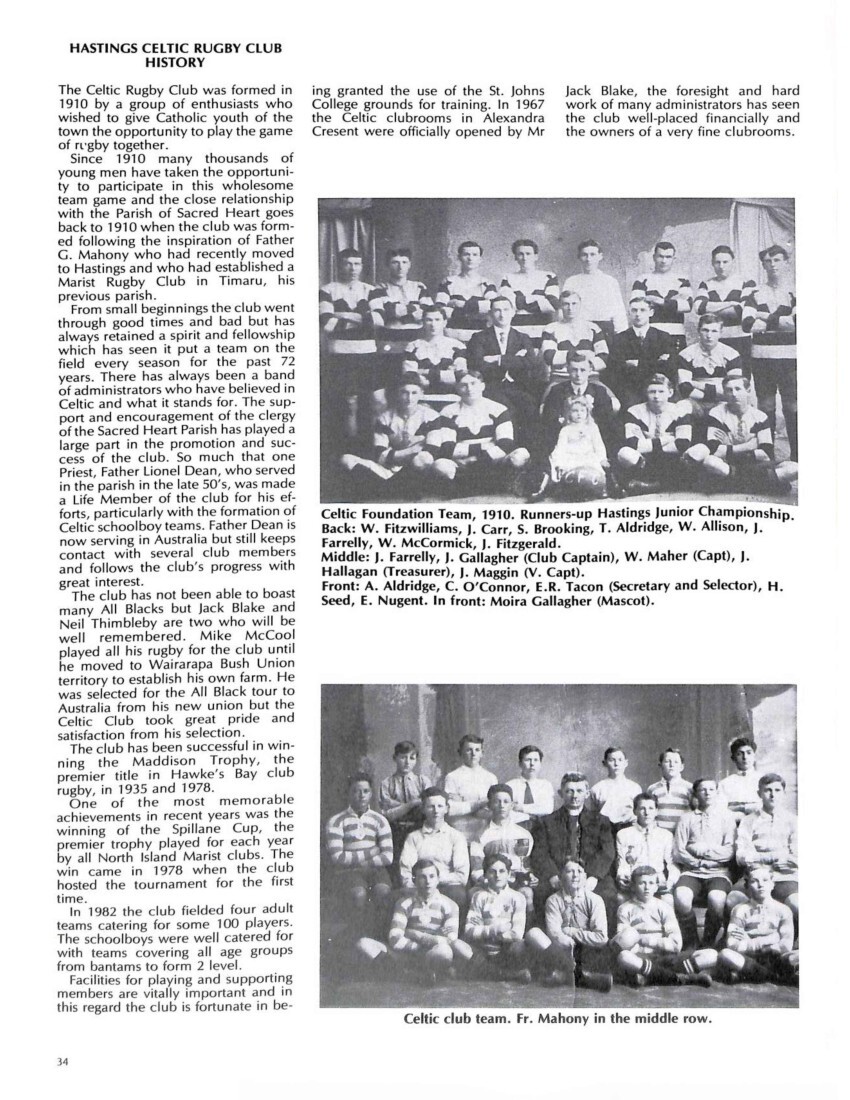
Page 35
Many of the life members of the club will be well known to parishioners, and include the current President, Mr Jim O’Connor and his wife Isla, Barney Walsh, Laurie Hannigan, Tut Geddes, Brian Murphy, Father Lionel Dean, Mick Cowan, John Sullivan, Trevor Greville, Don McMillan, and Sef Russell.
When the name Celtic comes to the fore in discussion one name which will soon surface is that of the late Phil Reid. Phil was a really talented rugby player who was unlucky not to be selected for the All Blacks, the war intervened and the tour for which he seemed certain to be selected was called off. However, Phil played for Celtic and Hawke’s Bay for some years and took office as Club President for 25 years, a truly remarkable contribution in time and effort.
The Celtic Rugby Club has always had a close relationship with the Parish of Sacred Heart, the Parish Priest is joint Patron with the Parish Priest from Hastings West Parish and each year the Parish Priest of Sacred Heart appoints a Chaplain to the club. Currently Father Geoff Officer himself is the Chaplain.
Congratulations to Sacred Heart Parish on the occasion of the celebration of 100 years work by the Marist Fathers in Hastings and very best wishes from the members of the Celtic Rugby Club for very successful centenary celebrations.
Photo captions –
Celtic Ninth Grade, 1958. Winners of the Moriarty Shield and Hastings Championship.
Back: B. Walsh (Coach), C. Bolgar, T. Heeney, P. Barry, M. McCarty, P. Rawson (V. Captain), J. Wallace, P. Ward, Fr. L. Dean (Coach).
Middle: B. Keehan; A. Graham, K. Heffernan, D. Wall, R. Duncan, C. Andrews, D. Blasoni.
Front: P. Heffernan, W. Francis, L. McIntosh (Capt), T. Sullivan, J. Brittain, N. Kerrisk.
Celtic Team 1939 Co-winners of the Hawke’s Bay championship and Madison Trophy and Moriarty Shield.
Stand at Back: A. Bower, D. Maaka, J. Caulton, R. Fox.
Standing: G. McKenzie, T. Chadwick, F. Campbell, D. Watson, J. Ross, E. Galgey, H. McKenzie, J. Walford.
Sitting: J.M. Blake (Coach), R. McCarthy, L. Hannigan (V. Capt); P.J. Reid (Capt), L.V. Hallagan, E.G. Geddes, J.D. Hallagan (Secretary).
Front: D. Pullen, H. Tomoana. Absent: N. Collins, J. Allsop.
Distinguished member of Celtic. Group Captain Bill Tacon, D.S.O., D.F.C. and Bar, A.F.C. His father was a foundation member of the club.

Page 38
SACRED HEART CHURCH CHOIR
It would be very difficult to give an adequate appreciation of the part that the Choir has played in the history of the Sacred Heart Church. Music plays an important part in worship, in increasing the effectiveness of Scripture, prayer, and liturgical action. The choir, by its virtuosity and devotion, has contributed immensely to sacred worship over the years.
At the beginning of its history, much help was given by the choir members of Napier and Meeanee, until the local Choir was strong enough ‘to go it alone’. Thus for the official opening of the Sacred Heart Church in 1882, it was a choir from Napier under the direction of Brother Athanase of Meeanee which provided the music, the organist being Mr Holder of Napier.
The solemn opening of the new Church of the Sacred Heart in 1895 was a splendid occasion for the Choir. According to the Daily Telegraph of the time, the music for the Mass and Vespers was “an artistic treat that will be one of the pleasant memories of a red-letter day for the Catholics of Hastings.” The chief work performed that day was the ‘Imperial Mass’ composed by Franz Joseph Haydn for the wedding of the Emperor of Austria. The orchestra and singers totalled 48 performers. Mr A. P. Sheath was the conductor, Mr S. G. Poppelwell was choirmaster, and Mrs St. Clair of Napier, the organist. Mr A. A. George, a town councillor and well-known printer, was a member of the choir and later became its conductor.
The 1890’s was a time of growth for the Choir. Various functions were held to obtain funds and attract members. Very early, the Choir was fortunate to have the services of Madame Le Lievre who for 50 years presided at the organ. Madame Le Lievre was a gifted musician, who gave generously of her talents for half a century. The parish owes her a great debt of gratitude.
The Church is fortunate in possessing a fine organ. It is more than a hundred years old, was purchased in England about 1900, and donated to the Church in 1905. The sad thing is that the names of the two parishioners who donated the organ have been lost. In the time of Father Heagney, S.M., repairs were effected, and a major work of updating was carried out in 1976. This work included the changing of the ‘action’ of the organ, the renewal of pipes and a new position for the console. This renewal has added years to the life of this beautiful instrument. Choir members themselves and their friends, by various forms of fund raising, obtained more than the $6000 required for the renovation – a really great effort. A dedication ceremony was held on 18 October 1976. Mr Maxwell Fernie, whose advice had been sought on the rebuilding scheme, came to conduct an interdenominational choir and to play the rebuilt organ.
There have been many generous and enthusiastic supporters of the Choir over the years; among them are Isobel Little, Mary Hodgins, Mollie Ahern, and the ever-supporting Geor families. Father A. Hill, S.M., now of St. Bede’s College, Christchurch, is remembered for his valuable work as assistant organist; Father A.F. McDonald, S.M., and Mr Marsicano, both of them accomplished violinists, provided violin accompaniment for the Choir on various occasions. Many conductors and organists have featured with distinction, among them Messrs S.G. Poppelwell, R. Ryan, S. Bryant, K. Watson, F. Geor, and Mmes Le Lievre, Corrie Hughes, Del Hamilton, and Marie Stothart. Various other organists have given valuable assistance when required. Among them are Sister Hyacinth, Mrs Eileen Lamone, and Miss Ann Wilding. Members of the Choir, so faithful and generous over many years are too many to be individually recorded. Suffice it to mention names like Maureen Brady and Admah Geor for their outstanding contribution.
The Sacred Heart Parish is very proud of all its devoted Choir members and benefactors whose dedication and achievement sound a high note in this century of parish history.
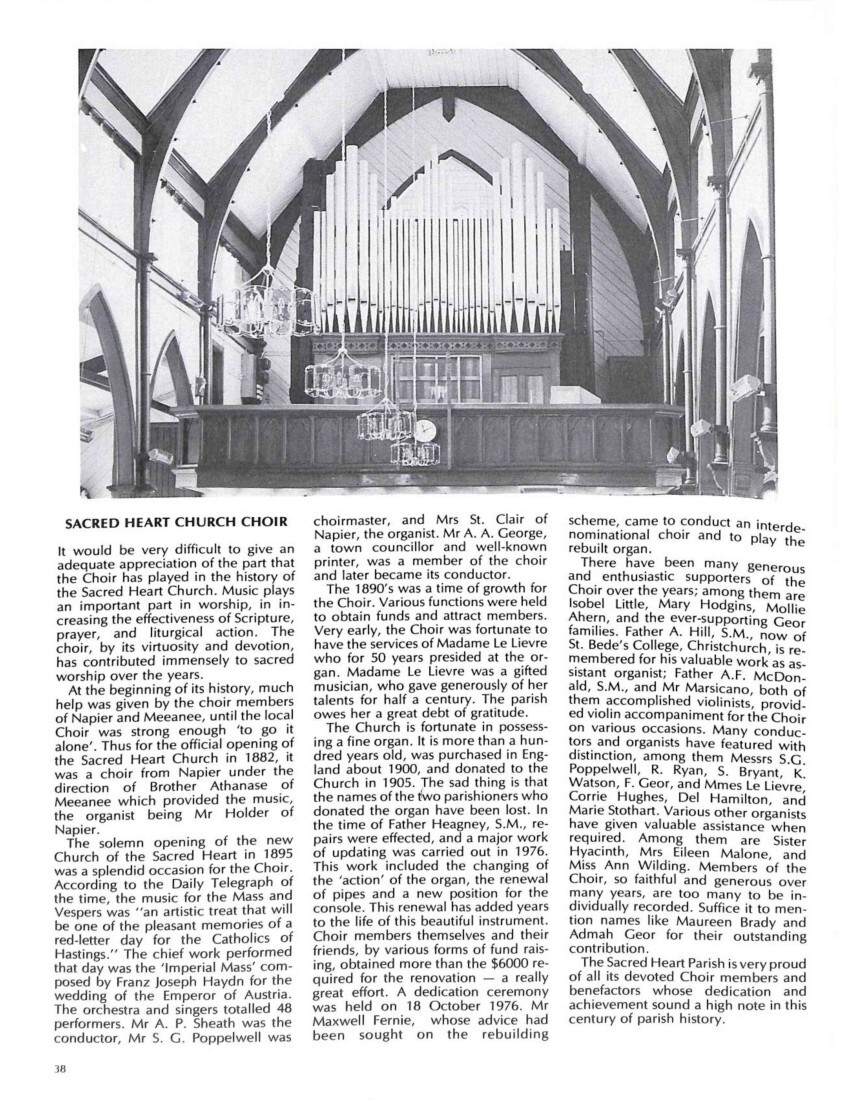
Page 39
THE PARISH CHURCH
Read at all Masses, 20 Feb 1938
“This brick wall has just been completed and has been admired by non-Catholics as well as members of the congregation and is considered to considerably enhance the appearance of the Church and presbytery property from the street view.
It represents excellent workmanship and original design and should stand for many a year without the need of repair.
The building of the brick wall cost with the gates (made in Christchurch) 150 pounds and was made possible through a legacy from the will of the late Peter McLean.
It will interest that the deceased could wish for no more lasting memorial than this handsome wall.
It will interest you who were familiar with him to know that his generosity was extended to the good Sisters of Hastings to whom he left 400 pounds. The Seminary at Greenmeadows also received 500 pounds while other legacies of 50 pounds each were left to two other convents in the Diocese.
Since the brick wall is a parish erection enhancing the appearance of the graceful Church that is such an outstanding landmark among the towns buildings – we feel its erection should concern the parishioners to some extent.
So we appeal to your mindedness and generosity to raise 50 pounds which, with the legacy of late P. McLean, will pay for the completed wall.
As you leave the Church you are asked to take from the collector at the church door a small envelope “New Church Wall” I donate one brick. The contribution is small but you will feel that you have helped to build it because you will have contributed at least a brick towards the new church wall”.
Donors of the windows in the Sanctuary:
C. Hughes.
I.H. Loughnan.
J. Cullen.
H. Scullion.
In the Side Altars:
Members of the Apostleship of Prayer – two windows.
Members of the Altar Society – two windows.
Memorial Side Windows:
J.T. Blake.
D. NcNamara.
J. Barry.
J. Kelly.
M. Howard.
J. Hickey.
R.T. Blake.
J. Heeney.
F. Nugent.
T. Hewetson.
A. Le Lievre.
Donors of the Stations of the Cross:
J.T. Blake.
Mr and Mrs T. Quinlivan.
Mr and Mrs P. Long.
Mr and Mrs P. McCarthy.
Misses B. and M. Mackle.
Mrs McCormick.
Mr and Mrs C. O’Donoghue.
Mr and Mrs J.A. Potham.
Mr and Mrs C. Hughes.
Sisters of St. Joseph.
Mr and Mrs J.P. Elwood.
Mr and Mrs W.Y. Dennett.
Donor of first pulpit:
Mr. J.P. Elwood.
Donor of Church Bell:
Father P.J. Smyth, S.M.
CLEANING OF THE SACRED HEART CHURCH
This massive job at one time done by Mrs Amner who also worked for many years at the presbytery in Father Shanahan’s time, Mrs Margaret Roberts helped to organise this work. In recent years a group of ladies lead by Mrs Isabel Perry home attended to this important work every Saturday morning.
The Sanctuary used to be cared for by the Sisters and Mrs Nightingale. The Altar Society assisted the Sisters and were responsible for the cleaning of the brass, the replacement of carpet and vestments, and at one stage the making of altar breads. The Altar Society was in fact one of the earliest groups set up in the Parish, and dates back to the first Sacred Heart Church opened in 1882. Stalwarts of the Altar Society were Misses Marie and Margaret Thompson, Mrs Olga Unverricht and Mrs Eileen Malone.
In more recent years Miss Vera Dawes has been sacristan and has been largely responsible for the cleanliness and beauty of the Sanctuary, the vestments, and the sacristy.
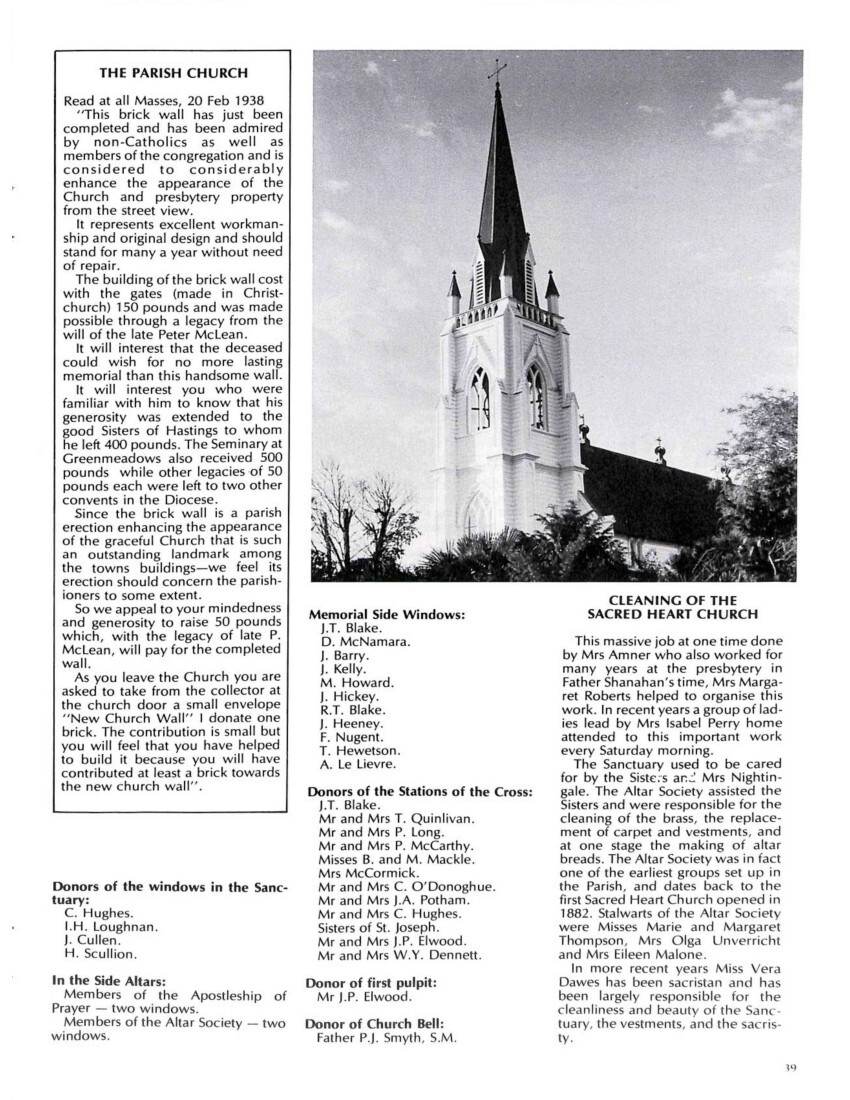
Page 40
FATHER BERNARD GONDRINGER
Father Bernard Gondringer was Parish Priest of Hastings for only one year and was killed in the 1931 earthquake while attending the opening conference of a retreat to the seminarians.
He was responsible for the original red-brick design of the new St. Joseph’s School and for collecting a large sum of money for its erection. It was Father Stewart who replaced him and who saw the school plan adopted and completed.
Father Gondringer was a remarkable preacher. He was able to fill the Sacred Heart Church for Sunday evening devotions.
FATHER J.W. STEWART S.M.
Father Joseph endeared himself to the parishoners [parishioners] of Hastings. He was born near Nelson in 1885 and ordained in 1915. He was Parish Priest of Hastings from 1931 to 1936. To him fell the task of ministering to the people smitten by the earthquake and the effects of the Depression. He was responsible for the rebuilding of St. Joseph’s primary and secondary schools. He returned to Hastings as curate in 1954 and remained at the presbytery until 1969 when he retired to the care of the Little Sisters of the Poor at the Holy Family Home. He died there in 1972.
He was a great believer in visiting his people. He disliked fuss and had a delight in cutting through red tape. A somewhat reserved man, he was nevertheless a forceful preacher and a fatherly pastor.
In his later years when visitation became more difficult he would go up town every day and kept in touch with many as he met them in the street. The white dustcoat was a familiar sight as was the smile of the man who did much for the parishioners of Sacred Heart.
THE ‘NEW’ ST. JOSEPH’S SCHOOL
Father Gondringer had collected a large sum of money for the new school. It fell to Father Stewart to see the project through. The original design was for a building in red brick but the depression forced a change to wood. The new school was opened by Archbishop O’Shea on 15 December 1935. The combined roll, primary and secondary, was 500 pupils. After the building had begun, Father Stewart found that the Government subsidy on labour enabled the school to have two more classrooms than originally envisaged. Approval was promptly sought to add the extra rooms. Thus and eight-classroom block eventuated.
St Joseph’s remained the only Catholic primary in Hastings until the opening of St. Mary’s in 1957. Boys attended the convent for their secondary education until the opening of St. Johns in 1941. The secondary girls continued in the rooms at the eastern end of the school block until the opening of the new Girls’ High School in 1950.
The very first church of 1818 still serves well as part of St. Joseph’s School.
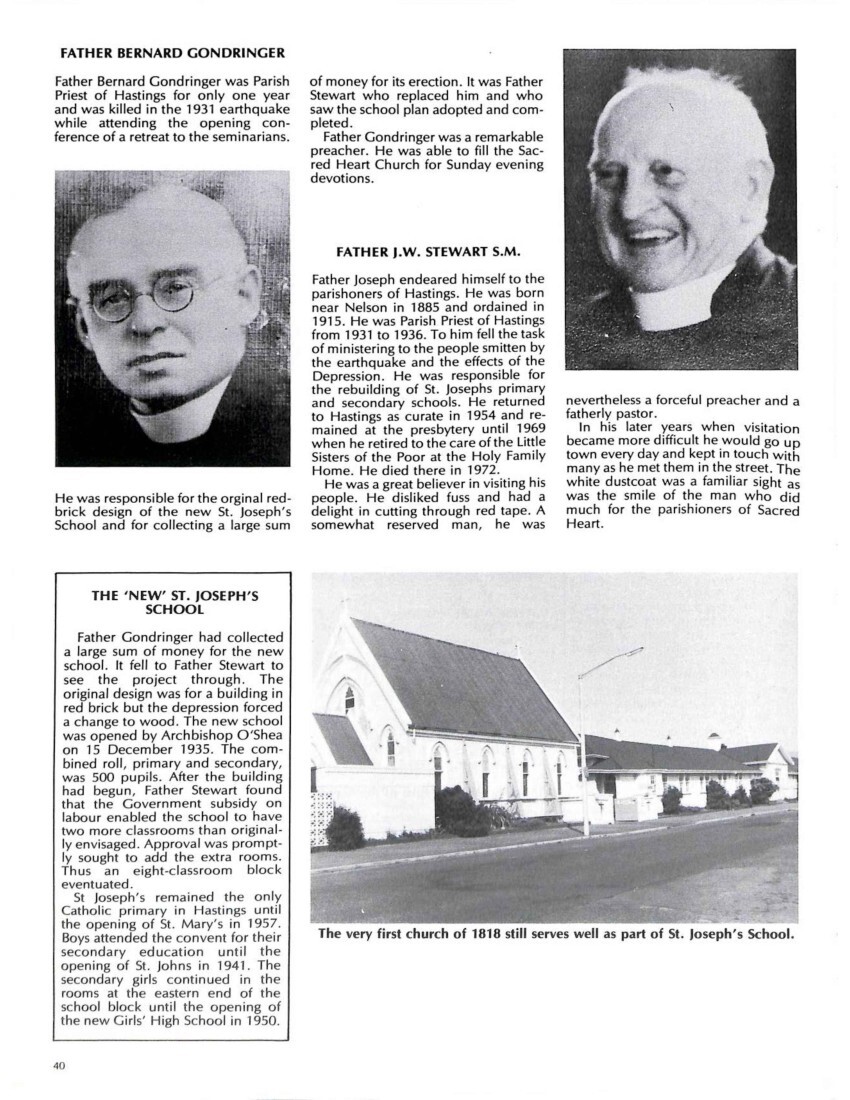
Page 41
Convent Senior Boys’ Football team, 1931
Back row: Fr. J.W. Stewart; Doug Watson; Charlie Gallagher.
Middle row: Bill McCarthy; Ray Daly; Ray Horton; Phil Barrett; Jack Williamson; Pat Fox; T. Sullivan.
Front row: Ray Fox; Jack Sullivan; Sid Fox; Frank Collinge; Jack Plowman; Cyril Marty; Mick Coman; Jim Gallagher.
Standard Six 1928
Back row (left to right): Robert McCarthy; Ernie Manson; Austin Donovan; Frank Laredo; Luke O’Connell; Vaughan Halligan; Pat Sullivan.
Third Row: Laurie Brady; Maureen O’Sullivan; Kathleen O’Connor; Joan Gallagher; Len Giles; Peter Koorey; Denton Brimer.
Second Row: Stan Moloney; Bernie Unverricht; Terry Walsh; Gus Breen; Pat Gardner; Peter O’Regan.
Front Row: Molly O’Connor; Agnes Hempseed; Dolly Kitching; Clare Barrett; Olive Cosgrove; Alice Cassin.
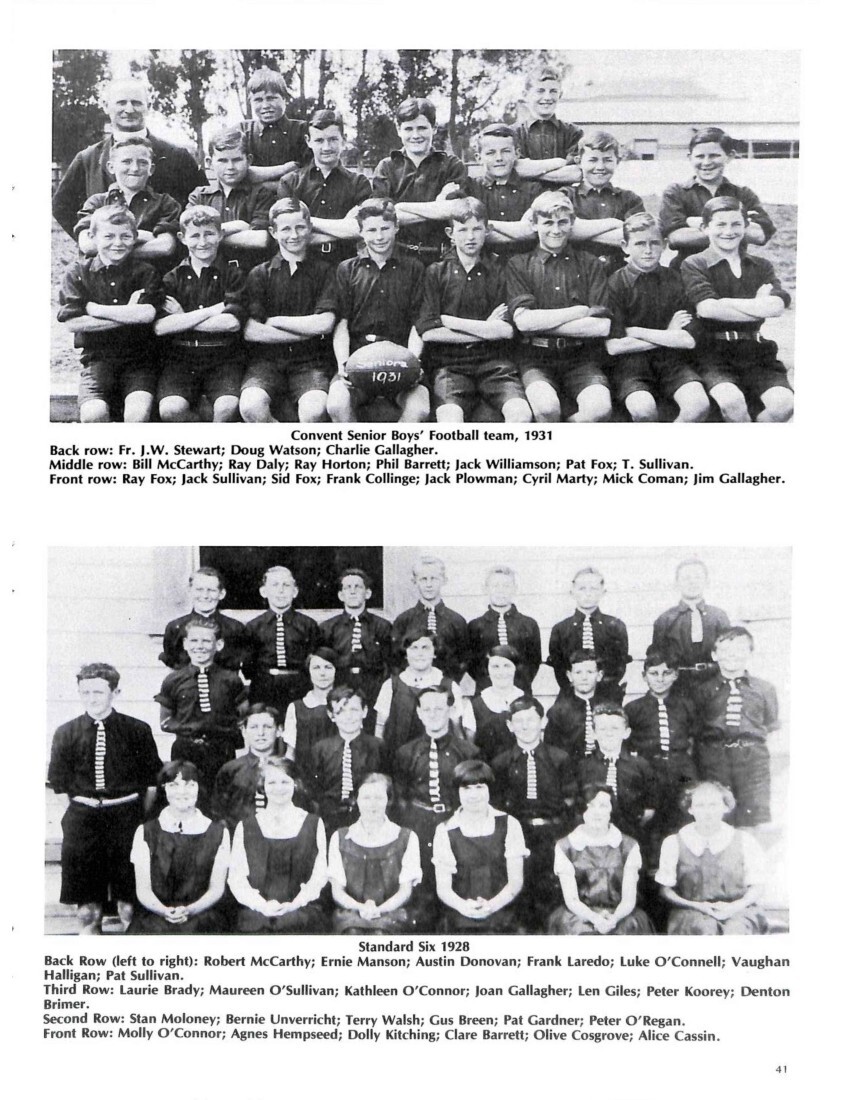
Page 42
WORLD WAR TWO
The sermon notes of Father A. McDonald on 3 Sept 1939 read as follows: “Holy Father broadcasts for peace. Suggestion of Italy of conference between Britain, Italy, Poland and France. Lord Halifax: ‘No conference while Poland is being subjected to invasion. Six bombing raids over Warsaw yesterday. Gas? Polish reports say bombing not confined to military objectives – ruthless invasion! Pitiable procession of women (expectant mothers) children, blind, cripples from London and other large towns. Exodus of civilians from Paris. Serious fighting on whole front. Prayers for country with such splendid Catholic traditions. Poland.”
The next year on Sunday 15 August the offertory collection was taken up at all Masses for the soldiers’ hut at Trentham. The institute comprised a hall, chapel, and chaplain’s room. The total cost was eighteen hundred pounds. The St Vincent de Paul Society requested books and magazines suitable for the military camp.
Requests for Masses featured prominently during the war years. A common request was for the safety of our soldiers in the Middle East and from 1942 names would be read out of men missing in action or killed.
Evening devotions were changed to four in the afternoon because of the blackout regulations and impossibility of covering the windows of the Church.
As the war drew to a close the social life of the parish picked up again. On 6 May 1945 the following notice was read out at Mass:
“We wish to advise those interested in the Napier Youth Club Social there will be a special bus leaving Hastings at 7pm tomorrow, returning from Napier at 10.45. In the event of V.E. Day occurring tomorrow, all arrangements will be cancelled.
Re Victory celebrations. On the day of the announcement that hostilities cease in Europe? On the same day and at the same hour as the public celebrations? There will be Exposition of the Blessed Sacrament? Appropriate Prayers and Benediction.
On the following day there will be a mass of Thanksgiving at 9 O’clock. We would be grateful if the choir be prepared for sung mass.
After the War:
The Catholic Returned Servicemen gathered in 1946 to meet up again with Fathers Leo Spring and Jesse Kingan. For many years afterwards Anzac Day Mass saw a large body of returned servicemen and women on parade. They would march from the Church to the Cenotaph and return for a function in the hall. Boys from St John’s joined this parade and provided a catafalque party until the disbanding of cadets in the 1960s.
The plight of people in Europe in the post-war years was brought to the attention of the people of Sacred Heart. In July 1946 the pupils of St Joseph’s presented a concert in the Municipal Theatre. Proceeds went to the Archbishop’s Fund for the starving Children of Europe.
By 1950 nearly a thousand pounds had been given through the Catholic Relief Organisation. The money was spent on procuring food and this was freighted free of charge. Most of the food went to orphanges [orphanages] in Britain.
CONVENT MEMORIAL BATHS
A committee headed by Mr Harry Popplewell [Poppelwell] was formed in September 1944 to explore the possibility of erecting swimming baths for the Parish school. Other members of the committee were Mr Jack Blake, Mr Dan Begley, Mr D.O. O’Keefe, Mr T. Revel, Mr R. Geor, and Father John Seymour. Fund raising started immediately. The architect was Mr Garnett and Mr Peter Bridgeman tendered successfully for the job. Mr Fred Geor built the pavillion and dressing sheds.
The baths were opened on 1 December 1945 when the keys were formally handed over to Father Milligan. The baths were controlled by St. Joseph’s Swimming Club, who employed a caretaker and ran numerous carnivals.
The baths cost approximately 3000 pounds. Money raised by solicited donations, an appeal to parishioners and, because they were a memorial to soldiers killed in both world wars, a government subsidy of 250 pounds was received. The opening of the baths was delayed by the unavailability of cement.
Enjoying the first swim in the new Memorial Baths, December 1st, 1945.
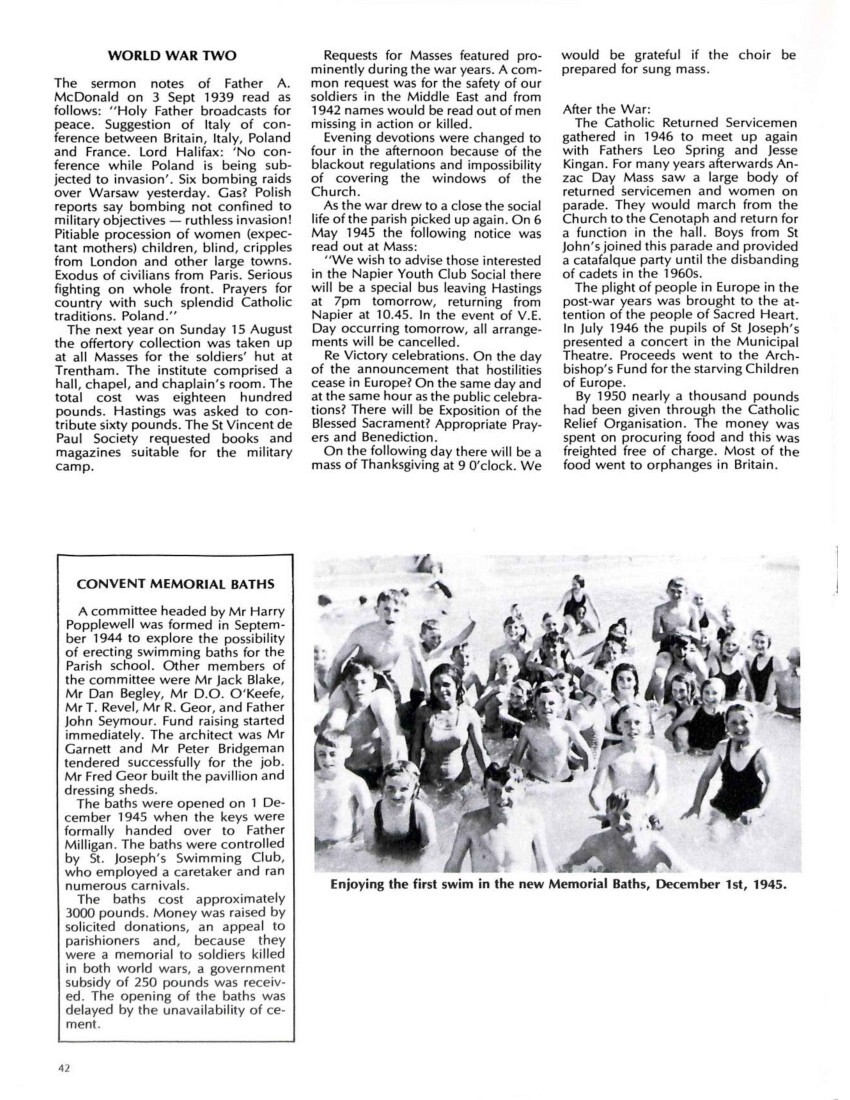
Page 43
FR DAN MILLIGAN, S.M.
Father Dan Milligan was a loveable father figure. He was a big man with plenty of commonsense. Before coming to Hastings he had been stationed at the Basilica of the Sacred Heart in Wellington. He became Parish Priest of Hastings in 1944. Catholic secondary education in the Bay owes him much; it was Father Dan who bought the Jervois Street property for St. John’s and he made the initial decisions to transfer the girls’ secondary school to a new site to the west of the St. Joseph’s Primary School.
He began the regular Sunday Masses at St. John’s, Mahora, and encouraged an able committee in their project to build the Convent Memorial baths.
It was during Father Milligan’s time that the first Hastings Charity Ball was held in 1947. Hitherto debutantes had to be presented to the Archbishop in Napier and special buses would be put on for the Hastings people. After 1947, Hastings and Napier alternated in hosting charity balls.
Father Dan left Hastings for Mount Albert at the beginning of 1949. He later returned to Hawke’s Bay and became bursar at the Seminary and then Parish Priest of Meeanee. In 1963 he retired to Wellington where he lived with his sisters beneath the shadow of the Basilica of the Sacred Heart. He died in 1969.
MARIST THIRD ORDER
Third orders have been in the Church for many centuries, and are always linked with some Religious Order. Whenever the Society of Mary has been established it has endeavoured to found branches of the Third Order of Mary, and had regarded this work as a priority. It is part of the spiritual family of the Marist Society and the Founder of the Society of Mary, the Venerable Claude Colin, S.M., desired that the Marist Fathers cherish the Third Order as a great means of spreading the influence of Mary the Mother of God throughout the world.
Father Alex McDonald, S.M., a chaplain from World War I, was the inspiration behind the forming of the Marist Third Order in Hastings. He was aware of the fact that the Holy Name Society provided spiritual opportunities for the men of the area, and decided that a group for women would be very useful. He called a meeting for women on 22 February 1939 and the Third Order was launched in Hastings. Father McDonald was the first Director. Fifty women attended the initial meeting.
It is of interest to recall that there are still members of those early years who are strong supporters of the Order, and are still living in the Hastings Parishes.
Ten years later, Father Leo Spring, S.M., a chaplain from World War II, expanded the group to allow men to share in the spiritual advantages of the Third Order. The present group meets monthly at the Holy Family Home where, after a short discussion and instruction, the meeting ends with Benediction.
Only two of the Directors of the Third Order have been mentioned above, but various other distinguished Directors have given generous support and much spiritual help. The minutes of the Third Order show how thorough and inspiring has been the instruction of the Directors. Father Alex McDonald was noteworthy for his work in founding St. John’s College at Frederick Street, and Father Spring for establishing the Holy Family Home in Wolesely [Wolseley] Street. Looking back over the history of the Third Order one is struck by a devoted work of Miss Margaret Thomson, one of the original councillors of the group. From the beginning, she was appointed Secretary-Treasurer; she never missed a meeting, recorded the minutes meticulously, was Novice Mistress, Promoter Marist Messenger, and was Librarian. For 30 years, Margaret performed her voluntary duties in an exemplary fashion, and the Marist Parish of Hastings must record its gratitude to her for selfless, quiet work throughout the years.
The Third Order is the largest group within the Marist Society; it has its home in all aspects of parish life. It offers people an authentic way of putting into practice the Second Vatican Council’s teaching about the place of Mary in the Church, and the relationship we should have with her. By its simple practices, it is well within the reach of all, husband and wife, the young and the old. Of special care of the Third Order is the unborn child and young mothers. It is to be hoped that the next 100 years will see a further flowering of the Third Order through its growth in Marist Spirituality.
ST JOSEPH’S SCOUT GROUP
The first St. Joseph’s Scout Group was founded 44 years ago. Father P. Heagney, a young curate in the parish at that time, chose six boys to go to Napier with Mr Tacon. They trained under ‘Jumbo’ Bain, St. Patrick’s Group Leader, and learned the rudiments of scouting.
They were invested on 3 May 1938. ‘Chips’ Ken Crabtree was the first Scoutmaster. When he left for overseas, assistant Brian Oulaghan and then Alan Oulaghan became Scoutmaster.
The first church parade was held on 24 July 1938.
Many outstanding leaders, committee members and boys have been associated with St. Joseph’s Group over the years and it was with real regret that St. Joseph’s committee accepted the resignation of Ted Sullivan, Group Leader. Ted has given 20 years of service to scouting, sixteen of these in uniform. Betty Sullivan his wife has been Cub Leader for the same length of service, and it is under their guidance that the Group had gone from strength to strength. With the very able assistant leader, and the many parishioners that have served on the committee, the Group has been able to incorporate the teachings of the Church with the character building and skills taught by the World Wide Brotherhood of Scouts.
David Kennerly, recently ordained, is an ‘old boy’ of the group and going through the record one can read the names of many who are still very active in the parish.
Present leaders are, scouting section, F. Ngapare, B. Muir, and in the Cub section, B. Sullivan, A. Milne, J. Miller, J. Kinney and M. Van Hooijdonk.
Parishioners have been active in other Scout groups in Hastings in various uniformed positions.
Chaplains Fathers Heagney, McManus, Dooley, Cahill, and Whiteford have over the years played a full part in Scouting, participating in many ways as well as the religious instruction which is an essential part of both boys and leaders training.
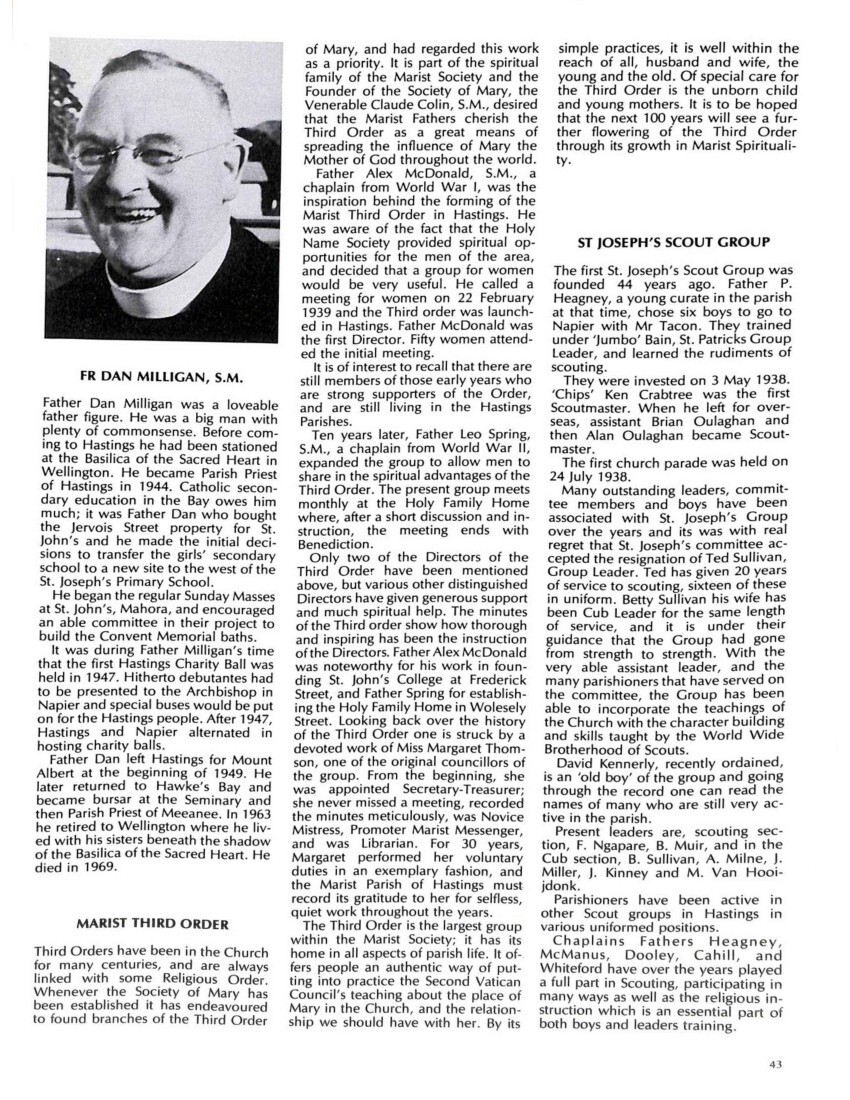
Page 44
APRIL 1939
NOTES LEFT BY PREACHER
CATHOLIC HIGH SCHOOL IN HASTINGS
Archbishop spoke of bringing in Marist Brothers and erecting a high school. This Parish has been founded and fostered by the Marist Fathers. And since the Marist Brothers have opened a school in Palmerston – and Marist Fathers have been asked to teach in a high school to be built in Hastings – this school will be a parish school (like one in Timaru) and will be built by the Parish of Hastings.
It will fill a long-felt want. Our secondary school cannot enjoy the privileges of registered secondary school because it has not the facilities for teaching science. Also, since it is not registered, our boys are not entitled to the fare reduction enjoyed by local pupils of Hastings High School. The high school built in Timaru – and considered a model for a secondary school for boys – has 45 pupils. It is a two-roomed building with a science room attached.
To accommodate the teachers (Fathers) and since Father Peoples is to be attached to Hastings we shall have to enlarge the presbytery (add at least three rooms). At the beginning of the year reference was made to an added financial burden. We shall call on your generous cooperation to raise money for the works I have suggested above (presbytery and school).
We can never spend too much on catholic education for our children.
The State in many countries is encroaching on the sanctities and rights of the home and SCHOOL.
Magnification of the State – in Germany 10,000 schools closed.
Schools crammed with all sorts of subjects. No mastery of the solid elements of education.
Children today – automata – regimented, i.e., Hitler.
Culture enough, Wellington “Clever devils”.
Religion alone gives safe grasp of life and its problems.
We expect your generous cooperation.
ST. JOHN’S COLLEGE
Until the establishment of St. John’s in February 1941 Catholic secondary education for both boys and girls was offered by the Sisters at St. Joseph’s School. A problem developed over the registration of the secondary school because of a lack of science-teaching facilities.
The decision to build the new high school was announced in April 1939. The land which became the first site of the college was at Mahora and had been a donation by the late Mr Dennett, who made several bequests to the Parish. Father McDonald, the Parish Priest, received permission from Archbishop O’Shea to build on the Dennett property.
From the outset, the school was envisaged as providing Catholic secondary education for boys from both Napier and Hastings. Initially, the Archbishop had planned to invite the Marist Brothers to staff the school but, since the brothers had just opened a school in Palmerston North, he decided to ask the Marist Fathers to staff St. John’s.
Father John Dowling was the first Rector. Father Augustine Hill was the other member of the foundation staff. They had been told that it would be some years before the roll would reach 50 boys. They had 65 in the first year.
The cost of the building was borne by the Parish. From May 1939 the parish notices mention a ‘green bag system’, fortnightly socials, and the introduction of the second collection on a regular basis. The arrival of the College Fathers also necessitated the building of three more bedrooms on the eastern side of the presbytery.
Parish Sunday Masses were begun at Frederick Street in 1945. Mr Fred Geor built a small room to serve as a Sanctuary; double doors opened out into classrooms. Each Friday the boys would arrange the seats for the following Sunday. The altar furnishings were all donated and Mrs Hamilton arranged card parties to help pay for the ‘Chapel’.
Photo caption – The first assembly, St. John’s College, February 1941.
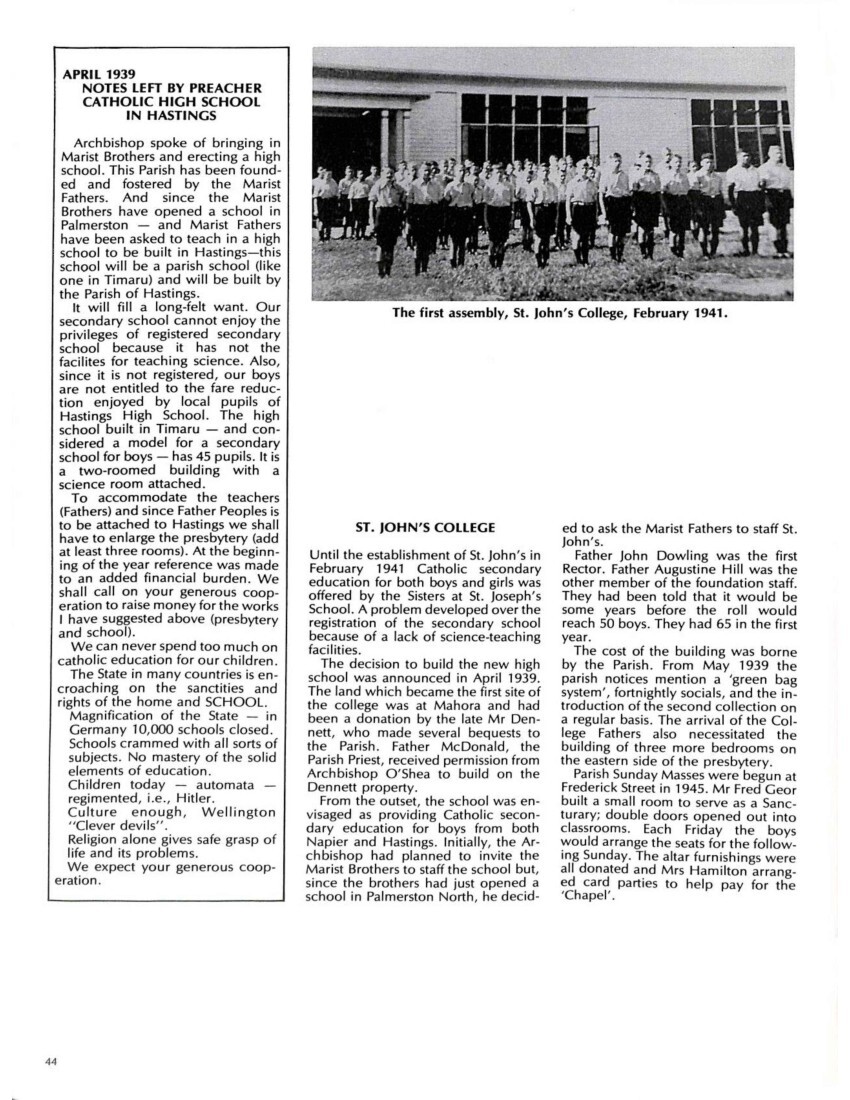
Page 45
PURCHASE OF JERVOIS STREET SITE
Father Milligan recalled:
“When Father Hill was Rector, several attempts were made to secure additional land at St. John’s….Land Sales were still in operation and there was little prospect of securing available neighbouring land at Land Sales prices.
“In the meantime I happened to hear from Cyril Martin that the property in Jervois Street might be available. He told me that the land in question had been under offer to Father McDonald some years previously, but he had been set upon the Frederick Street site.
To me this property seemed to offer a solution to problems that were looming large. The primary school in Eastbourne Street was becoming overcrowded. Infants had to travel from Mahora to the convent. They had to cross busy streets and a railway. If we could turn St. John’s into a primary school and build a new St. John’s at Jervois Street it would go a long way to meeting the problem.
“I approached Mr Jack Blake who was administering the property, which was a family trust. He feared that there would be some pressure brought to bear by the Housing Department to acquire land for housing. He preferred that we should have the land rather than the Government. Having obtained the consent of the other owners he offered the land at somewhere in the vicinity of 2,000 pounds.
I immediately prepared the case for the Archbishop, quoted the number of Baptisms, the percentage of them that we could expect to come to a Catholic school, and proceeded to Wellington. He was in agreement in principle, asked only that he should be given a map of the district showing the location of the new site in relation to the rest of the town.
“Meanwhile, I visited the Mahora area to find out how many children could be expected to attend the school in Frederick Street. I was surprised to find how few children were in the area. So I wrote to the Archbishop recommending that the new site in Jervois Street be held in the meantime, that the girls’ secondary school in Eastbourne Street be proceeded with immediately, and that St. John’s be changed to Jervois Street in five year’s time.
“I received a letter in reply, just before by transfer, agreeing to the plan and stating it was binding on myself and successors.”
ST. JOHN’S AT JERVOIS STREET
It was while Father Gill was Rector of the College and Father Hendren was Parish Priest that the decision was made to transfer the college to the Jervois Street site. John Scott was the architect and Peter Bridgeman was the builder. Archbishop McKeefry opened the new college on September 23rd 1956. The octagonal chapel was opened the next year. Thereafter Mass was said each Sunday at St. John’s for the people of the Mayfair area. This extra Mass relieved the overcrowding at the Sacred Heart Church and continued until the Sunday Mass at the Holy Family Home was put back to ten o’clock and parishioners were invited there. The St. John’s chapel was cleaned and readied for Mass each Sunday by Eileen Malone. Miss Mary Aldridge took over in 1965 and still does the task assisted by Mrs Doone O’Sullivan.
Today the Rector of St. John’s is old boy Father D.A. Taylor. The staff comprises both lay staff and Marists and the roll is about 360. Now the college is a regional school but for nearly 30 years the Parish of Hastings assumed full financial responsibility for its establishment, transfer and development.
Opening of the new St. John’s, Jervois St., 23rd September 1956. Fr. Gill and Archbishop McKeefry and from left: Anthony Loughnan, Gerard Caccioppoli, Anthony Malone, Peter Unverricht.
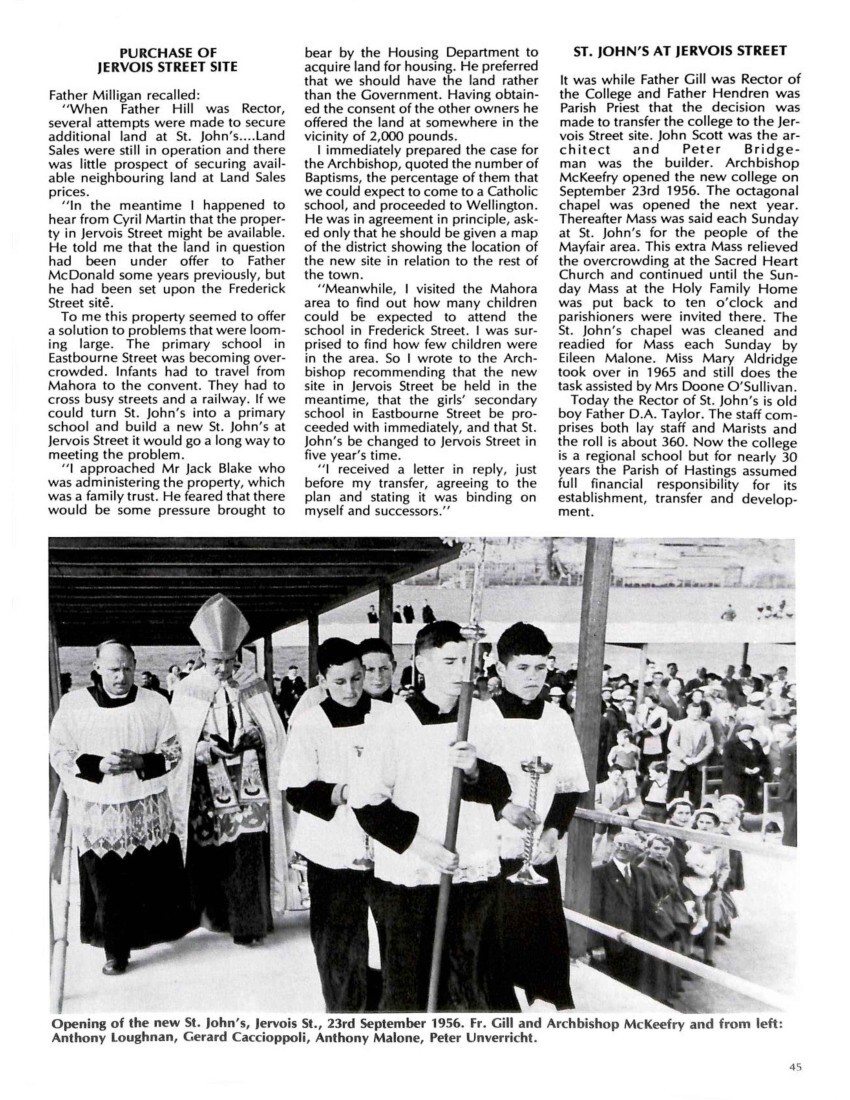
Page 46
FATHER LEO SPRING
Father Spring arrived in 1948. He was already known to many of the men of the parish because of his war service as Chaplain in the Middle East and Italy. He found himself Pastor of a parish that was experiencing significant post-war growth. Provision had been made for development by Father Milligan. The primary role was increasing. The immediate plan was to build a new secondary school for girls and let St. Joseph’s Primary move into the vacated secondary classrooms.
The hall received immediate attention and a programme of weekly dances became a feature of parish life. These dances had the two fold aim of fundraising and of providing opportunities for younger parishioners to meet one another socially. A team of ladies were rostered to provide supper, teams of men manned the doors.
The new high school built, the primary children quickly took over the extra classrooms, although the hall had to be brought back into commission for a classroom.
Father Spring was Parish Priest when the Little Sisters of the Poor arrived. The existing Holy Family Home owes much to his enthusiasm and drive.
At the end of 1953, Father Spring’s term of office was up. But he soon returned to Hawke’s Bay to be Parish Priest of Napier for six years. He died in Wanganui in 1968.
It is hard to think of Father Spring without recalling his deep voice and ready laugh. He delighted in overcoming obstacles and bored company. Sometimes impatient with trivia he excelled in time of crisis. It is recalled that as a seminarian he quickly took charge at Greenmeadows at the time of the earthquake and secured help for the injured. Hastings people would not be surprised to hear that.
FROM THE HISTORY OF TENISON
Photo caption – One of his great achievements was the completion of St. Joseph’s High School for girls.
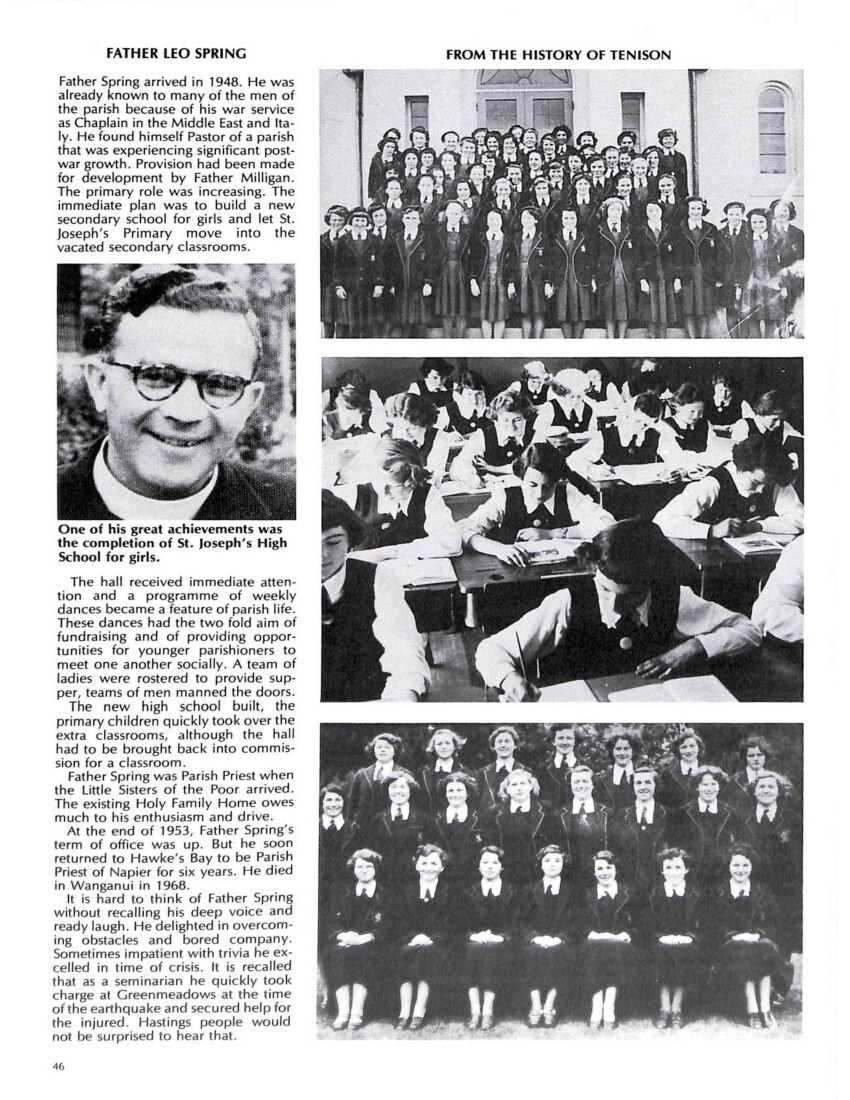
Page 47
TENISON COLLEGE
Tenison College was born out of the vast enterprise of Catholic Education that was established and carried out by the Sisters of St. Josephs of Nazareth in 1889. Father Milligan began the transfer of the secondary girls from the two classrooms at the end of the St. Joseph’s primary block. Father Spring took up the challenge, and 1950 saw the completion of the main block which was officially opened the next year. The roll then was 60 students, Sister Carmel was the first Principal and Sister Genevieve was her assistant. In 1956 Sister Annunciata arrived to become Principal and she remained so for 14 years.
Increases in the roll led to the use of a house fronting Heretaunga Street and in the 1960s a new classroom block and a laboratory block were added.
The roll continued to grow. The High School changed its name to St. Joseph’s College. The college secured authority to accredit students for University Entrance.
In 1969 there began a closer association with St. John’s. This involved the exchange of senior pupils, thus widening the curriculum of both schools. Hitherto links with St. John’s had been at a social level only, although 1966 saw the first of the many musical productions involving pupils from both colleges. 1969 also saw the college adopt the name of Tenison, after the founder of the Sisters of St. Joseph, Father Julian Tenison Woods.
In 1976 the roll of the college reached 260 and properties in Eastbourne Street were brought [bought] and developed as playing fields. Sister Carmel had returned for a second term as Principal before handing over the school to Sister Catherine Anne, herself an old girl of the college.
For some time it was thought that Tenison would combine in a co-educational venture on the site of St. John’s. Finally, for reasons of cost and because of the shortage of Sisters, Bishop Peter Cullinane announced the closure of the college in 1980. Girls from Tenison transferred to Sacred Heart College, Napier, and to local state secondary schools.
Pictures from 1951, 1953, 1955, and the Prefects of 1965.
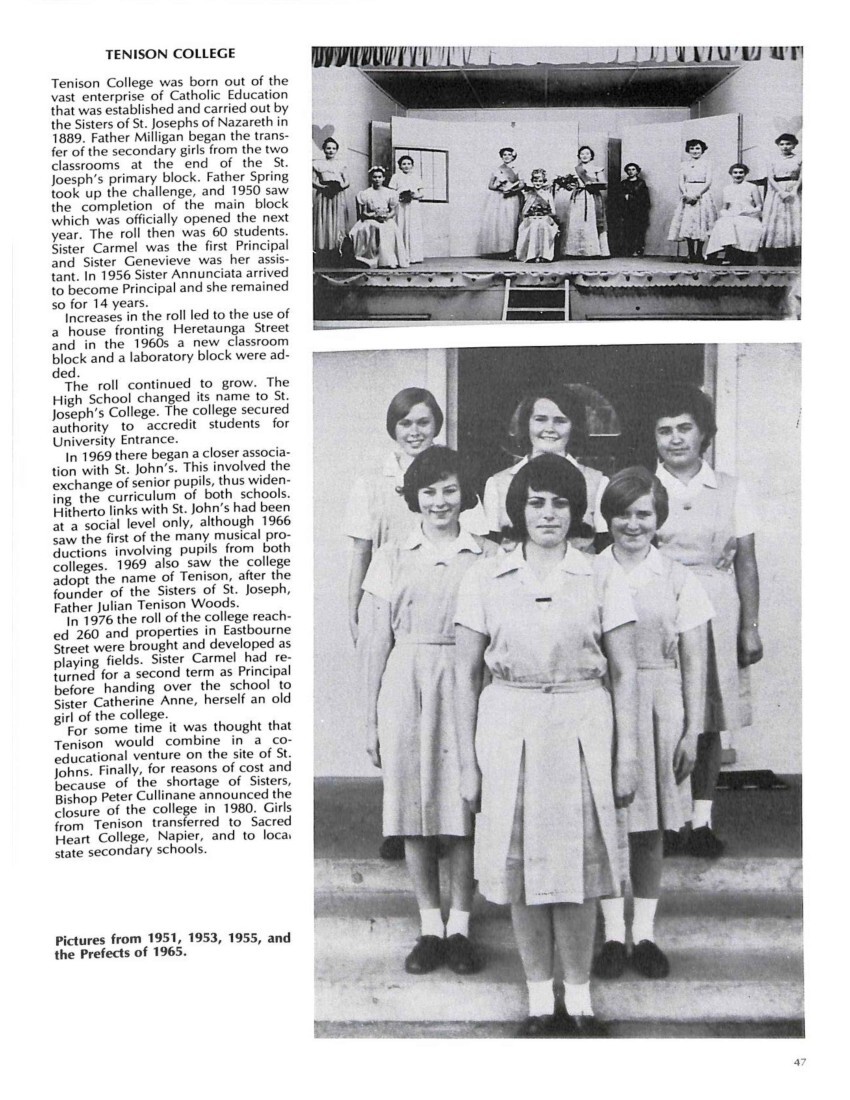
Page 48
A PROMINENT FAMILY
Jack Blake was an outstanding member of the Celtic Football Club in the twenties, and an even more prominet [prominent] member of the developing Parish of Hastings over many years. Jack is the last surviving son of Mr J.T. Blake who arrived from Taupo in the early nineties, taking up his work as a surveyor, land agent and native interpreter. He established his home in Avenue Road, where he also kept his racehorses and stables. His five sons, of whom Jack is the second youngest, all went to the convent school, then officially known as the Sacred Heart School. From Hastings all the Blake sons went on to St. Patrick’s College, Wellington. Jack recalls that he won a prize for class work at the convent, but that his academic abilities seemed to be undiscovered at college. He recalls too the plantation of silver poplars across the road from the convent (the present site of Wardells) where the boys fought their battles well-screened from the eyes of authority.
Mr J.T. Blake acquired from Waikare Karaitiana a large piece of land on Jervois Street. It was this property, sold by Jack Blake to Father Milligan, which is the site of St. John’s College. J.T. Blake also had property at Havelock North, which he sold to the parish as a site for the present Church and presbytery.
In the Sacred Heart Church there is a window donated by J.T. Blake on the occasion of the laying of the foundation stone in October 1894. This is a constant reminder of a man who has had an important influence upon the parish. His son Jack, well-known throughout New Zealand as an All Black in the twenties, is even better known in Hastings for his involvement in parish affairs. His influence was dynamic in the building of the Memorial Baths and Tenison College. He was a personal friend of many of the Marist Fathers and still is. He worked in close harmony with the various Parish Priests to the advantage of the parish. His daughter, Mrs Margaret Roberts, has inherited the Blake loyalty and generosity.
Mr. H.B. POPPELWELL
Harry Bell Poppelwell is one of the ‘identities’ of Hastings, where he has lived all his 83 years. His parents Sebastian George Poppelwell and Margaret Dorothy Pearse were married in Napier 26 June, 1889 by Father Grogan S.M. He did all his schooling at the Convent School, Hastings. Father Keogh S.M., the parish priest, tried to persuade him to go to St. Patrick’s College, Wellington, offering financial help for this purpose, but at an early age Harry declared his intention to be a draper. The good priest, a little disappointed, philosophised that ‘people would always need clothes’, and advised him, that if he was determined to be a draper, then ‘be a good draper’. This advice was followed out thoroughly. Harry was always a keen sportsman. As a boy he was a member of the Shield winning Convent rugby team. Later, because of circumstances, he turned successfully to Hockey, first of all as a player then as an administrator. He became President of the Hawke’s Bay Hockey Association. He was always a keen swimmer and with Father Seymour, Jack Blake, Phael Geor and Felix Hodgins built the Convent Memorial Baths. In time he became President of the Hawke’s Bay Swimming Association and Vice-President of the New Zealand Swimming Association. Boxing was another interest, and for some years he was on the executive of the Hawke’s Bay Boxing Association.
Harry has always been interested in civic affairs, so it is not surprising to see him as founder and first President of the Society to promote Greater Hastings. The Highland Games and the Blossom Festival were fruits of this enterprise. As a member of the Hastings Operatic Society he travelled New Zealand with the opera ‘Marama’. During the war years he entered yet another field as President of the Patriotic League, which was engaged in raising funds for patriotic purposes. All this is an indication of the vital versatility of a public spirited man. But this is not all. He has been involved in nearly every good cause for the Parish of Hastings. His experience on committees and his knowledge of Hastings have been invaluable. Church and School have found him ready to assist where there was the need. Harry is a sprightly 83, enjoying retirement which retains an active interest in the affairs of Church and City and of the world of business.
PHAEL GEOR
Any account of the history of the parish would be incomplete wihtout [without] the acknowledgement of the great debt the parish owes to Phael Geor. Like that of his friends and co-workers, Jack Blake, Harry Poppelwell and Felix Hodgins, his support of the parish was varied, loyal and unselfish. Phael would be the last to have his praises sung, but some brief record of his work could serve as an inspiration to others.
For eleven years he was president of the Holy Name Society when it was at its peak, when 400 to 500 men would pack the Church at meetings. He was chairman of the Charity Ball for a long term and organiser of the Queen Carnival to raise funds for St. Joseph’s Secondary School for girls (later Tenison College). In fact his genius was shown in his ability to organise various fund-raising activities. Phael was a strong supporter of St. John’s College both at Frederick Street and Jervois Street. The School Baths was an important project for him. Many will remember him as chairman of Father Peyton’s Rosary Campaign, a founding member of the Hibernian Club, a fund-raiser for the Island Missions. With the men mentioned above he raised funds for the Memorial Baths, and with Les Willis he organised the regional swimming competition for Catholic Schools. Father Cyril Taylor will remember the help given for the establishing of the Catholic Tennis Club. Add to all this that he was a foundation member of the first Pledge Committee, and later, was on the committee of the Sacred Heart Restoration Committee, and we gain some idea of the dynamic involvement of Phael in the life of the Church in Hastings, a man who always found time to assist yet another good cause.
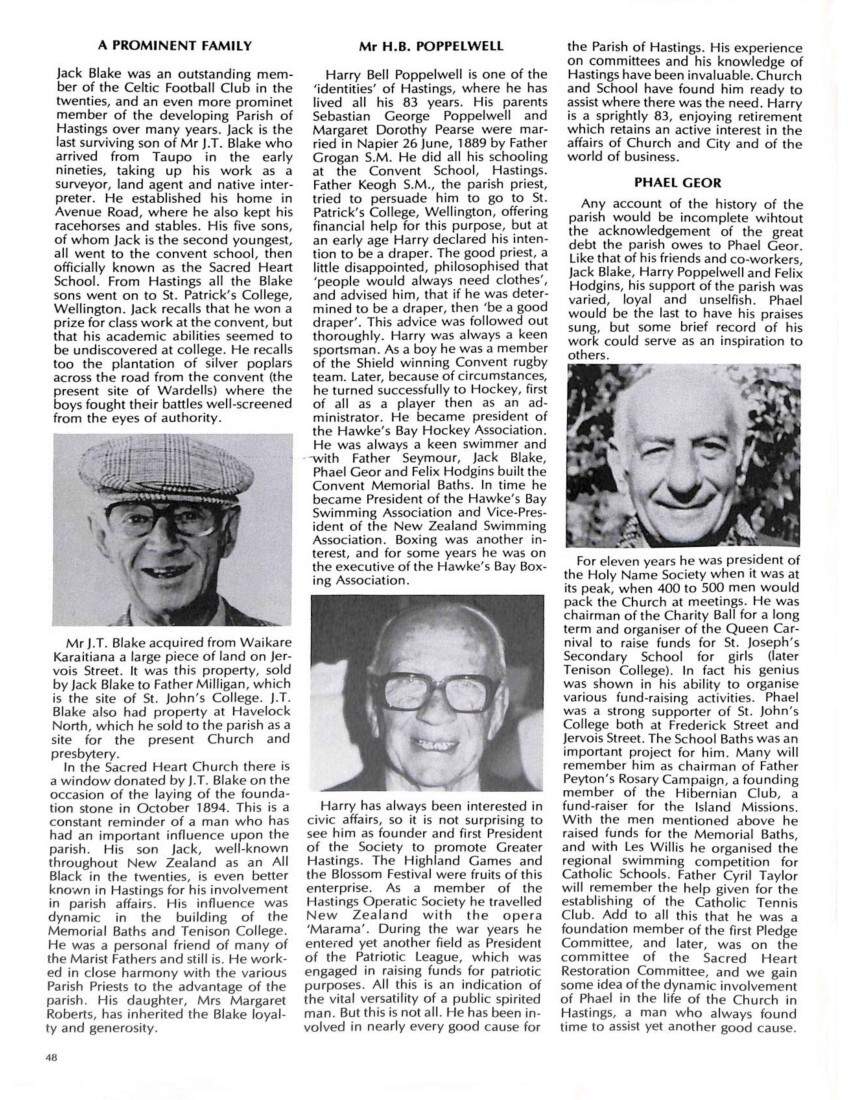
Page 49
MRS MARY BRUNTON
Mary has been a familiar face at the Presbytery for many years. In 1961, Father Geaney S.M. who became Parish Priest, visited her to ask if she would help out at the presbytery ‘for a fortnight.’ She remembers the day clearly when Father Geaney came to her door saying, “I’m not much good at humility, but I humbly ask you to come help us for a fortnight”. She has been there ever since. She has many memories of the priests she came to know over the years. There are more than a hundred of them. Her recollections of people and events connected with the Presbytery would make an intensely interesting book. Congratulations Mary, on your well-deserved Papal Award.
MRS DOROTHY O’CONNOR
Dorothy O’Connor is an example of those many people who accomplish a great deal, quietly. A great part of her life has been devoted to looking after priests, even though, in fact, she did not plan to do so. She went to the Meeanee presbytery on 15 August, 1937, to help Father Riordan S.M. for a few weeks. She stayed five years. She went to the Mission Station at Jerusalem on the Wanganui River for a holiday and rest. She finished by housekeeping for Fathers Cullinane and Te Awhitu for several years. Back in Hastings she has spent a great part of her time in ‘helping out’ at the Presbytery apart from other involvements. In honouring Dorothy O’Connor, the Presbytery honours all those faithful women who have attended to their needs, foibles and phantasies [fantasies] over the years.
Photo captions –
Mrs Hamilton. Dedicated supporter of St. Johns.
New Zealand’s first woman telegraphist.
Mary Brunton
Dorothy O’Connor.

Page 50
Community of the Little Sisters with members of the Catholic Womens’ League
C.W.L. Members: Front: Kitty Buchanan; Mrs O’Connor.
2nd row: Eileen Kidd; Eileen Malone; Kath Fitzgerald
3rd row: (right to left): Rosalie Taylor; Molly Gunn; Mrs Gibson; Mrs Hutchins; Mrs Fieldsend; Mrs Begley; Mrs Brimer; Mrs Kennedy; Mrs Minogue; Mrs Shadbolt.
Back: Mrs O’Connor; Mrs O’Kane; Colleen O’Neill; Miss G. Begley; Eva Martin.
CATHOLIC WOMEN’S LEAGUE
On 14 April 1953 the Parish Priest, Father Spring, S.M., called a meeting of the Catholic women of Hastings and the local branch of the Catholic Women’s League was formed. An enthusiastic and capable first committee was formed consisting of Mrs Berta Begley, president, Mrs A. Geor and Mrs M. Hodgins, vice-president, Mrs M. Esam, treasurer, Mrs E. Meining, secretary. The committee comprised Mesdames N. Hamilton, S. Green, B. Houlihan, I. Cowan, Misses M. Flynn, N. Thomson and M. Cassin. With these leaders, the league flourished, and members soon totalled the goodly number of 300.
A feature of the early history of the League was the number of Circles which were set up covering a wide variety of activities; Mission Circle, Discussion and Literary, Arts and Crafts, Music and Drama, Cards.
The League became affiliated to the National Council of Women in its first year. This gave Catholic women an important voice in women’s affairs in the country – a voice which they still intelligently use.
The various Circles were active and well patronised. There were courses in millinery, cake decorating, floral art, basketmaking, singing and drama. Strong friendships were formed and great enjoyment gained from participation in various fields.
The Mission Circle was a particularly enthusiastic group. The first convenor was Mrs M. Stilburn, and then Mrs Sally Green inspired the group to great effort in gathering goods and raising funds for various missions. After a time the League Council saw the need for rationalising the efforts of various branches for fear that some missions might be neglected. Accordingly the efforts of the Hastings C.W.L. were directed to Moa Moa in Western Samoa and to Paki Paki in New Zealand. The minutes of the C.W.L. give an inspiring account of the generous activity of the Mission Circle.
It is worthy of remark that old and young mingled exceedingly well in the early days. The Homemakers Circle, formed in 1959, gave a fine opportunity for bringing together younger mothers in a relaxing and congenial atmosphere.
In 1969, the National Executive of the C.W.L. felt that the primary object of the C.W.L. was in danger of being forgotten, and asked all branches to dissolve the circles. This was complied with.
In the earlier days of the League, before the advent of Parish Councils, League members were involved in every aspect of parish activity and community work – mending altar linen, catering at charity balls, supporting State-aid campaigns, support for the Little Sister’ [s’] Home, helping the I.H.C., Civil Defence, Birthright, and Corso. They gave substantial gifts at the opening of the Holy Family Chapel, donated the Stations of the Cross to St. John’s Chapel, and in 1960 gave to the Sacred Heart Parish an Antependium and Tabernacle Veil which they had received from an Italian town in recognition of help received from the League in Hastings.
In recent times various factors have contributed to a decline in membership of the C.W.L. The attraction of television, the fact of working mothers, the involvement of women in Home and School committees are only some of the things that have had an effect on membership. It is well to remember that the C.W.L. is the only Catholic national body for women in this country, and if all Catholic women supported it they would have a strong influence in contentious issues raised by Government and other groups.
The motto of the C.W.L. is ‘Faith and Service’ – deep faith in God and a faith-inspired service of our fellow man. These are the principles of evangelisation to which our Bishop Peter Cullinane called the C.W.L. at the Regional Conference of 1982.
In this centennial year, the parish of Hastings is grateful to the women of the League for their near 50 years of unselfish contribution to a great hundred years of history. It salutes the Presidents, the Secretaries, the Treasurers, and Committee Members over those fruitful years.
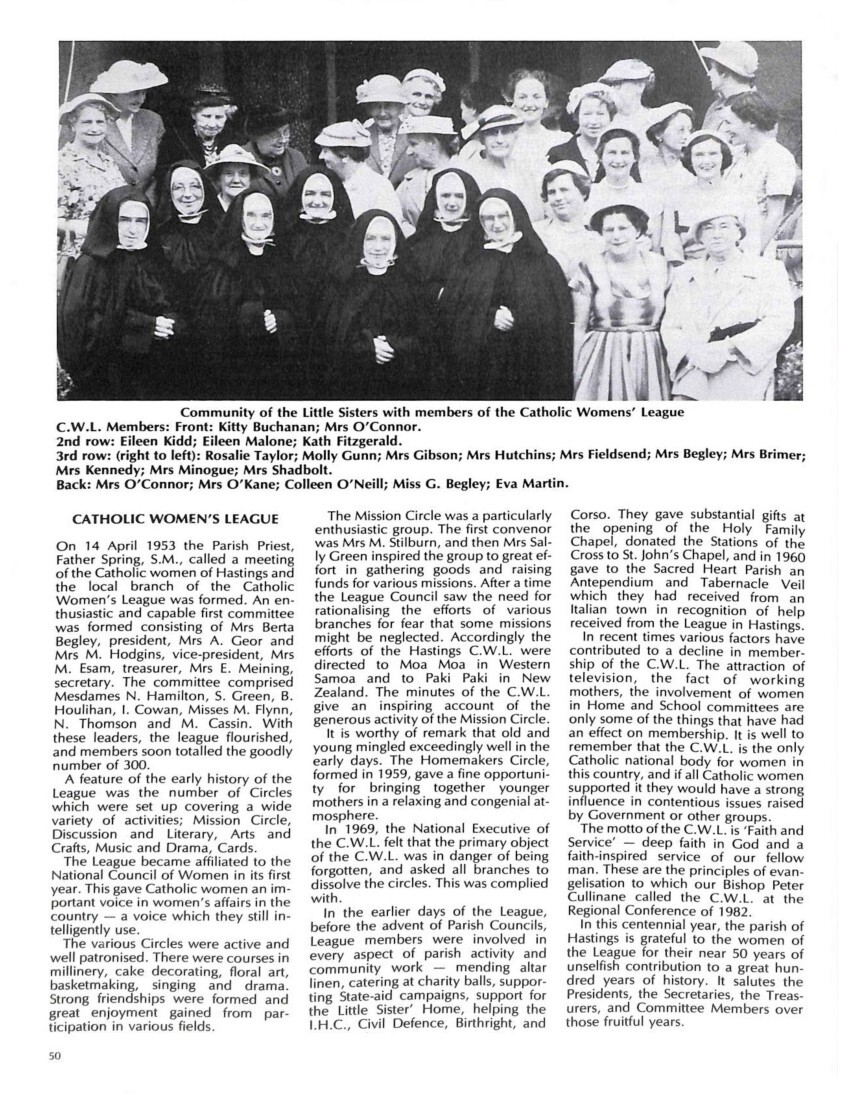
Page 51
QUEEN CARNIVAL
The parish seems to have been always in need of funds, and some needs more critical than others. In Hastings the need has been greatest in the educational sphere. It is part of Providence to provide the right men at the right time to meet the needs that arise. This has happened in Hastings. The parish has been fortunate to have men like Fathers Milligan, Seymour, Spring and Hendre[Hendren], aided and abetted by dynamic helpers among the laity. Among the latter, Phael Geor and Fred Geor were more than prominent. Among the successful ways they had of ‘extracting’ money from willing and unwilling benefactors was the method of the Queen Carnival. Older parishioners will easily recall the excitement and the competition of those days, capped by the Coronation of the Queen of the Carnival.
Coronation of Queen of the carnival.
Back: Bernadette Hutchins; Marie Geor; Eleanor Bridgemen.
Front: Peg O’Donoghue.
Carnival Coronation Ceremony, 3 December, 1949
Left side, back row: Page girl, Jim Stopforth; Pauline le Seuer; Marie Geor; Rosalie Geor.
Front: S. Willis; Helen Hannah; Mark Horton; Pauline Laredo; Rosemary Blake.
Middle: Guy Hardenberg.
Right side: Michael Moloney; Eleanor Bridgeman, (seated); Greta King; Lorna McKeegan; Peg O’Donoghue.
Front: Mary Wishart; – Wishart.
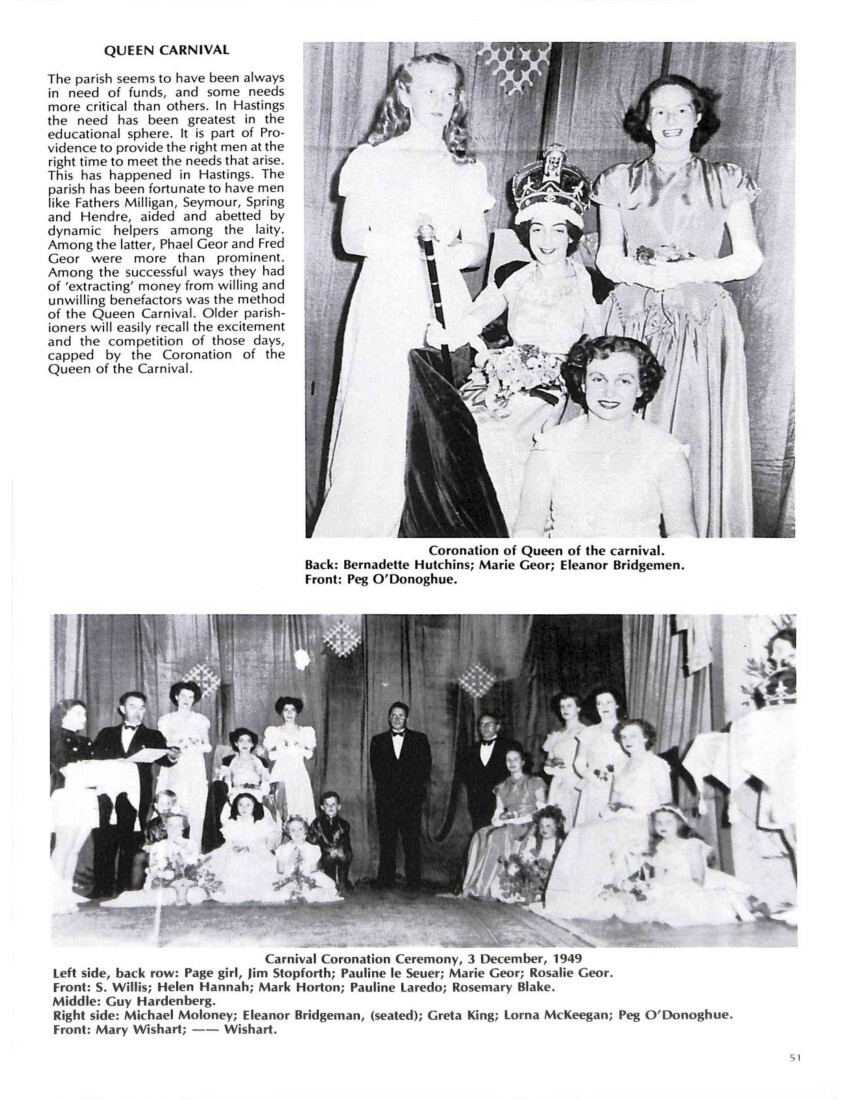
Page 52
THE CHARITY BALL
A successful and even spectacular part of the work of the St. Vincent de Paul Society was the introduction of the Charity Ball to Hastings. Much organisation and work was required, but each Ball was voted a highlight of the parish social life. The preparation of the debutantes was always in the capable hands of Mrs Admah Geor, and every debutante who passed through her hands owes her a debt of graditude [gratitude] for their training in some of the social graces. A great value of the Charity Ball was the spirit of cooperation engendered in the parish. Also the opportunity was given for many people to meet their religious leaders, Archbishop McKeefry, Archbishop O’Shea and Bishop O’Neill.
Mrs Admah Geor and the debutantes for the Charity Ball, 1971.
Charity Ball, 1957
Official Party, left to right: Mr M. Moloney; Mrs M. Moloney; Mr E. Keating, M.P.; Mrs Kirkpatrick (Mayoress); Fr. J. Hendren, S.M., P.P.; Archbishop McKeefry; Mrs J. Stopforth; Mr J. Stopworth; Mrs E Keating; Mr Kirkpatrick, Mayor.
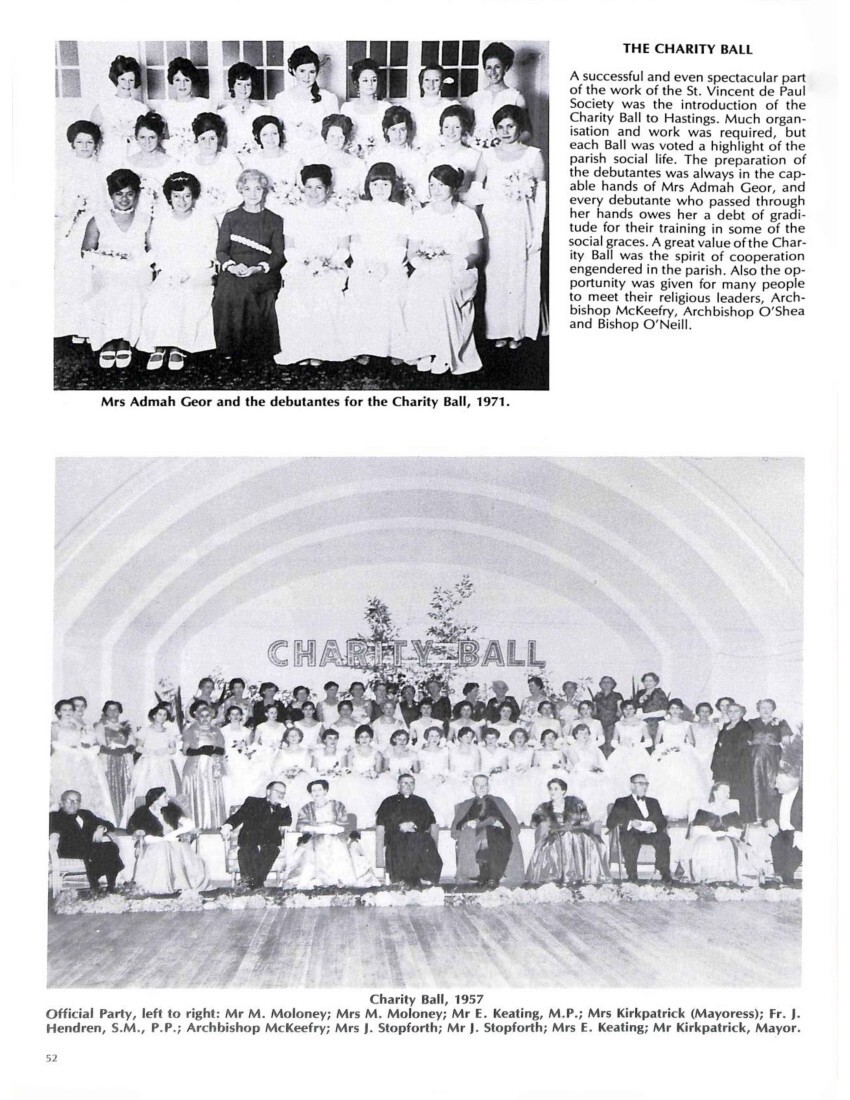
Page 54
THE HOLY NAME SOCIETY
This sodality for men and senior boys was a major feature of parish life in Hastings until its demise, along with other sodalities, in the 1960’s.
The Holy Name men had a monthly Communion, annual breakfasts, regular meetings. They walked together in religious procession and formed part of a diocesan and national body. It was the Holy Name Society that sponsored the ‘Hear the Case’ petition to Parliament which was presented by Mr W.S. Otto in the early 1950’s seeking State aid for private schools. Holy Name men took an active part in Father Peyton’s Family Rosary Crusade when he was in this country.
Parish records point to reliance of the parish on the Holy Name Society for Church cleaning and for the taking up of the Penny Collection for the schools over many years.
In its later years the Holy Name Society had its most faithful worker in Mr Dick Cassin. Dick was secretary for many years and would man a table outside Mass on Sundays selling the Holy Name Monthly.
The earliest records of the sodality remaining in the parish date from 1924. At the March meeting in 1925, 71 members were present. In August 1937, 54 were present. The minutes of 1937 note: “Our Director presided and considered it fitting, as summer is approaching to speak about girls going bareheaded and thus being unable to enter the Church.”
During the war the blackout forced the Children of Mary to meet in the afternoon, and numbers varied at meetings then from between 35 and 50 members. After the war, numbers attending rose to 70.
The sodality continued to 1967 when it went into recess.
ST VINCENT DE PAUL SOCIETY
On Sunday, 21 March 1909, a meeting was held in the presbytery to reorganise the St. Vincent de Paul Society, and, as stated in the minutes of the day, “To endeavour to keep more strictly to the Rules”. The members of that time had already been doing the work of the Society, but this meeting marks the official beginning of the Society in Hastings.
Members of that time were Messrs Blake, Dennet, Donovan, Hennessy, Scanlon, O’Brien, O’Leary, and Kennedy. The secretary was C. Gallagher, and the spiritual director, Dean Smyth.
As well as visiting the sick and needy of the parish, one of the first things done by the new Society was to join the Catholic Truth Society, and erect a box in the Church porch for the purpose of selling religious books. The minutes of a meeting held on 5th April 1909 state: “The books at the door were all disposed of, after the second Mass; this was considered more than satisfactory, and the money in the receiving box amounted to seven shillings and three pence, which was also highly satisfactory. The doorkeepers showed that it was necessary for them to be present, and order was thoroughly kept”.
Since those days the Sacred Heart Conference of the Saint Vincent de Paul Society continues to assist the sick and needy of the community; a ladies’ group also assists many a deserving case and an Opportunity Shop and a Night Shelter are also in operation.
Although many good parishioners have served as members of the Society over the years one name is worthy of special mention, that of Michael Moloney. Michael was a driving force of the Society for many years, and it was through his efforts that a property in Avenue Road East was purchased. On this property are found the Opportunity Shop and the Night Shelter. The Conference meets weekly on Monday evening, while the Ladies’ Auxiliary Conference meets fortnightly. The members are mindful of the sterling work of the stalwarts of the first century of parish life – Michael Moloney, Jim Stopforth, Pop Koorey, Harry O’Kane, Reg Yates, Tom Hannah and others, and are fully prepared to play their important part of assisting the poor and needy of the parish, in the years that lie ahead.
Dynamic Vincentians, 1960
Back: Ernie Hodder, Dick O’Connell, John Horan, Stan Schollum.
Front: Joe Devoy, Kevin Bryant, Michael Moloney, Frank Fitzgerald.

Page 55
SACRED HEART LADIES’ CONFERENCE
St. Vincent de Paul Society, Hastings
It is a fortunate coincidence that the Centenary of the Parish and the Golden Jubilee of the Ladies’ Conference occur the same year. On 16 April 1882 the Sacred heart Church was opened. On 3 April 1932 the Ladies Conference was officially established.
Well before 1932, various ladies of the parish had engaged in the work of the Society. Devoted women like Mrs Helena Halligan and Mrs Teresa Wright had helped in the immediate post-World War I year, visiting the sick, and delivering on foot, parcels of clothing and food. A sewing machine was set up in a classroom of St. Joseph’s School, as far back as 1922, for the sewing of clothes for the needy. Came the depression years and the ‘31 quake; Mesdames Kath Ingram, Mary Aldridge and Dorothy O’Connor, with the ladies mentioned above, were truly valiant in the enterprises of the Society. Parcels were delivered on foot or on bicycle. The ladies’ sewing machines were working hot and late, turning out uniforms for the school children in those desperate years of poverty and unemployment, when men were living in tents and makeshift shelters along the local river banks. The need was great, the Ladies’ Conference most active.
Came World War II, with its spate of knitting for Army and Air Force. Mrs Mardy Kelly and Mrs Kath Retson were in the forefront of home activities, together with Mrs Elsie Adams and Mrs Sheila Fitzgerald. Older members recall how Mrs Mary Hodgins used to cycle to Whakatu and Paki Paki to help those in need. They remember too the planning and the sharing of hard work in the preparation of the Charity Ball, which became a feature of Vincentian activities in Hawke’s Bay as well as other places. In this context the work of Mrs Admah Geor in preparing debutantes must not be forgotten.
A permanent bargain shop has been a successful source of revenue. Various volunteer and employed ladies have kept the shop running efficiently, among them Kath Ingram, Joy Marriott, Violet Hodder, Nell Moloney, Miriam Gunn, Daphne Olsen, and most recently Shirley Moffatt.
A centennial magazine can but record briefly and inadequately the wonderful work of the women, mostly Catholic, sometimes non-Catholic, who have worked in the spirit of faith to serve others. The parish thanks the ladies of the Conference, and congratulates them on their Golden Jubilee. Their reward is found in the words of Our Lord: “I tell you solemnly, in so far as you did it to one of the least of these brothers of mine, you did it to Me.” “Take for your heritage, the kingdom prepared for you from the foundation of the world”.
St Vincent de Paul shop, Avenue Rd.
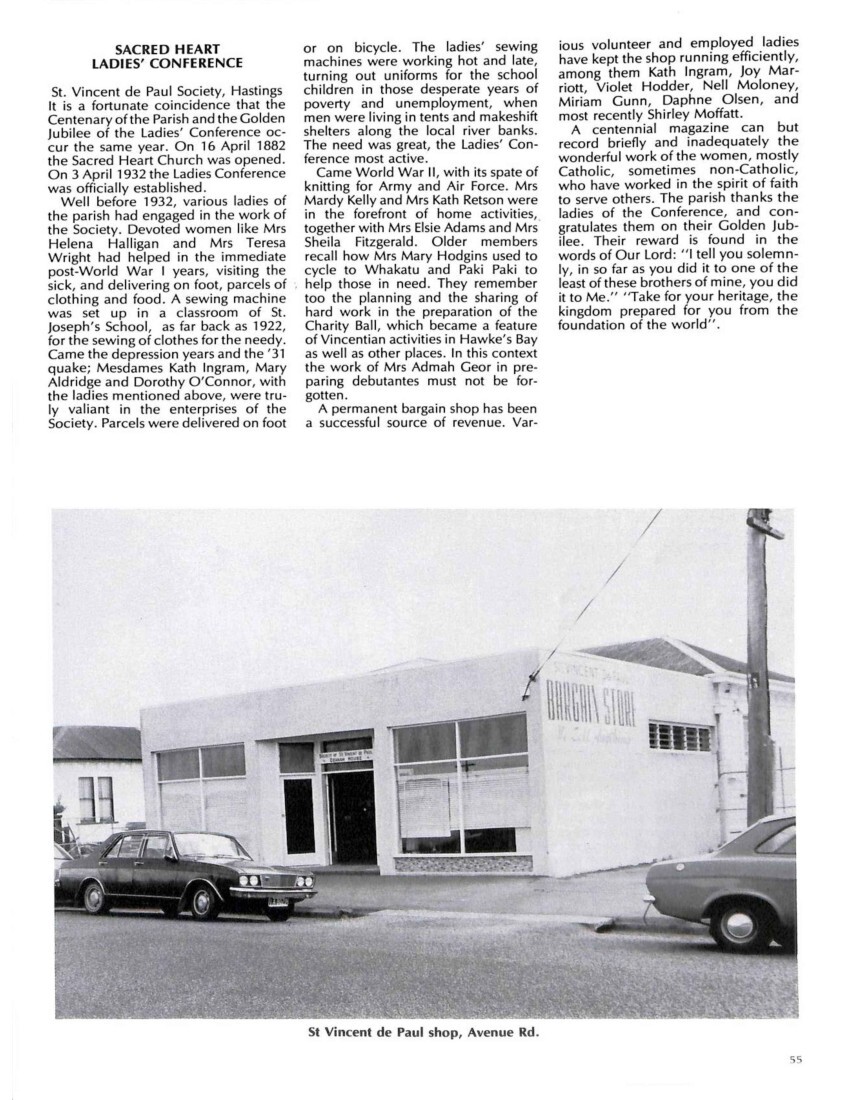
Page 56
HOLY FAMILY HOME
The initiative, that resulted in the erection of the Home for the Aged in the parish, lies with Mrs Hartnett who wished to leave her home on the corner of St. Aubyn and Miller Streets as a home for elderly people. Her proposal was taken up by the St. Vincent de Paul Society and Father Spring. It was realised that the Miller Street property was too small but there was clearly the need for a Home for the Aged.
When proposals were put to Archbishop McKeefry he told Father Spring to find a suitable property and he (the Archbishop) would find an Order of Sisters to staff it.
In July 1952 Father Spring purchased, on behalf of the parish, Dr. McPherson’s property in Wolseley Street. It comprised a twelve-roomed, two-story house and three-and-a-half acres of land. A further quarter-acre section giving frontage to Grove Road was purchased at the same time. The total cost was 6,000 pounds.
The Archbishop secured the agreement of the Little Sisters of the Poor to start a Home for the Aged by April 1953.
The Little Sisters arrived and almost at once began to care for some elderly ladies. They began collecting for the splendid home that today is a major feature of parish life. The parish handed the property over debt free to the Little Sisters.
The first Superior at Holy Family was Good Mother Marie. Then Good Mother Constance succeeded her and the new home began to become a reality. Government subsidies were secured, money was collected, plans drawn up and tenders left.
The opening of the home in 1961 was a major event in the community. Present were the Apostolic Delegate from Sydney, the Prime Minister and the Leader of the Opposition.
For a time the Little Sisters conducted a juniorate for girls desirous of joining their community. The girls lived at the Holy Family Home and attended classes at St. Joseph’s High School in Eastbourne Street.
In time, Holy Family Home became a Mass Centre for the parish. As well as caring for over a hundred residents, the Little Sisters and their lay staff associates provide a day-care service for the elderly people of the city.
Mr Walter Nash, Prime Minister, at the opening of the Holy Family Home.
Archbishop Furstenberg, Apostolic Delegate, opened the Home.
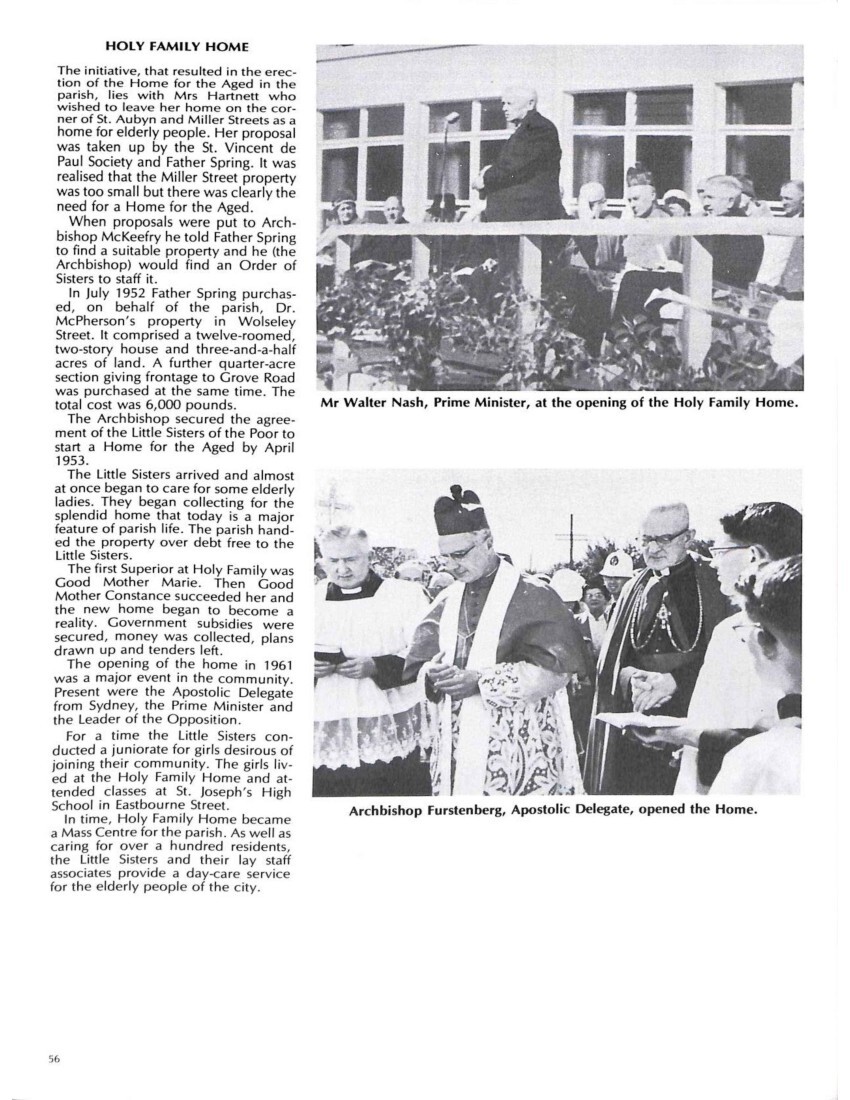
Page 58
FATHER J.O. HENDREN, 1955-1960
Father Hendren arrived at Sacred Heart from Whangarei. He was a man of patient determination and courage and almost immediately took up from Father Spring the role of driving force behind the spectacular development of the parish buildings.
In 1955 he purchased four acres at Gordon Road. This was to be the nucleus of the Church and Presbytery there. Further land was bought at Frederick Street and at Jervois Street. By August the Parish had 11 acres at Jervois Street and work was begun on the new St. John’s College. Frederick Geor’s men began work too on the new wing of the Presbytery.
The new St. John’s was opened in September 1956 at a cost of 34,000 pounds. Two classrooms at the old college in Frederick Street were converted into a Church. St. Mary’s, Mahora, was to continue to be a Mass Centre until the building of the Church of Madonna Maria nearly 20 years later.
Then followed the building of the Church Hall at Whakatu (1957), the opening of the Saint John’s Chapel, and the start of the St. Mary’s Catholic Primary School on the site of the old Saint John’s. Initially it took 103 children up to Standard three. Sister Clare was the first Head Teacher. The next year the roll at St. Mary’s had risen to 180 pupils and had classes up to Form II. Home and school associations were established at both St. Joseph’s and at St. Mary’s and in 1959 the Convent at Frederick Street was ready for a community of Sisters. Up to this time they commuted each day from St. Joseph’s.
It was in 1959 that Father Hendren celebrated his silver jubilee in the priesthood. He initiated a parish paper called the “Parishioner” and had a special interest in the care of the Third Order of Mary. A grotto in honour of Our Lady of Lourdes was erected in the Church grounds. The Church at Havelock was opened, also dedicated to Our Lady of Lourdes.
Father Hendren’s final land purchases were to extend the property at Raureka as a future site for a school. He also arranged to buy the old Hibernian rooms for St. Joseph’s High School and to have a new science block built.
It was during Father Hendren’s time that the Christian Family Movement came to Hastings. It was brought here by the enthusiastic couple, John and Audrey Stevenson. Father William Buckley was the chaplain and the group soon made its presence felt with Cana and pre-Cana conferences and a symposium on vocational guidance.
Despite all the building and financial preoccupations, Father Hendren remained a dedicated Priest. His cheerful persistence saw the Catholic community of Hastings provide for its educational and pastoral needs for many years to come.
His achievements in Hastings were blessed with an immediate appointment to St. Mary’s, Wanganui, as Parish Priest. There he was to see the transfer of St. Augustine’s College to a new site.
Father Hendren is now a curate at Sacred Heart Parish, Timaru.
Our Lady of Lourdes, Havelock North opened by Mgr. McCrea.
Builder: P. Bridgeman, Architect: John Scott.
St. Theresa’s Whakatu. Builder F. Geor.
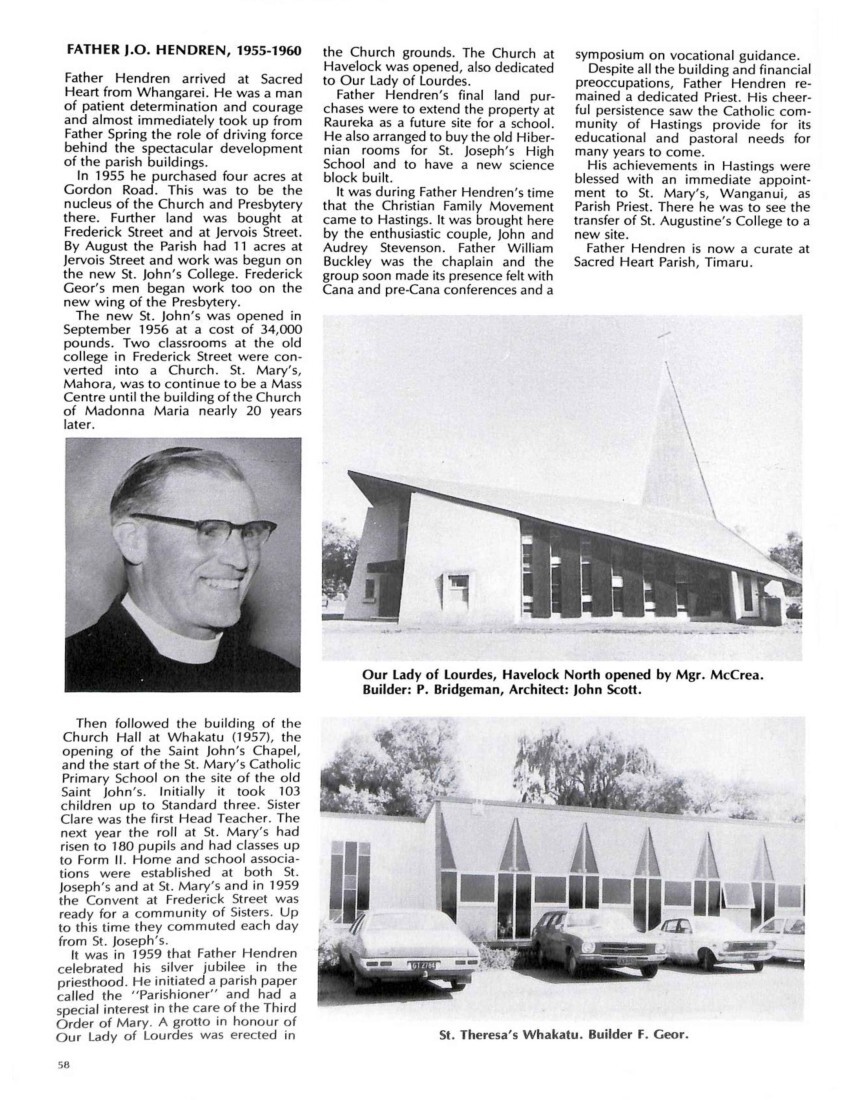
Page 59
Fr. Hendren with First communicants.
Frs. Spring and Kennedy with first communicants. 1st November, 1952.
First Communicants, 1967
Back: Fr. H. Geaney, Lorna Stairmand, Edna Stirling, Joanne McCarthy, Debbie Childs, Kare Hagerty, Julie Maggin, Jillian Hollerton.
Front: Elizabeth Fogarty, Jennifer Stephens, Sirena O’Donnell, Maree Quinn, Carolyn Beran, Cherie Saxon, Christiana Cassin.
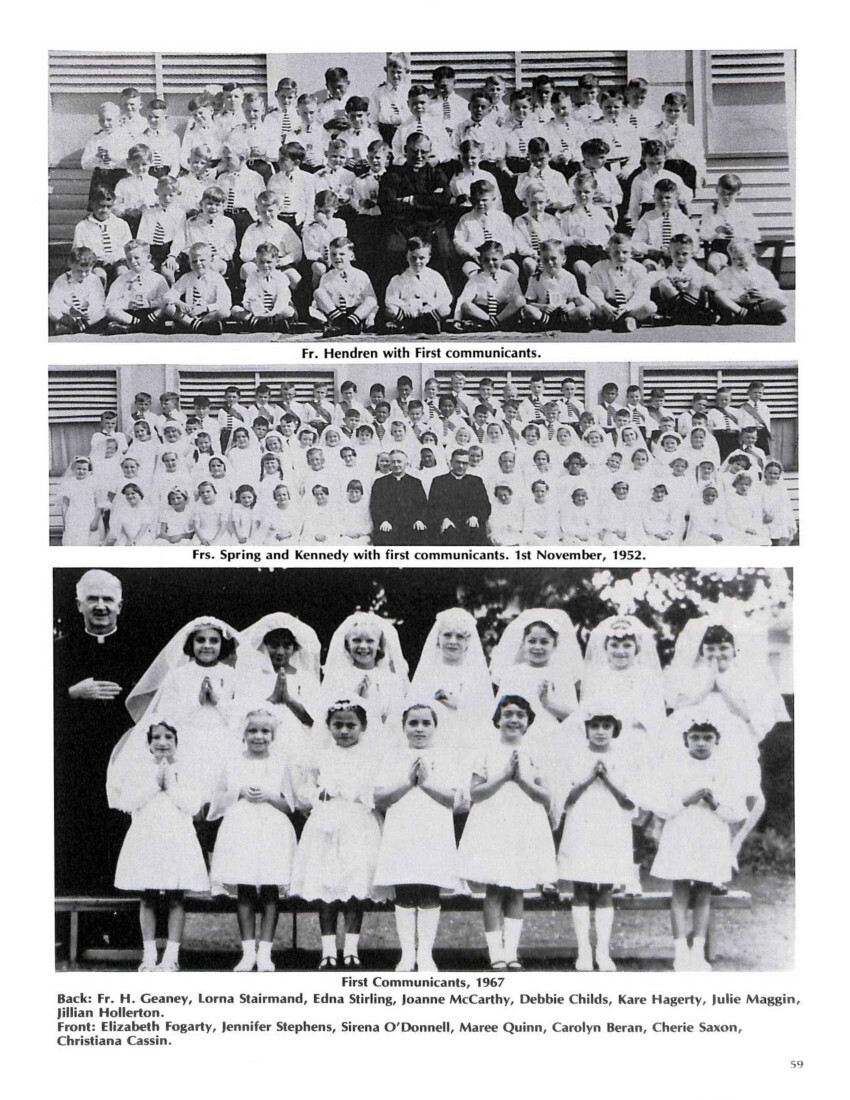
Page 60
FATHER HUMPHREY GEANEY S.M.
P.P. (1961-67)
Father Geaney came to Hastings first as a curate in 1960. Having got something of the feel of the Parish from Father Hendren, he was appointed Parish Priest in 1961. He brought with him a wealth of experience. An academic by background and training, he was able to grapple with the practicalities of parish life. His years in the teaching profession gave him a keen interest in the education of the Parish, and any scheme which would promote the good of schools found in Father Geaney a strong support. His sporting prowess matched his intellectual ability. Those who knew him in his early days found in him a doughty opponent on the football field, the golf course and the tennis court. It fell to his lot to bring about the first major division of Hastings into two parishes. Boundaries had to be established, a Church built in Gordon Road, and provision made to house the priests who would staff the new parish of Hastings West. It was largely owing to his efforts that the new parish got off to a good start in 1966.
Father Geaney always had a kind and practical interest in everyone and in all activities in the parish, and he did much to promote the spiritual life of the parish. The two secondary schools in particular had reason to be grateful for the practical assistance which he gave them.
FATHER LOUIS ALDRIDGE S.M.
Born into an old and respected family of Hastings, Louis Aldridge was the second vocation to the Priesthood from Hastings. He was educted [educated] at the Catholic Primary School, and later joined the Post Office Staff as a telegraphist. He was a talented footballer, playing for Hawke’s Bay during the war years of World War I. Towards the end of the war, in his late teens, he volunteering [volunteered] for service overseas, joining a Signallers Unit. While he was in camp in England on the way to France, Peace was declared. He returned to Hastings, being one of the last to be demobbed. He decided to become a priest, and went to St. Patrick’s College to gain his Matriculation. He was ordained priest in 1929, with Fathers Geaney and Milligan, both of whom were to become Parish Priests of Hastings. Father Pat Cahill, the joyous curate of Hastings was ordained on the same day. Father Aldridge was Parish Priest of Meeanee when he died from a heart attack.
PLANNED GIVING
Now an accepted reality of parish funding, the scheme was launched with a dinner at Tucker’s Woolscour Shed, Whakatu, in 1962. One thousand eight hundred and forty five sat down to what had been Hawke’s Bay’s biggest catered dinner. Father Humphrey Geaney was Parish Priest at the time. Speakers at the dinner were Dr N. Wimsett and Messrs. J. Blake, D. Begley, and R.F. Geor.
After four weeks of planned giving, a total of 3,754 pounds had been banked. Total indebtedness of the parish at the time was 53,117 pounds.
St. Peter Chanel’s Church, Gordon Road.
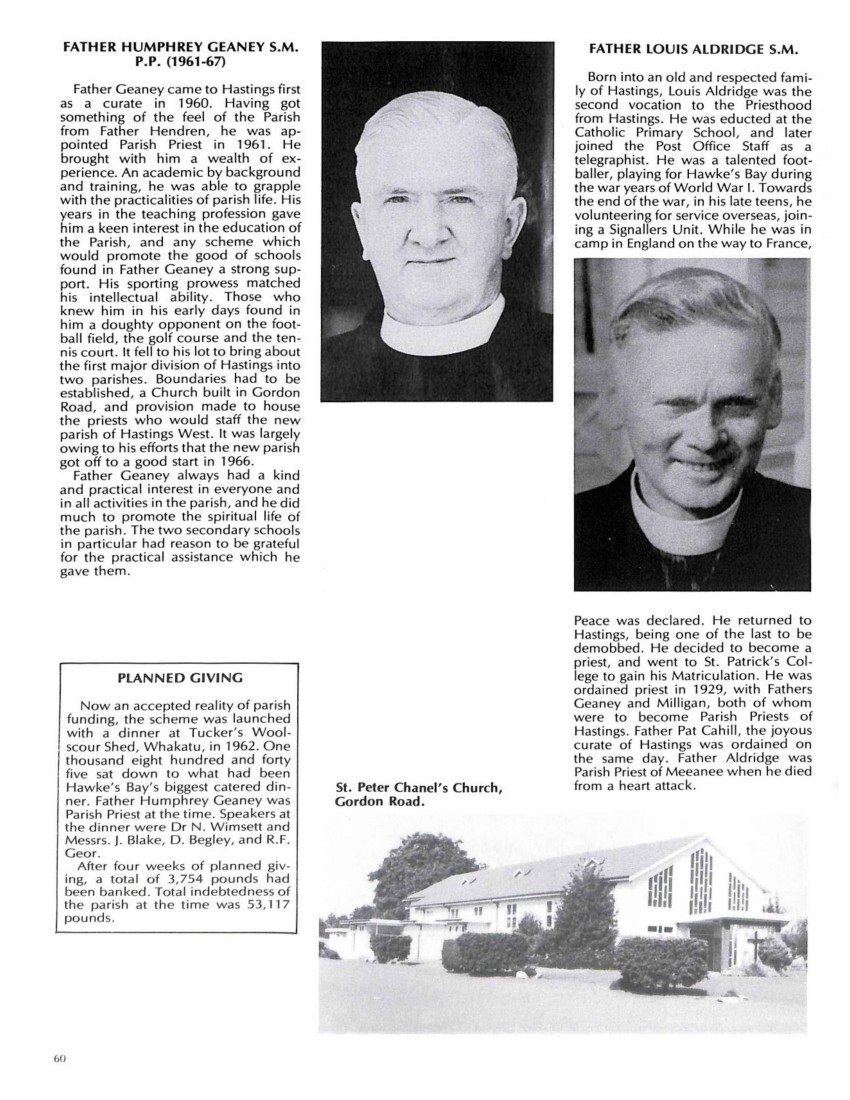
Page 61
FORMING OF THE CONFRATERNITY OF CHRISTIAN DOCTRINE
In the early 1960’s Father Geaney found in his visits to the State schools in Hastings an urgent need for people to assist him and help the large number of children at these schools to learn something of their Faith.
Father Fitzsimmons was given the chaplaincy and called a meeting of volunteers, headed by Kevin Stuart. We met in November 1963 and formed regions and classes. Vern Walters and John Blake, Jn., were the home visitors. Other people involved were Jane and Hilda Blasoni, Rosalie Geor (who took a class at Havelock North under the Church building), Olga Unverricht and Mary Pipe who taught the five-year-olds in their own homes. Eileen Malone took the First Communion classes whose ages ranged from seven to thirteen, some having to be baptised before receiving their First Communion. Vivienne Blake would pick up youngsters in her car from Mangateretere to Haumoana and then take a class at the hall. Mary Fieldson, Anne Fleming, Mrs Field, Audrey Fitzgerald, and Mae Anderson completed the first team.
Operations started on the first Sunday of February 1964. With the encouragement and kindly guidance of Lorrie Stuart we prayed to the Holy Spirit and set forth. For most of us it was our first introduction to teaching. There were 124 children in 1964.
The idea of CCD flourished and grew, new teachers and helpers were taken on each year.
When in 1966 Hastings West became a separate Parish, the 37 teachers and 500 children were split up. Since then CCD has played an important part in education in Faith in Hastings.
During the early years we had many lectures and visits from people starting and studying the movement. One visitor in 1966 was Father Felix Donnelly and we used his “Living Light” programme. The late Bishop Snedden and Father Ryder from Auckland were among the other people who helped us.
– contributed by one of the pioneers.
First training group, CCD, 1964
Back: Mary Pipe, Olga Unverricht, Laurie Stuart, Vern Walters, John Blake.
Middle: Kevin Stuart, Eileen Malone, Audrey Fitzgerald and Bridget, May Anderson.
Sitting: Vivienne Blake, Linda Christian, Hilda Blasoni, Anne Fleming, Mrs Field and daughter.
First Communicants prepared by CCD teachers.
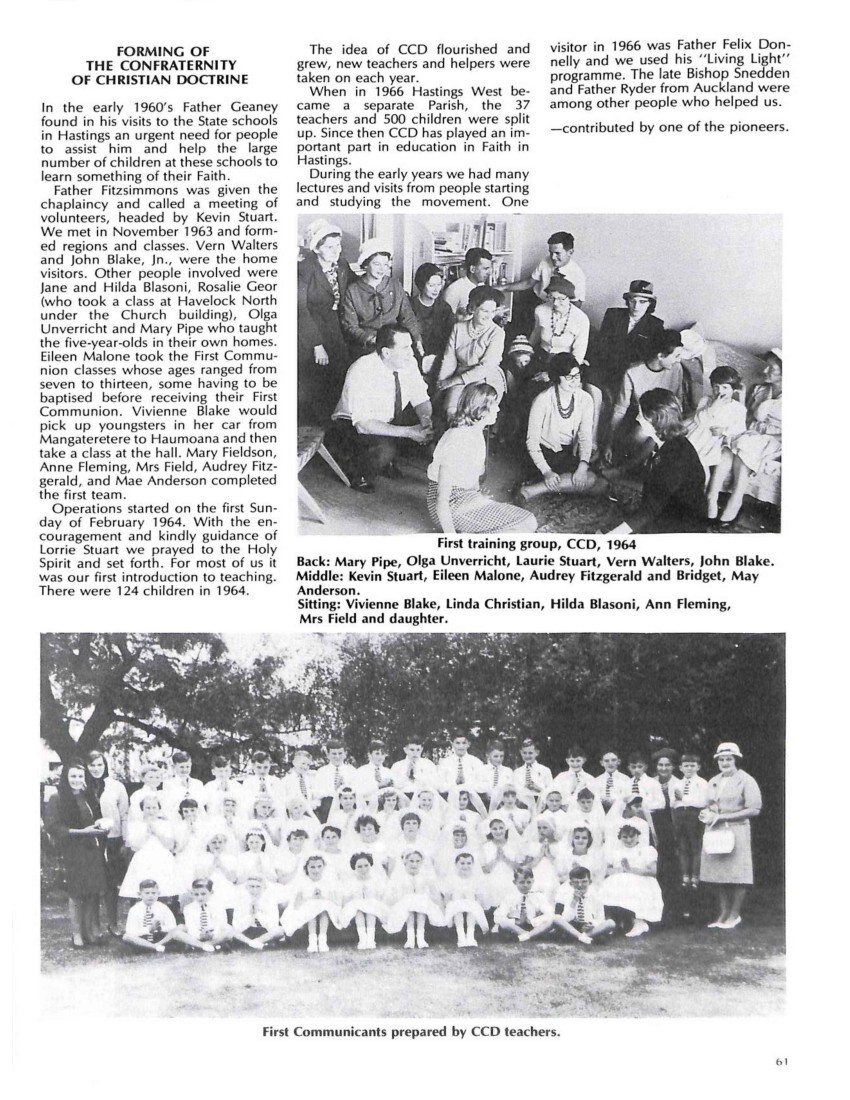
Page 62
TIMES HAVE CHANGED
In May 1956 the following notice was read out at all Masses: “The Novena to the Holy Spirit for the conversion of heretical sects will begin on Friday next.”
Now we observe the eight days before Pentecost as the Octave of Prayer for Christian Unity and in 1982 the preacher at Sacred Heart was a Presbyterian Minister, the Rev. Sefton Campbell of St. Andrews.
The Church from the Presbytery grounds.
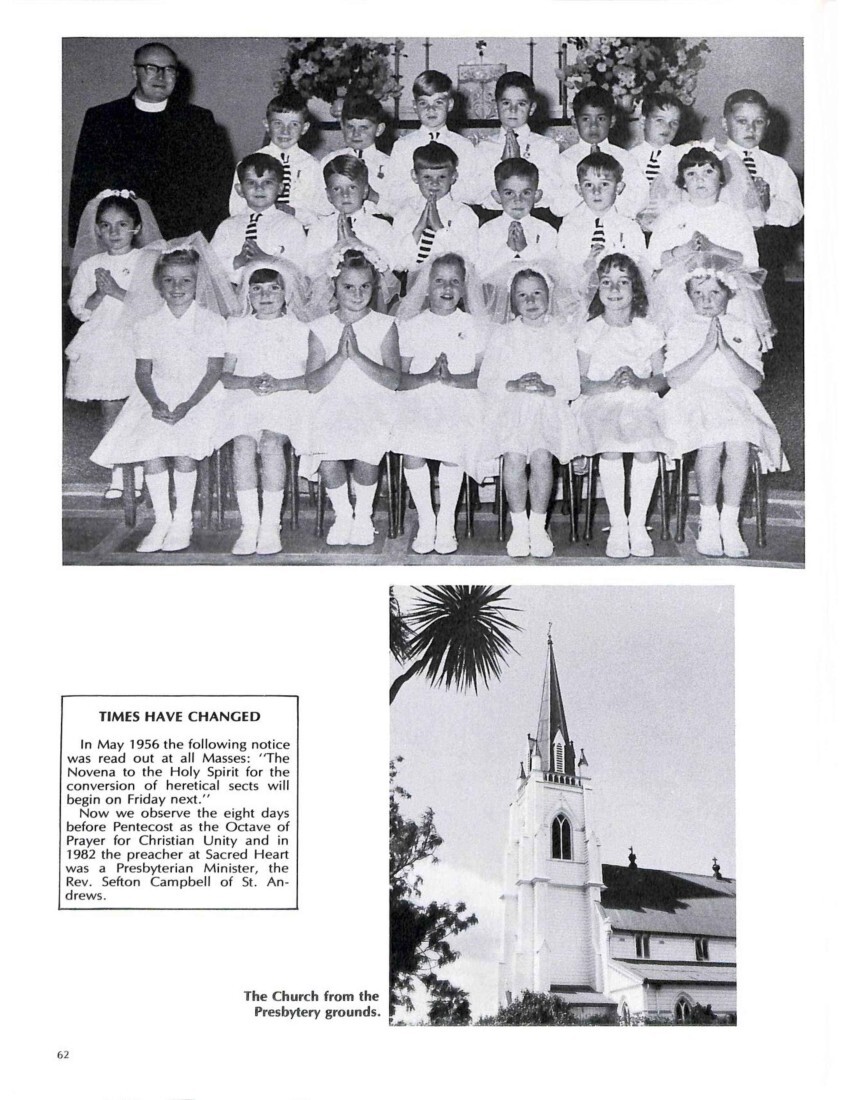
Page 63
FATHER P. HEAGNEY S.M. P.P.
(1967-73)
Father Heagney was well-known for his gentle, pleasant and approachable character. As a curate from 1937-41, he was devoted to the young people of the parish, and instrumental in establishing the 1st St. Joseph’s Scout Troop in 1938, of which he was the first official chaplain.
Much renovation work was accomplished by him during his term as Parish Priest. Both the Sacred Heart Church and St. Joseph’s, Clive were strengthened in their foundations and renovated inside and out. The sanctuary was altered in line with the requirements of the Liturgy, the front porch was enlarged and a centre aisle was added. Havelock North was set up as a separate parish and the Hastings East Parish was reduced to its present size. Father Heagney is at present curate at Blenheim, having enjoyed a wonderful trip to Ireland, the place of his birth. He was interested in the Hastings Lions of which he became President. Parishioners remember him as an active participant in the walkathons between Hastings and Napier.
FATHER P.P. CAHILL S.M.
The memory of Father Cahill remains fresh in the minds and hearts of Hastings parishoners [parishioners]. He was an incredible optimist who saw reasons to rejoice in every situation, and he spread that joy as he went. He was admirably young in heart, was happy, very happy in the company of the young because he loved their innocence. At the same time he had a deep affection for the elderly. His Golden Age and Sunflowers excursions for the elderly were a sheer delight, and Father enjoyed them as much as anyone, and better than most. They were real celebrations with a waving of bright coloured flags, the singing of favourite songs and a blowing of whistles. Many will recall his printing machine, with its production of comforting and cheery slogans (be a sunflower not a lemon!), happy verses and local patriotic plugs. The children of ‘76 will remember his arrival at the racecourse in a helicopter. He had a simple fervent piety, with a deep, child-like devotion to Mary, the Mother of God.
FATHER R.S. NOWLAN S.M.
(1955-57)
Hastings Parish was fortunate in having the services of the Father Bob Nowlan, on loan from Australia. He was a dynamic curate, with boundless energy and an insatiable desire to visit as many homes of the Parish as possible. He was unconventional in his approach at times; parishoners could be startled by his sudden appearance at any time of day or night. It didn’t worry Father Nowlan if parishoners were still at breakfast-he would simply give them a broadside for late rising! If he arrived at supper he blamed them for going to bed early! Behind what at times was a brusque or blustering exterior was a real tenderness and concern for people. The length of his Communion list was astonishing. Father Nowlan returned to Australia in 1957 and died of a heart attack in a car while returning from a pastoral visit.
THE SECOND VATICAN COUNCIL
The Council began in October 1962. The parishioners of Sacred Heart prepared for it with a Novena. Devotions were held each evening at seven o’clock. The newly established Christian Family Movement organised an all-night vigil 12 October as the Council began.
The first tangible signs of the Council’s work in the life of the Parish was the introduction of English into the Mass. In 1965 Father Hickey, who was a curate at the time, arranged for seminarians from Greenmeadows to lead the people in the responses for the first three Sundays of the English Liturgy. The Canon remained for some time in Latin.
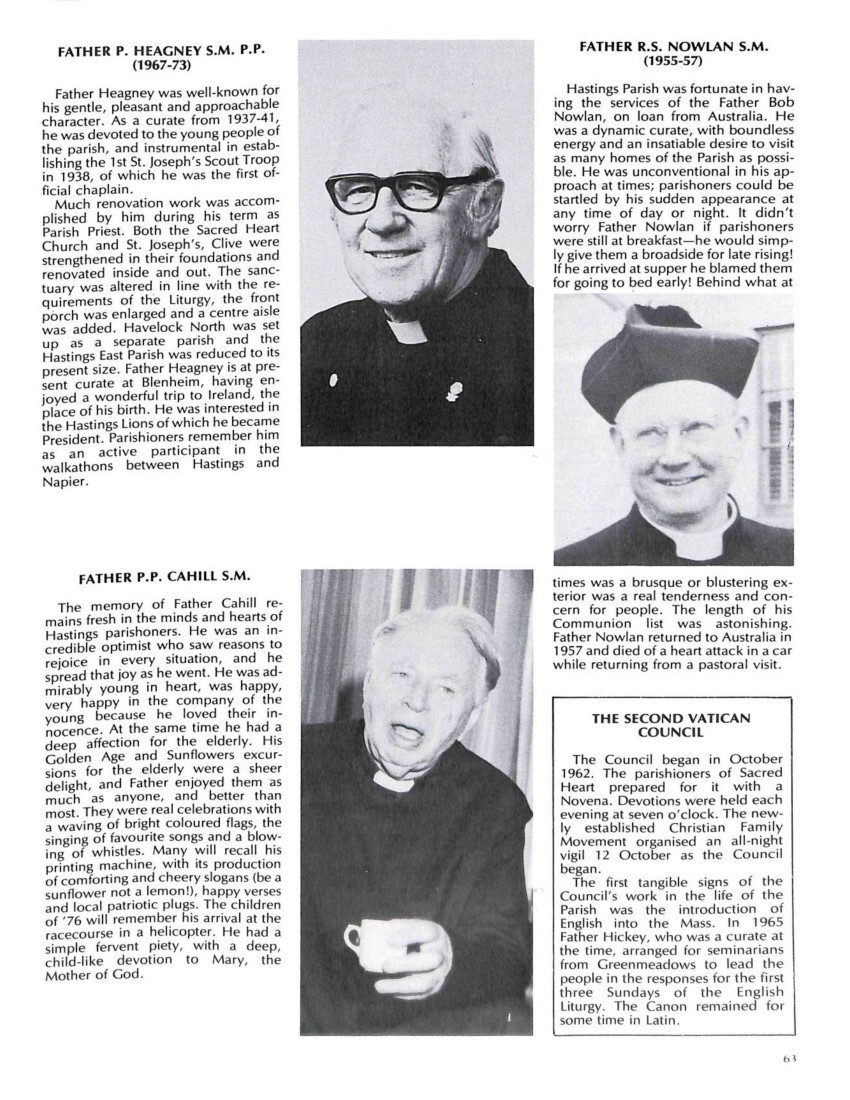
Page 64
FATHER P. McCARTHY, S.M.
Father McCarthy has the distinction of being the first vocation to the Priesthood from Hastings, more exactly from Tomoana, where he lived his early years. He was baptised by Dean Smyth, went to the Catholic Primary School in Hastings and then to St. Patrick’s College, Wellington. He was a boy of endless vitality and good humour. He loved to hear funny stories and to tell them. He achieved distinction in Rugby, Swimming and Boxing. After his ordination in the Sacred heart Church in 1920, ‘Paddy’ was appointed to St. Bede’s College, Christchurch, where as a young priest he distinguished himself both in the classroom and on the field of sport. While on the staff of St. Bede’s he played rugby for the Marist senior team, then for Canterbury and finally played half back for the All Blacks in 1923 when they defeated the British Isles and New South Wales. After this he went on exchange to Ireland and England for several years, teaching at Dundalk in Ireland and at Middlesborough in England. In 1931 he was a foundation staff member of the St. John’s College, Lismore, N.S.W., and although he always remembered fondly New Zealand, and especially the ‘Bay’, he never returned to New Zealand except for infrequent, brief holidays. Father McCarthy always remained an ardent devotee of Rugby. In England, Ireland and Australia, he coached rugby teams. He was always keen to talk rugby and players, but was quick to divert attention from himself. He once said, when the talk became a little personal, “let’s talk about football, the skill and dedication of its players, the great influence it has on character moulding and its enormous influence through sporting ambassadors.” At the ripe age of 83, he once remarked, “Rugby has stood the test of time, it is a fine team game, which should be based on the rule book, sound coaching and team spirit both by players and their supporters.” Those are good words on rugby from a man of wide experience and dedication as a player and coach.
VOCATIONS FROM HASTINGS
Over the years, Hastings had been blessed with many vocations to the Priesthood and to the Religious State. It is possible that some names have been omitted in the following lists. If so the editor apologises.
Sisters:
Adrian Tacon
Angela Buck
Anne O’Rourke
Annette Green
Anthony Cassin
Austin Kearns
Bega Downing
Borgia Kearns
Celine Sullivan
Charles Vickers
Cyprian Howard
Eugene O’ Kane
Eymard Heffernan
Felicitas Garvey
Felix Lee
Flora Walsh
Josephine Cacciopoli [Caccioppoli]
Lucille Taylor
Marlene Dunn
Marie Geor
Margaret Mills
Marie Watson
Mary McCann
Tarcisius Walsh
Veronica Lee
Zita Coombs
Helen McKeegan
Fathers:
L. Aldridge, S.M.
C. Austin, S.M.
P. Bearsley, S.M.
E. Blasoni, S.M.
F. Bliss, S.M.
A. Bloore, S.M.
J. Bryant, S.M.
P. Butler
D. Cacciopoli, S.M.
M. Cross, S.M.
J. Drane, S.M.
L.C. Danvers
M. Goldfinch, S.M.
J. Goulter, S.M.
D. Hamilton, S.M.
D. Kennerly, S.M.
K. Houlahan, S.M.
S. Lorrigan
C. Loughnan, O.P.
B. Malone, S.M.
A. Malone, O.F.M.
K. Maloney, S.M.
P. McCarthy, S.M.
P. McCann, S.M.
R. McDonnell, S.M.
V. McGlone, S.M.
R. Morrissey, S.M.
M. O’Donnell, S.M.
K. O’Donoghue, S.M.
K. Perry, S.M.
R. Pipe
A. Toothill, S.M.
J. Unverricht, S.M.
M. Unverricht, S.M.
Brothers:
Michael Devoy, S.M.
Michael Hannah, S.M.
Leo White, O.F.M.
John Cullinane, S.M
Brian Arahill
Father Ivan Fisher, a devoted curate, and a priest whose memory is held in the highest regard by the men of the Hibernian Catholic Mens club.
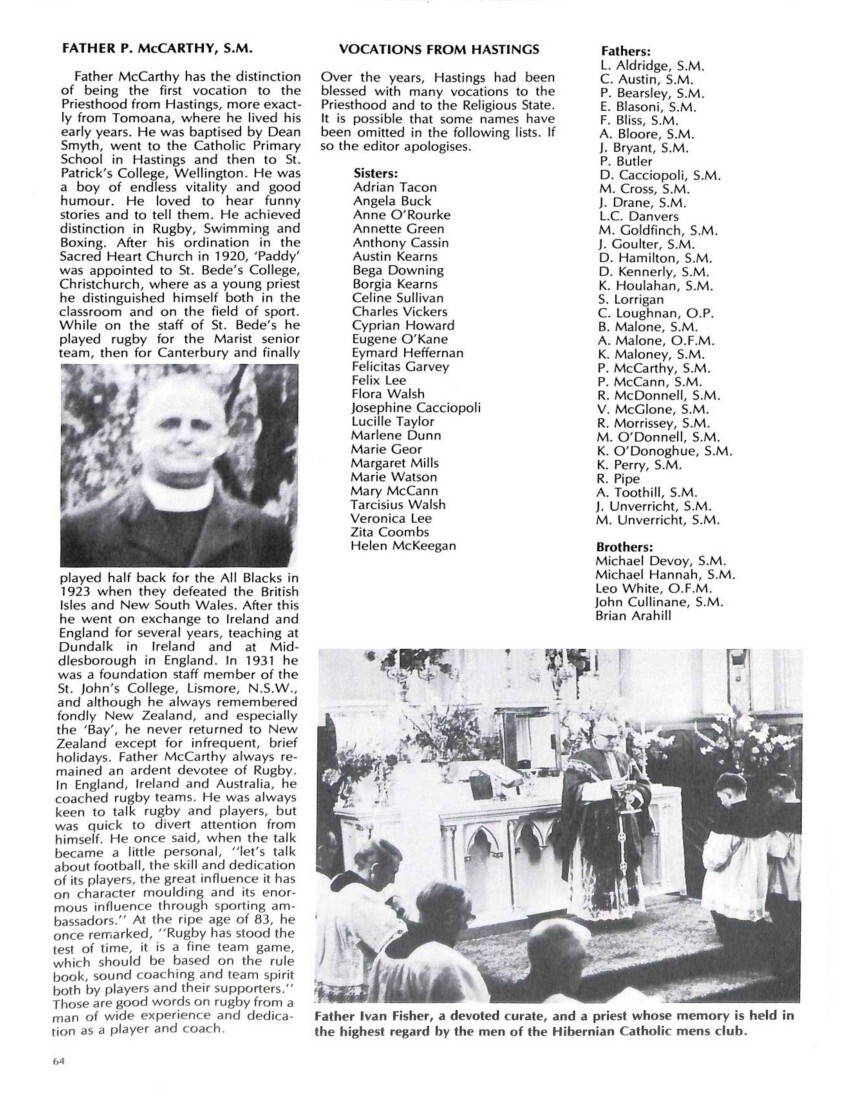
Page 65
FATHER PAUL SHANAHAN
1973-1978
Father Paul Shanahan came to Hastings as a curate under Father Heagney and succeeded him as Parish Priest in 1974. His driving, forceful, personality hit parish life like a charge of dynamite. His enthusiasm and deep love of the liturgy inspired people to make it more meaningful to them. Meetings, meetings and more meetings were the order of the day. All were kept on their toes – one was lucky to be home by 11.30pm. Father was a mass of energy, was hospitable and a good administrator. He was adept at encouraging people to work with him and kept an eagle eye out in every area of parish life. He had an especially good rapport with younger marrieds and charismatic renewal.
FATHER JOHN O’ROURKE
1979-1981
Father John O’Rourke joined the parish staff in the middle of 1979 and succeeded Father Shanahan as parish priest. After 21 years as a missionary in Tonga, it was a difficult adjustment. “No way” became a very familiar sound during the first six months. Contrary and loveable, a deeply spiritual man, he was humble, honest and very human and down to earth. He found administration irksome but will long be remembered for his inspiring homilies and his loving care of the sick, the aged and those in trouble.
“Blessed are the dead who die in the Lord”
OF
YOUR CHARITY PRAY FOR
THE
HAPPY REPOSE
OF THE SOULS OF THE
PRIESTS WHO HAVE
MINISTERED
IN THIS PARISH
REV. E. REIGNIER, S.M.
REV. TH. LEMENANT [LE MENANT], S.M.
REV. P.J. SMYTH, S.M.
REV. AUG. KEOGH, S.M.
REV. CEO. MAHONY, S.M.
REV. J.J. FRAHER, S.M.
REV. B.J. GONDRINGER, S.M.
REV. J.J. SEYMOUR, S.M.
REV. A.F. McDONALD, S.M. P.P. 1924-29 / 1937-42.
REV. R.S. NOWLAN, S.M.
REV. L.P. SPRING, S.M.
REV. D.C. MILLIGAN, S.M.
REV. W.B. BUCKLEY, S.M.
REV. R.I. FISHER, S.M.
REV. I.W. STEWART, S.M.
REV. A.N. KENNEDY, S.M.
REV. W.J. CHANEY, S.M.
REV. P.P. CAHILL, S.M.
REV. A.S. WARD, SM
Sincere Acknowledgements
Father M. Mulcahy, S.M.; Mrs Kay Mooney; Father C. Devonport, S.M.; Mr David Holt, photographer for wedding photo; Daily Telegraph; Dominion; Herald Tribune; Archives, Mount St. Mary’s Greenmeadows; Archives, Taradale Presbytery.
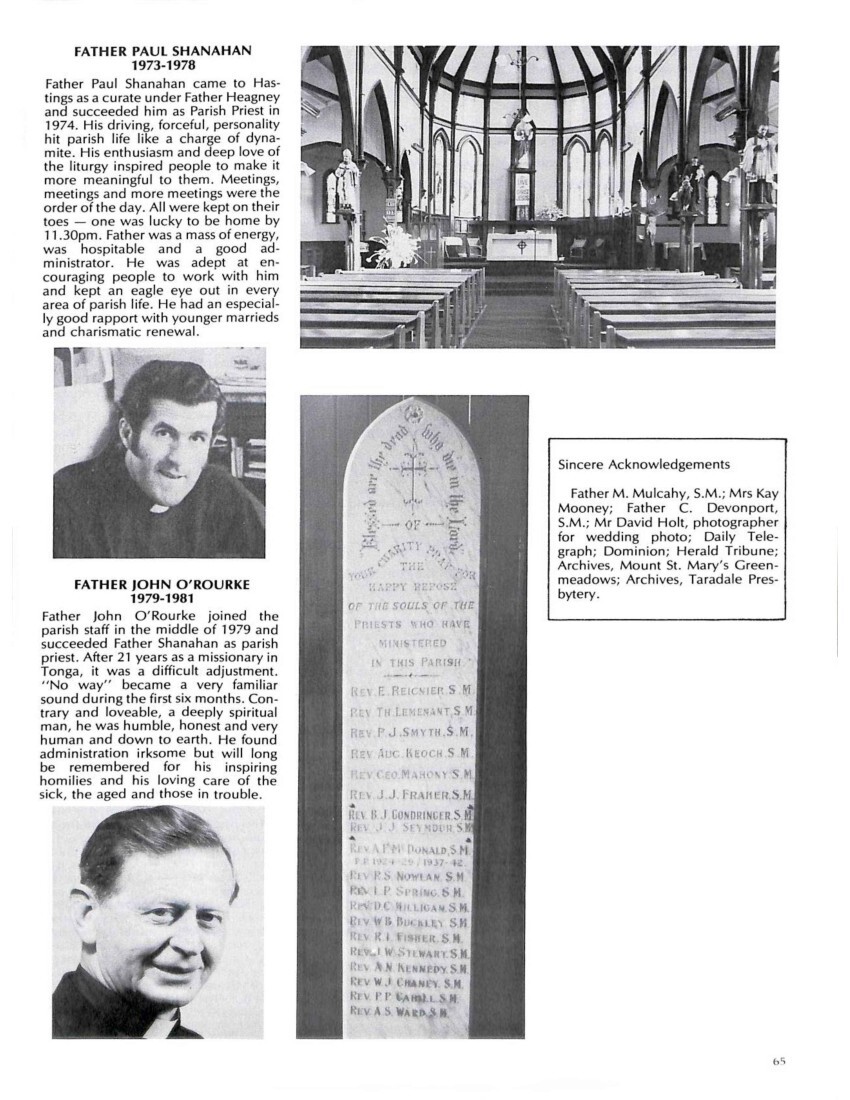
Page 66
OUTLINE OF HISTORY
1841: Bishop Pompallier at Mahia. Celebrates the first Mass in Hawke’s Bay.
1841: September. Bishop Pompallier at Mahia again. Leaves Father Baty, S.M., to set up a Mission.
1850: December. Father Lampila, S.M., with Brothers Basil and John arrive at Pakowhai to set up the Hawke’s Bay Mission station.
1858: The Mission under Father Reignier, S.M., moves to Meeanee.
1850: Father Reignier moves widely over the vast mission area, baptising, instructing, marrying.
1880: June 8. The first Church at Paki Paki is blessed and opened by Father Yardin, S.M.
1881: The Church of the Sacred Heart is built.
1882: 16 April. Bishop Redwood solemnly blesses and opens the Church of the Sacred Heart, Hastings.
1882: Father Reignier becomes the first resident Priest in Hastings. He builds a small presbytery.
1883: Father Reignier returns to Meeanee to live. Hastings is without a resident Priest. Hastings is looked after from Meeanee.
1884: A preliminary meeting of the Hibernian Society is held at Kelly’s Hotel, Hastings.
1885: Father Lewis helps Father Reignier for a few months, then is appointed Parish Priest of Blenheim. Father Yardin is appointed chaplain of the H.A.C.B.S. Hastings is made a separate parish from Meeanee, Father P.J. Smyth is appointed Parish Priest.
1886: Father Smyth takes up his appointment at the end of January. A new presbytery and a hall-school is built.
1887: Altar Society and Rosary Society are established. Father Smyth makes arrangements for a Catholic primary school in Hastings.
1888: Father Le Menant des Chesnais is Parish Priest for the year. Sisters of St. Joseph arrive September 13. Blessing of the new school by Bishop Grimes, S.M., of Christchurch, 17 September.
1889: Father Smyth is back as Parish Priest. Classes begin at the St. Patrick’s Catholic School. St. Joseph’s Church, Clive, is blessed and opened by Archbishop Redwood, S.M., 7 July.
1894: October 7, the foundation stone of a new Sacred Heart Church is blessed and laid by Archbishop Redwood, S.M.
1895: May 12, blessing and opening of the new Sacred Heart Church by Archbishop Redwood, assisted by Bishop Grimes, S.M., of Christchurch. Bishop Grimes sings the Mass, Archbishop Redwood preaches.
1901: January 27, a new two-storeyed convent is blessed by Father Smyth, assisted by Dean Kirk, S.M., of Wanganui.
1907: Father B.L. Quinn, S.M., is appointed assistant.
1909: Father Smyth is appointed Rector of the Seminary at Greenmeadows. Father A. Keogh, S.M. is the new Parish Priest.
1912: Father G. Mahony, S.M., is appointed assistant, 9 February. The parish hall is enlarged and moved to its present site. A section of land is bought at Havelock for church purposes.
1913: Father Keogh’s mother dies and is buried in the Hastings cemetery.
1915: Father H. McDonnell is appointed Parish Priest of Hastings. Father Keogh goes back to St. Patrick’s, Wellington, temporarily.
1917: Father Keogh comes back to Hastings. He dies at Nurse O’Callaghan’s private hospital, 16 August. He is buried alongside his mother in the Hastings cemetery.
1918: Father G. Mahony, S.M., is appointed Parish Priest of Hastings. He buys land at Waimarama for possible future church development.
SOME FAMOUS FIRSTS
First baptism registered in the Sacred Heart Church, 1882, is Matthew Conroy son of Jeremiah Conroy and Mary O’Grady. The sponsors were William McNamara and Johanna O’Connell. The priest was Father Reignier. The date of baptism, 27 August 1882.
The first child baptised by Father P.J. Smyth in Hastings was Thomas Michael Aldridge, son of James Aldridge and Mary O’Connor. The sponsors were Oliver O’Connor and Bridget O’Connor. The date of baptism was 31 January, 1886.
The first child baptised in the new Church of the Sacred Heart, opened 12 May 1895, was Philomena Dominic Lynn, daughter of James Lynn and Johanna Moloney. The sponsor was Mary Ball. The priest was Father P.J. Smyth. The date, 28 May, 1895.
The first marriage celebrated in the Church of the Sacred heart, which was opened in April 1882, was that between Martin Burke and Margaret Hickey. The celebrant was Father E. Reignier and the date was 8 August 1882.
The first marriage celebrated in the new Sacred Heart Church, opened in May 1895, was that between Neal O’Neill and Maggie Ann Donnelly. The witnesses were Michael Francis Donovan and Katie Sweeney. The celebrant was Father P.J. Smyth, S.M. The date was 2 July 1895.
The first vocation to the priesthood came from Whakatu, Hastings. He was Father Patrick McCarthy, S.M., born 28 June 1893. He was baptised in the Sacred Heart Church, where he made his First Communion, and was ordained there by Archbishop Redwood, 19 December 1920. Father ‘Paddy’ excelled in football, representing New Zealand, the South Island and Canterbury. He was an outstanding missioner with an attractive style of preaching and a wonderful sense of humour. He died in Brisbane at the age of 83.
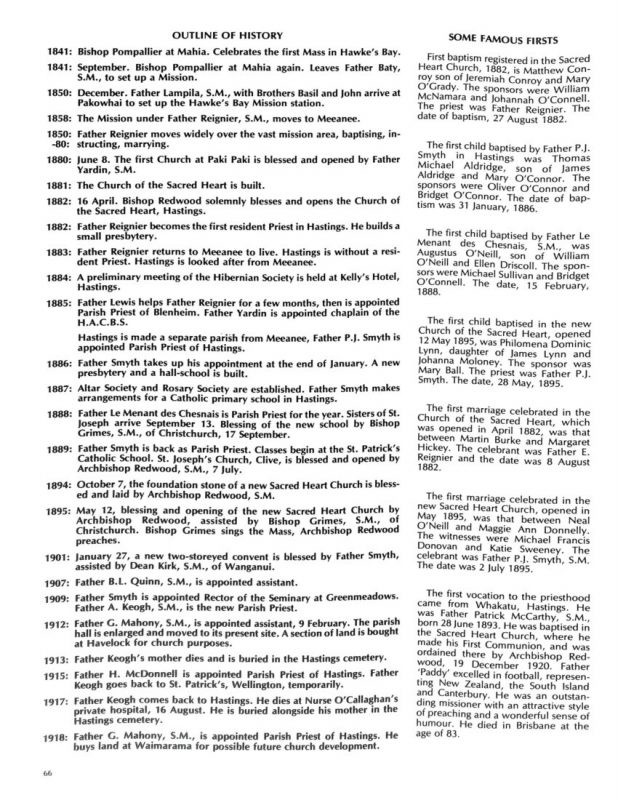
Page 67
(Continuation of Outline)
1924: Father A.F. McDonald is Parish Priest. Dog, gun, violin, motorbike a feature of presbytery life.
1926: Catholic Tennis Club formed, with courts at corner of Miller and Victoria Street.
1929: Father J. Fraher appointed Parish Priest.
1930: Father B. Gondringer appointed Parish Priest.
1931: Hawke’s Bay earthquake. Father Gondringer, Parish Priest of Hastings, killed by the ‘quake at Mr. St. Mary’s, Greenmeadows. Father J. Stewart becomes the Parish Priest.
1932: Ladies’ Conference of St. Vincent de Paul Society established.
1935: Opening of new St. Joseph’s School.
1936: Father A.F. McDonald, Parish Priest for second term.
1938: Erection of brick fence in front of Church and Presbytery. Foundation of St. Joseph’s Scout Troop.
1939: Marist Third Order established. World War II.
1941: Opening of St. John’s College, Frederick Street. Father John Dowling first Rector of the College.
1943: Father M. Murphy, Parish Priest.
1944: Father Milligan appointed Parish Priest. End of World War II.
1945: Convent Memorial Baths opened by Mayor Rainbow.
1947: First Charity Ball in Hastings.
1949: Father Spring arrives as Parish Priest. Queen Carnival held.
1950: Mass once again celebrated regularly at Havelock North.
1951: St. Joseph’s Secondary School transferred to the Tenison site.
1953: First meeting of Catholic Women’s League. Arrival of Little Sisters of the Poor.
1954: New wing added to St. Joseph’s Convent.
1955: Father Hendren appointed Parish Priest. Land purchased at Gordon Road.
1956: Transfer of St. John’s College to Jervois Street.
1957: St. Mary’s school, Mahora, opened. Chapel of St. John’s College blessed and opened. Opening of St. Teresa’s Church Hall, Whakatu.
1959: New Church at Havelock North blessed and opened.
1961: Father H. Geaney becomes Parish Priest. Official opening of Holy Family Home.
1962: Opening of Second Vatican Council. Planned Giving comes to Hastings.
1963: Confraternity of Christian Doctrine founded.
1966: Hastings West becomes a separate parish.
1967: Father P. Heagney is Parish Priest. Havelock North becomes a separate parish.
1972: Father Stewart dies at Holy Family Home.
1973: Father P. Shanahan is appointed Parish Priest.
1974: St. Joseph’s Church, Clive, catches fire at the end of a Mission. It is renovated and rededicated. Flooding isloates [isolates] the Church.
1976: Properties in Eastbourne Street bought for Tenison playing fields. Renovation of Sacred Heart Church organ.
1978: Father Bern Ryan, Rector of St. John’s elected Superior General of the Society of Mary.
1979: Father John O’Rourke appointed Parish Priest. Hastings in the new diocese of Palmerston North. Ordination of Fathers Damien Cacciopoli, Kevin Maloney and Terry Malone in Municipal Theatre. Closure of Tenison College.
1981: 40th Jubilee of St John’s College.
1982: Father Geoff. Officer, Parish Priest. Restoration of Sanctuary of Sacred Heart Church. Premier Hall used for Mass during the Restoration. Father L. Brice celebrates Golden Jubilee of Priesthood. Sacred Heart Church celebrates centenary.
ASSISTANT PRIEST OF THE PARISH
Fathers:
P. Abbott
B. Atkins
B.F. Blake
L. Brice
W.F. Buckley
W.P. Chaney
T. Cook
L. Dean
F.L. Dignan
J. Dooley
J. Egan
P. Fay
T.J. Fitzpatrick
I.J. Fisher
J.S. Fitzsimmons
J. Fraher
A. Galerne
J. Goggin
D.L. Hickey
A.N. Kennedy
A. Keane
F. Kerley
T.F. Laffey
B. Leech
W. Lewis
T.B. McBreen
J.S. McHardy
K. Maloney
M. McManus
J.K. Mannix
I.J. Mather
N.P. Maloney
M.A. Murphy
R.W. Nowlan
K. O’Donoghue
J. O’Neill
F.J. O’Shaughnessy (Ireland)
M O’Sullivan
W. Peoples
B.L. Quinn
J. Rea
M.J. Scully
J.J. Seymour
C.D. Taylor
P.W. Tymons
A.S. Ward
C.P. Whiteford.
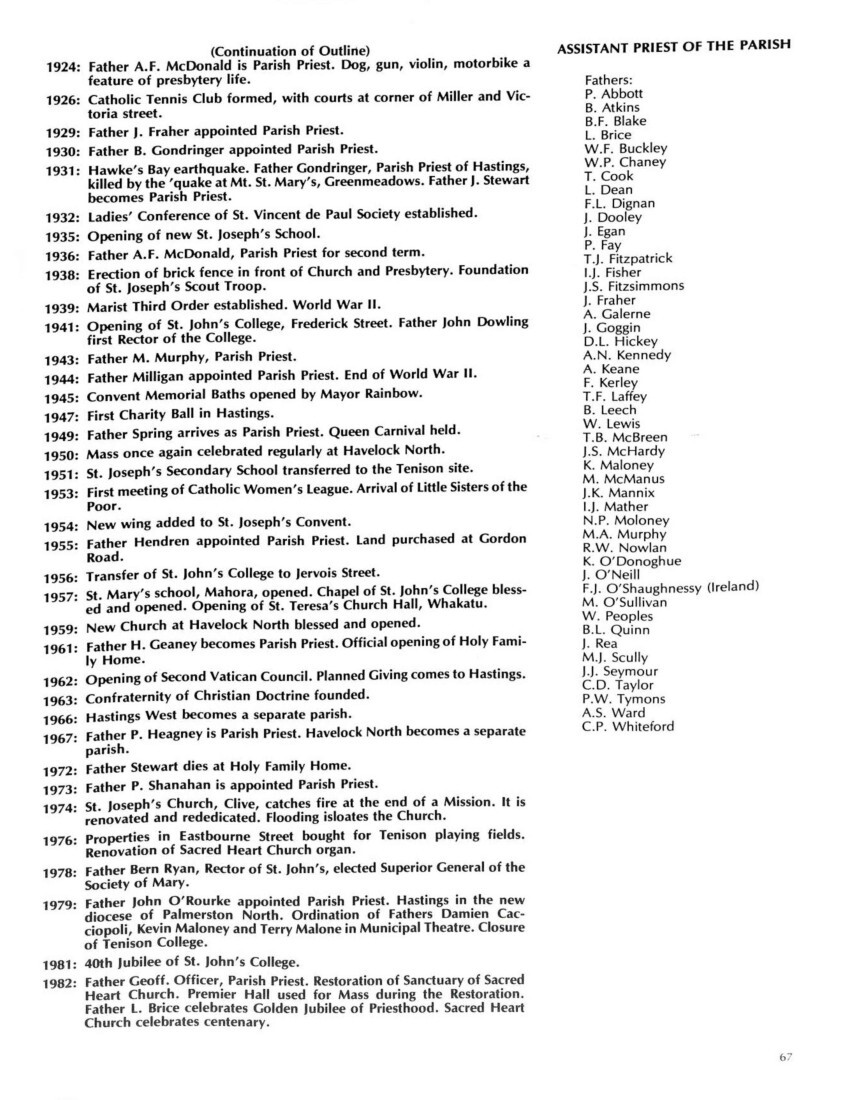
Page 68
CELEBRATION OF SACRAMENTS IN THE CENTENNIAL YEAR:
Fr. Brice celebrated his Golden Jubilee of Priesthood.
Fr. David Kennerley, ordained in 1982, blesses his mother on his ordination day.
The marriage of Bede Roughton and Mary-Ann Lee celebrated during Sunday Mass. A very happy occasion.
Brooke Montaperto, baptised by Fr. Officer in the Hall, which was being used as the Church renovations.

Page 69
Father Keogh’s former pupils, who had either been ordained or who were students for the priesthood, pictured together with their old master. They in turn became legends. The photo includes: Fathers B. Ryan, A. and J. Cullen, More O’Farrell, J. Campbell, Gottfried, H. Seymour, J. Fraher, M. Devoy, J. Herring, T. Siegrief, C. Casey, G. Venning, J. Stewart, F. Dignan, Quinn, Eccleston, and M. Murphy. Taken in front of the Hastings Presbytery about 1911.
One of the most memorable parish occasions of the last few years: the Ordination in the Municipal Theatre of Fathers Kevin Maloney, Terry Malone and Damian Caccioppoli, July 5th 1980.
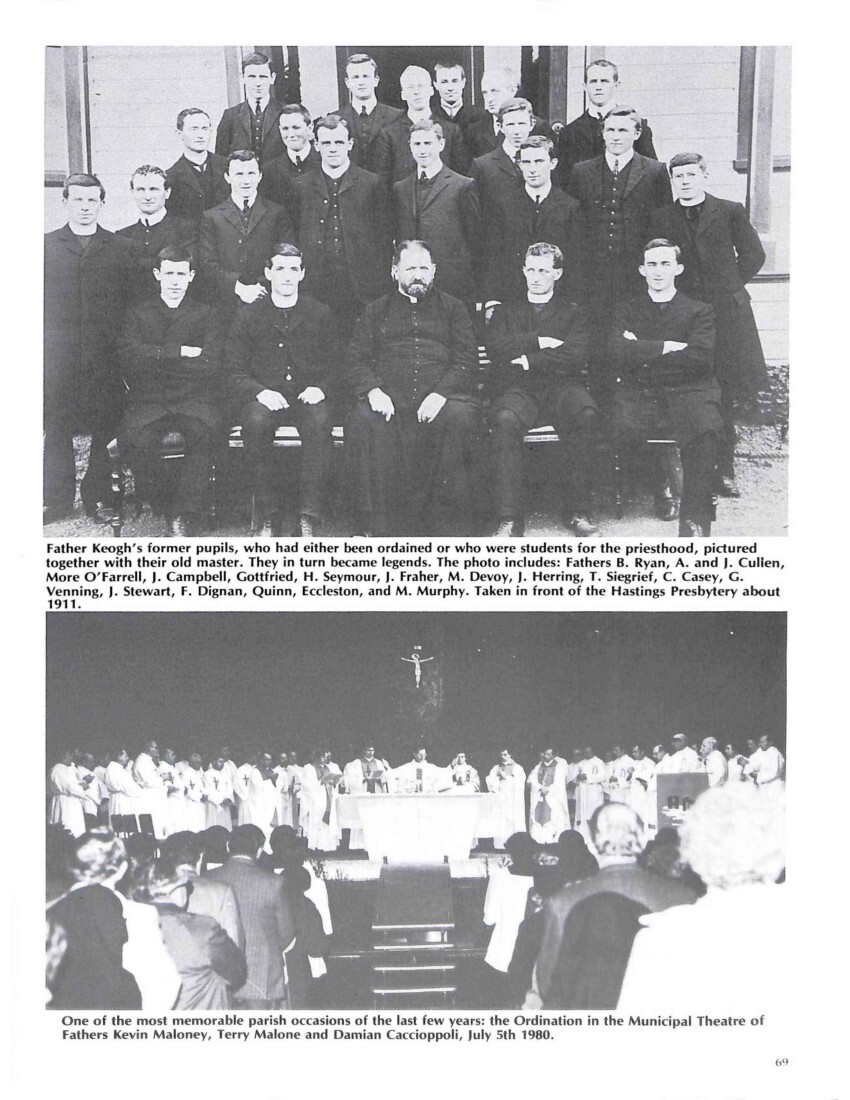
Page 74
THE CONCLUDING CELEBRATIONS
FOR THE CENTENNIAL YEAR.
The weekend 4-7 November saw the final celebrations to honour the Centenary of the Sacred Heart Parish, Hastings.
The first of the final celebrations took place on Thursday, 4 November. It consisted of the Parish Mission. This was a happy and successful opening for the weekend.
Father Officer spoke of the impact upon himself of his appointment to the important parish of Hastings in its Centennial Year. He referred to earlier Parish Priests in whose shoes he could not hope to walk, and yet found in these men characteristics which struck a chord within himself. Father Officer spoke with gratitude of the two Committees which had been of immense help to him, the Restoration Committee and the Centenary Committee. He thanked the parish staff and the St. John’s College Staff for their generous cooperation. He took the opportunity to farewell with thanks the Missioners Father Connolly and Father Montgomery. Their contribution to the Centenary was a valuable and lasting one. He took the opportunity to announce that Papal Awards would be made to Mrs Dorothy O’Connor and Mrs Mary Brunton for their years of generous service. Finally he declared the Centenary Celebrations as officially commenced and proposed a toast to the heritage of Hastings Faith and to the success of the Celebrations.
Mr Brian Epplett, Chairman of the Centenary Committee, outlined the events of the weekend with some practical advice. He also supplied a likely weather report.
BARBECUE AND YOUTH EVENING FRIDAY, 5 NOVEMBER.
This was a celebration for the young in age and in heart. There was the barbeque with huge mounds of sausages, together with fire works and an immense and scorching bonfire. When the day faded, the youth turned to the Premiere Hall and to the light fantastic, and deafened themselves with disco-din.
OFFICIAL WELCOME AND REQUIEM MASS, SATURDAY 6 NOVEMBER.
The Hawke’s Bay A. & P. Showgrounds was the venue for this occasion held in tropical weather. The Official party was welcomed on to the ground by a Maori Welcome Party. Mr John Koko welcomed the Party and guests on behalf of the Maori people of Hastings and Paki Paki. His speech like all the speeches of the morning was followed by the customary waiata. Father Officer S.M. P.P. then spoke. He began in Maori then continued in English, welcoming all the celebration. As opening theme, he took an excerpt from the Hastings Evening News which recorded the death of Father Reignier on 28 October, 1888. “It is men of the stamp of Father Reignier who form the real strength of the Catholic Church, for by their lives they show that the faith which is in them not only ennobles them, but urges them to acts of heroism.” He gratefully saluted the past-individuals, groups and institutions which had played a vital part in building up the parish of Hastings. He welcomed the confirming presence of Bishop Peter, and of Father Dooley S.M. symbolising the Marist Fathers’ Heritage in Hawke’s Bay, of the Sisters of St. Joseph, especially their Superior General Sister Catherine Ryan. He greeted the Mayor and Mayoress Mr and Mrs J.J. O’Connor, the Member for Hastings Mr David Butcher and his wife Mrs Mary Hall, and the Speaker of the House, Sir Richard Harrison and Lady Harrison. He took the opportunity of wishing Mr O’Connor every success in his preparations for the coming Centenary of the City of Hastings.
Mr J.J. O’Connor, the Mayor extended a cordial welcome to all the visitors, and on behalf of the Hastings City Council, gave good wishes and congratulations to the Sacred Heart Parish. He reminded his listeners that the Church Centenary preceded the City Centenary by a full two years, which indicated the correctness of priorities among the pioneers. He touched on the religious history of the Church in Hastings, on the fruitfulness in vocations. He stressed the importance of St. John’s College and the contribution to the City of Hastings made by the Sisters of St. Joseph. Since the days of Father Reignier, the Church like the City had made steady progress.
Mr Butcher M.P for Hastings, also spoke words of welcome. The Church was an influence for good. He had experienced overseas the impact of the vital presence of Pope John Paul II. He congratulated Father Officer upon the Centenary of the Sacred Heart Parish.
Mr Ivan Emea speaking in Maori greeted the Bishop as the Great House shading and protecting all who came beneath its influence. He greeted the Marae on which the Bishop and official party stood. The Marae was honoured by the presence of such people upon it.
He greeted those who had spoken, John Koko, Father Officer, Mr O’Connor and Mr Butcher, all the Priests and Sisters, parishioners and guests. He was happy to be associated with all on such an important occasion, and wished all a successful celebration.
Bishop Cullinane congratulated the Parish on its great achievement. In celebrating the Centenary, they celebrated a journey in Faith, a journey with the Risen Christ. Baptism creates a deep unity, but also a demand for growth. May the Centenary witness not the completion of a journey, but a new stepping out in Faith.
Father J. Dooley S.M., the Vicar Provincial offered the good wishes and congratulations of the Provincial of the Society of Mary, Father Bliss, who was unable to attend. Hastings had a proud heritage of Faith, and the present generation of Hastings Catholics had a duty to nourish that heritage.
After the official welcome and speeches, a Requiem Mass for all deceased parishoners and clergy, was celebrated. A former Parish Priest, Father J. O’Rourke S.M. was the preacher, and Father J. Dooley S.M. was the principal celebrant. Father O’Rourke stressed the debt we owed to the past, to those who brought and handed on the Faith, the Irish pioneers, the self-sacrificing clergy and religious, too many to mention in a short address. “We acknowledge and show our gratitude by nourishing our own Faith and praying for those who have gone before us.”
After the Mass, many parishioners took advantage of the beautiful day and the shaded grounds, to have a picnic lunch.
LUNCHEON FOR CLERGY AND RELIGIOUS:
The function took place after the Requiem Mass. It was enjoyed in a spirit of pleasant informality. All were glad to be in the shade after the searing heat of the Showgrounds. Toasts were proposed to the Clergy and the Religious by Father P. Shanahan and Father K. O’Donoghue respectively. Replies to the toasts were made by Monsignor T. Hannigan and Sister Catherine Ryan R.S.J. Monsignor W. Heavey, the doyen of the Diocese, who had been closely linked with the Society of Mary over many years, spoke with his customary honest sincerity and good humour.

Page 76
CENTENARY DINNER AND CABARET: 6 NOVEMBER
This was a brilliant occasion attended by a great number of parishioners and friends. The venue was the great hall at the Showgrounds. The official party which now included His Excellency the Papal Pro-Nuncio, Archbishop Magnoni and his secretary Monsignor Astolfi, Sir Richard Harrison and Lady Harrison, were welcomed into the dining hall by the traditional Maori call. Mr Keith Stinson was an effective M.C. The Papal Pro-Nuncio spoke briefly and said Grace. Mr Brian Epplett, Chairman of the Centenary Committee, was the principal speaker, and very ably gave a background to all that had led up to the present moment, and made suitable reference to those whose dedicated work had contributed so much to the occasion. The whole evening was a fitting celebration of a hundred years of growth.
Archbishop Magnoni, Apostolic Pro-Nuncio, says the grace at the Centennial Dinner
The cake is cut by Sister Monica and Norah Chote
The beautiful cake
Mr Brian Epplett, Chairman of the Centennial Committee, speaks at the Dinner
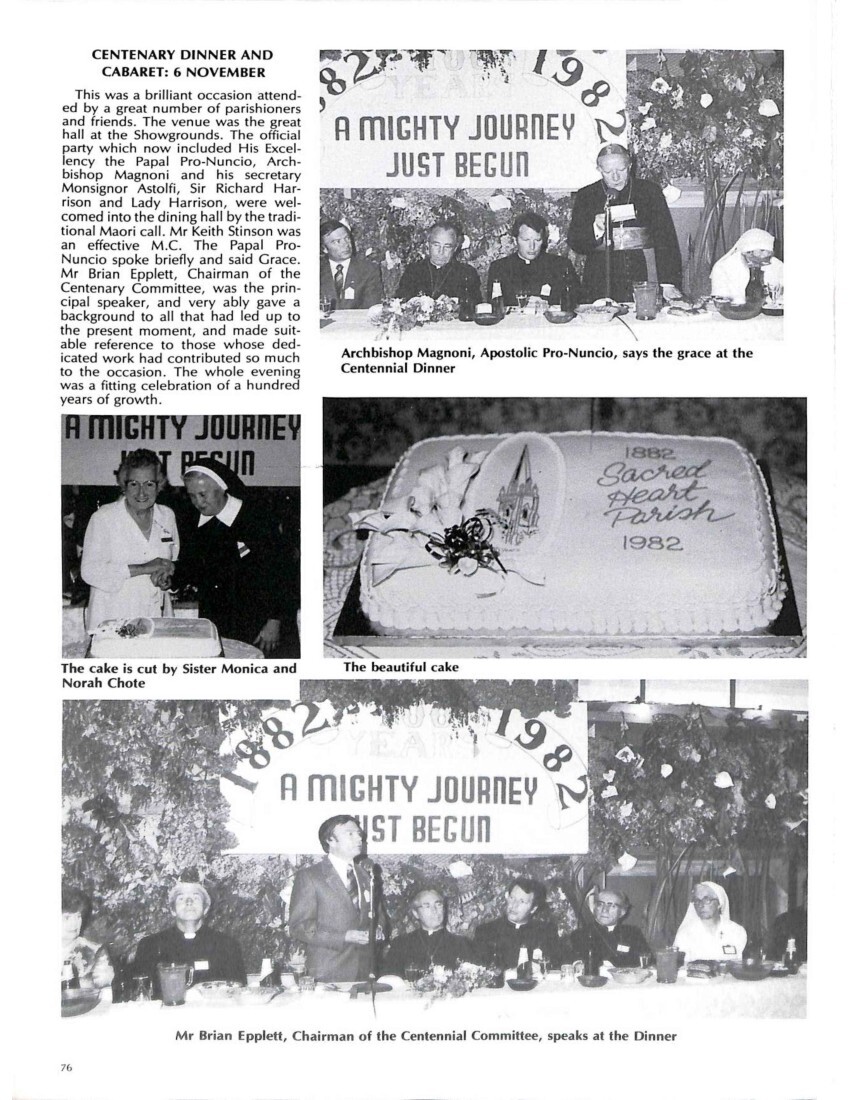
Page 78
CENTENNIAL MASS, 7 NOVEMBER
The Showgrounds was again the scene for the Mass of the Century. The Principal Concelebrant was Bishop Cullinane who also preached the occasional sermon. This was another splendid occasion, another very hot day. This time the assisting Clergy were provided with golf umbrellas, and faces were not as red as they were on the previous day. Bishop Peter preached a memorable sermon on the theme of ‘Church’ – a sermon which deserves a nationwide audience. (The sermon has been reported in the Tablet).
The prayers of intercession were made by people representing various groups and activities in the parish: Dorothy Lee, Ani Daly, Anne Ryan, Dixie Reo, Ernie Hodder, Noeline Paenga. Similarly at the Offertory the representatives were: Miriam and Bill Gunn, Carmel and Ron Martin, Mary and Alan Stanley, Heni Tuki and Elise Whakaue, Karen Brunton and Elliot Brunton.
After the Communion, presentation of Papal awards were made by Archbishop Magnoni to Mrs Dorothy O’Connor and Mrs Mary Brunton. After this, His Excellency presented to Father Officer the Papal Blessing for the Sacred Heart Parish.
The Clergy process at the Mass at the Showgrounds
The Offertory Procession
Tom Manaena spoke at the Mass on behalf of the Maori people
Mrs O’Connor and Mrs Brunton during the presentation of their Papal honours, presented by the Apostolic Pro-Nuncio.
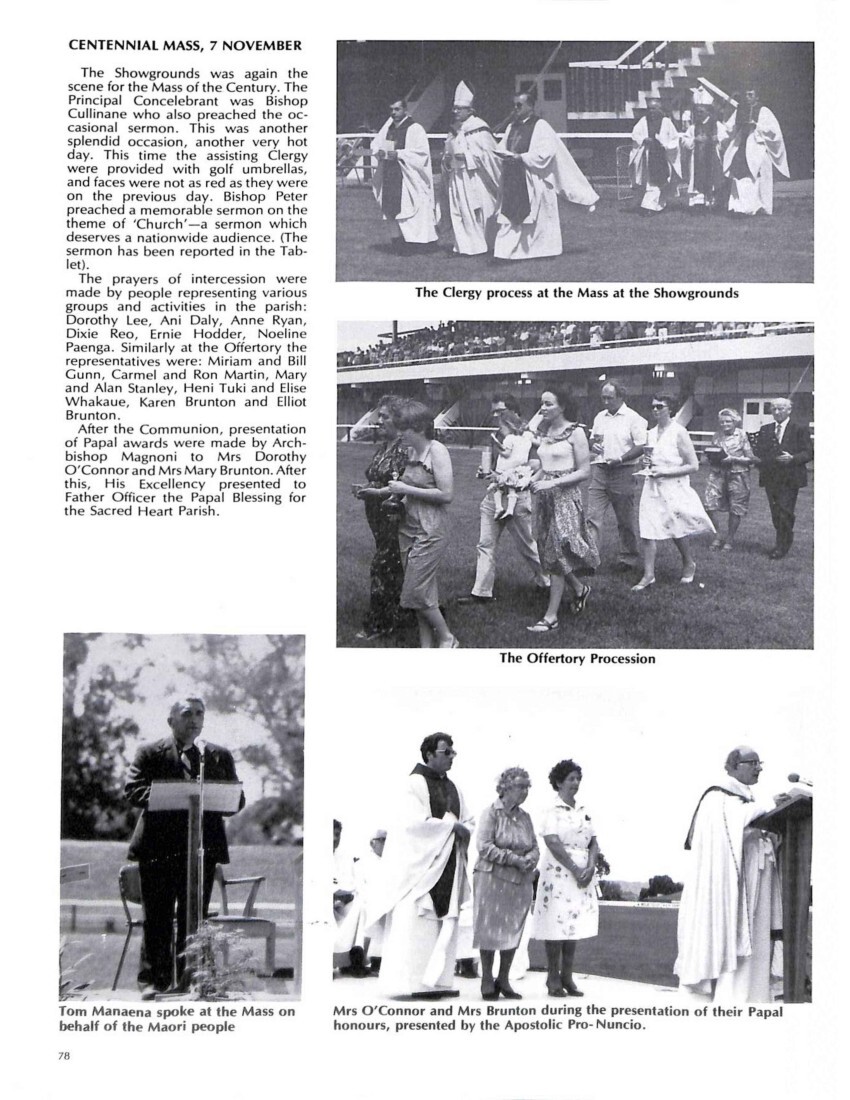
Page 80
THE BLESSING OF THE RENOVATED SANCTUARY AND CHURCH, AND UNVEILING OF COMMEMORATIVE PRAYER
This was the final official event of the Centenary. It took place in the Sacred Heart Church, Sunday afternoon, 7 November. Archbishop Magnoni presided at the function, and the various blessings were performed by Bishop Cullinane.
The new Lectern and Altar were blessed. Following the reading of a lesson, Sir Richard Harrison unveiled the Centenary Plaque at the back of the Church. The Plaque records with thanksgiving the labours of the pioneers who built with faith and courage to enrich our heritage.
Father Officer briefly thanked all who had contributed to the success of the Centenary Celebrations. He thanked Sir Richard Harrison for sharing in the celebration, recalling that the congregation of St. Matthew’s had shared with Dean Smyth in the dedication of the present Sacred heart Church in 1895. In this way Sir Richard had re-enacted a part of history and repeated an expression of friendship. Father Officer said he hoped that such friendship would continue into the second century of the History of Sacred Heart Parish.
The afternoon ceremonies concluded with Solemn Benediction of the Blessed Sacrament, at which His Excellency, the Papal Pro-Nuncio was the officiant.
Afternoon tea was served at the Premiere Hall, and a further opportunity was given to parishioners to meet Archbishop Magnoni, Bishop Cullinane and Monsignor Astolfi.
It is fitting to conclude an outline of the final Centenary Ceremonies with the prayer which was at the end of Sunday’s brochure.
Our Prayer for you is, “For a safe journey home and until we meet again may God hold you in the palm of His hand”.
The Bishop incenses the altar……
…and anoints the new altar with holy oil.
Part of the congregation at the Rededication and Blessing of the renovated church

Page 82
ST. JOSEPH’S SCHOOL CELEBRATION
The children of St. Joseph’s School had the last say in the celebration of the Centenary; and it was a good one. It occupied the whole of the school day, Monday 8 November. In the Premiere Hall there was a grand display of the pupils’ art work and a visual account of the important events in the history of Hastings. A feature was the presentation of School photos from 1900 on. There were all sorts of activities throughout the day including a fancy dress parade with accent on period costumes. There was a folk dancing display, decorated bicycles and trolleys, and an attractive cake competition. After a shared lunch among family groups and class groups, there were demonstrations of shingle making, weaving and spinning, barrel making, together with displays of vintage cars, and a presentation from the Collectors’ Club. Altogether it was a grand centennial celebration. Many thanks to the enthusiastic teachers who organised such a comprehensive occasion. Thanks also to the children who participated with such fun and freedom, to the parents who attended and to the Parish Priest who provided ice-blocks for all.
Shortly after this day, the school began into its new quarters in Tenison College, where classes began for the first time on Monday, 15 November. This shifting into new quarters was part of the integration deal. The St. Joseph’s School is to be integrated on 8 December – another important milestone in the history of Catholic education in Hastings.
Turning back the clock: the St. Joseph’s school celebrates its centennial
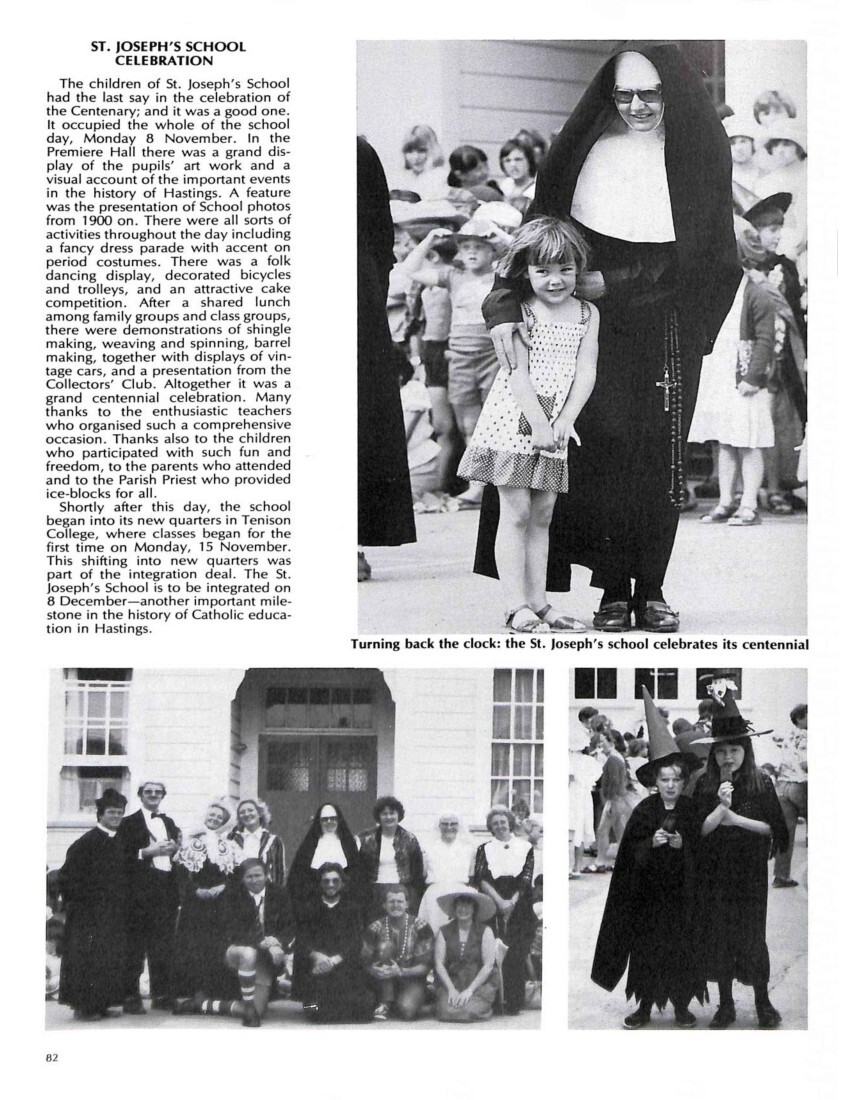
Page 83
Centennial Committee Photo:
Back: (Left to Right): Messrs Keith Stinson, Liam Spring, Bernie Unverricht, Mrs Noeline Paenga, Messrs Tom Kerrisk, Brian Cram.
Front: Mrs Colleen Hamilton; Mrs Dixie Reo, Mr Brian Epplett (Chairman), Fr. Geoff Officer (Parish priest), Mesdames Joan Baillie, Margaret Harding and Eileen Kidd.
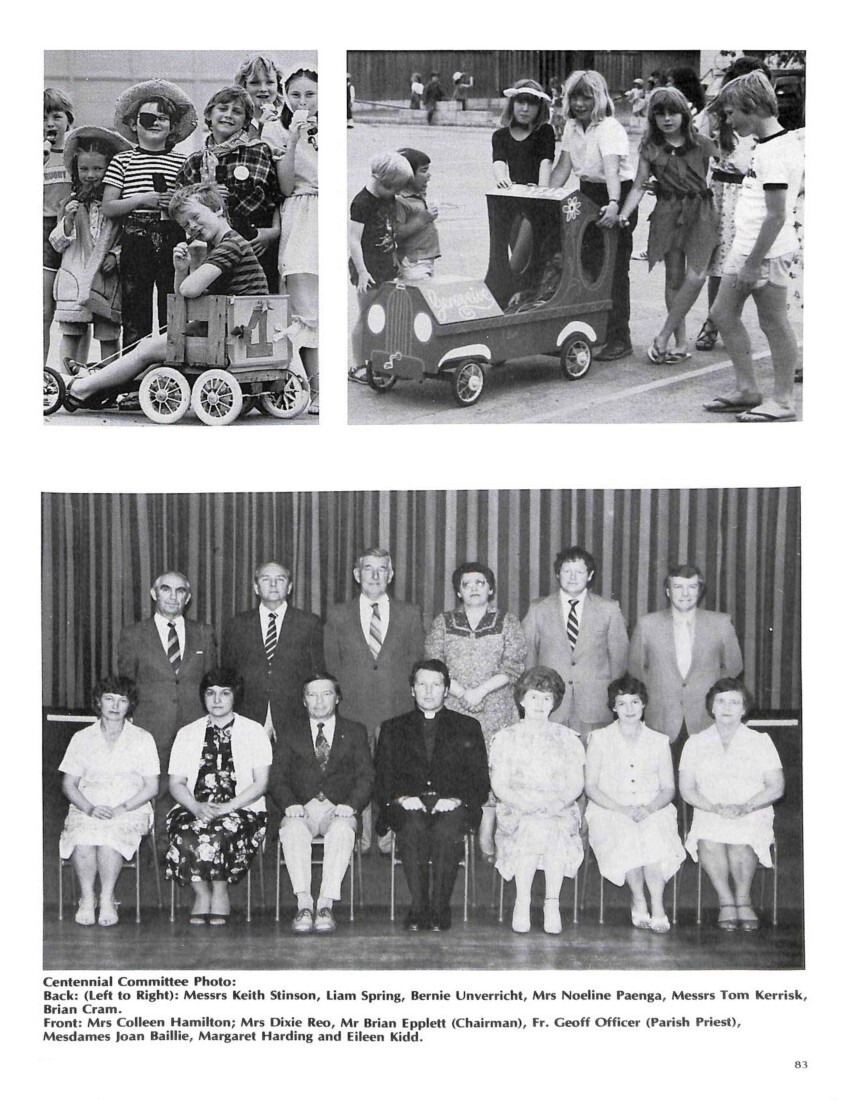
Non-commercial use

This work is licensed under a Attribution-NonCommercial 3.0 New Zealand (CC BY-NC 3.0 NZ).
Commercial Use
Please contact us for information about using this material commercially.Can you help?
The Hawke's Bay Knowledge Bank relies on donations to make this material available. Please consider making a donation towards preserving our local history.
Visit our donations page for more information.
Description
Surnames in this booklet –
Abbott, Adams, Ahern, Aldridge, Allen, Alley, Allison, Allsop, Amner, Anderson, Andrews, Annunciata, Anthony, Arahill, Astolfi, Athanase, Atkins, Aubert, Austin, Baillie, Bain, Ball, Barrett, Barry, Basil, Baty, Bearsley, Beck, Beder, Begley, Begley, Begley, Begley, Benjamin, Beran, Bernard, Black, Blake, Blasoni, Bliss, Bloore, Bolgar, Borgia, Bowen, Bower, Brady, Brandon, Breen, Brennan, Brice, Bridgeman, Brimer, Brittain, Brooking, Brunton, Bryant, Buchanan, Buck, Buckley, Burke, Burndrett, Burns, Butcher, Butler, Caccioppoli, Cahill, Caldwell, Campbell, Carmel, Carney, Carr, Carroll, Casey, Cassin, Catherine Anne, Caulfield, Caulton, Chadwick, Chaney, Childs, Chote, Christian, Clabby, Clare, Clarke, Cleary, Coe, Coghlan, Cole, Colin, Collinge, Collins, Coman, Condon, Connolly, Conroy, Constance, Conway, Cook, Coombs, Cooper, Copeman, Cosgrove, Cowan, Cox, Crabtree, Cram, Cronin, Cross, Crowley, Cullen, Cullinane, Cummins, Daly, Danvers, Dawes, De Lach, Dean, Dennett, Devonport, Devoy, Dignan, Donnelly, Donovan, Dooley, Dowling, Downes, Downey, Downing, Drane, Dugleby, Duigan, Duncan, Dunn, Durning, Eastwick, Eccleston, Edwards, Egan, Ellis, Elwood, Elwood, Emea, Enda, Epplett, Esam, Farrelly, Favre, Fay, Felicitas, Fennessey, Fernie, Fidelis, Field, Fieldsend, Fieldson, Fisher, Fitzgerald, Fitzsimmons, Fitzwilliams, Fleming, Florentin, Flynn, Fogarty, Forest, Foster, Fox, Fraher, Francis, French, Furstenberg, Galerne, Galgey, Gallagher, Gardner, Garnett, Garvey, Geaney, Geddes, Genevieve, Geor, Geor, Geor, Geor, Geor, Geor, George, Gibson, Giles, Gill, Gillhooly, Gilligan, Goggin, Goldfinch, Gondringer, Good, Gorman, Gottfried, Goulter, Graham, Green, Gregory, Greville, Grimes, Grogan, Gunn, Hagerty, Hall, Hallagan, Halton, Hamill, Hamilton, Hannah, Hannigan, Hardenberg, Harding, Harrison, Hartnett, Harwood, Hassett, Hawaikirangi, Heagney, Heavey, Heeney, Heffernan, Hempseed, Hendren, Hennessey, Herring, Hewetson, Hickey, Hill, Hodder, Hodgins, Holder, Hollerton, Holt, Horan, Horton, Houlahan, Howard, Hughes, Hurley, Hutchins, Hyacinth, Ingram, John, Johnston, Joseph, Karaitiana, Keane, Kearns, Keating, Keehan, Kelley, Kelly, Kennedy, Kennerly, Keogh, Kerins, Kerley, Kerrigan, Kerrisk, Keys, Kidd, King, Kingan, Kinney, Kirk, Kirkpatrick, Kitching, Koko, Koorey, Koorey, Laffey, Lamone, Lampila, Laredo, Lawless, Lee, Leech, Le Lievre, Lemenant, Le Menant des Chesnais, Le Pretre, Le Seuer, Lewis, Little, Loftus, Long, Lorrigan, Loughnan, Lucy, Lynn, Maaka, Macdonald, Mackenzie, Mackle, Maggin, Magnoni, Maher, Mahoney, Mahony, Malone, Maloney, Manaena, Mannix, Manson, Marie, Marriott, Marsh, Marsicano, Martin, Martinez, Marty, Masey, Mather, McBreen, McCann, McCarthy, McCarty, McClaire, McCool, McCorkindale, McCormick, McCrea, McDonald, McDonnell, McGahan, McGlone, McGowan, McGregor, McHardy, McIlroy, McIntosh, McIvor, McKay, McKeefry, McKeegan, McKenzie, McKillop, McLean, McMahon, McManus, McMillan, McNamara, McPherson, McSherry, Meining, Miller, Milligan, Mills, Milne, Minogue, Mitchell, Moffatt, Moffett, Moloney, Monagan, Monica, Montaperto, Montgomery, Mooney, Moore, Moran, Moriarty, Moroney, Morrissey, Moynihan, Muir, Mulcahy, Munroe, Murdock, Murphy, Nash, Ngapare, Nightingale, Nihill, Nowlan, Nugent, O’Brien, O’Callaghan, O’Connel, O’Connell, O’Connor, O’Connor, O’Donnell, O’Donoghue, O’Farrell, Officer, O’Grady, O’Halleron, O’Kane, O’Keefe, O’Leary, O’Neil, O’Neill, O’Regan, O’Reilly, O’Rourke, Olsen, O’Shaughnessy, O’Shea, O’Sullivan, Otto, Oulaghan, Paenga, Patricia, Pauline, Pearse, Peoples, Perkins, Perry, Pertuis, Peyton, Philomena, Pierce, Pipe, Plowman, Plummer, Polding, Pompallier, Poppelwell, Poppelwell, Poppelwell, Potham, Puhara, Pullen, Quin, Quinlivan, Quinn, Rainbow, Rainbow, Rawson, Rea, Rearden, Redwood, Reid, Reignier, Reo, Reston, Revel, Richards, Riordan, Roberts, Rodgers, Roe, Ross, Roughton, Russell, Ryan, Ryder, Sauzeau, Saxon, Scanalon, Scanlon, Schmidt, Schollum, Scott, Scullion, Scully, Seddon, Seed, Seon, Seymour, Shadbolt, Shanahan, Shanly, Sharp, Shaw, Sheath, Sheehan, Siegrief, Skerritt, Smith, Smyth, Smythe, Snedden, Sollitt, Soulas, Spring, St. Clair, Stack, Stairmand, Stanley, Stephens, Stephensen, Stevenson, Stewart, Stilburn, Stinson, Stirling, Stopforth, Stothart, Stuart, Sullivan, Sullivan, Sullivan, Sweeney, Tacon, Tacon, Tanner, Taylor, Te Awhitu, Tenison, Teresa, Thecla, Thimbleby, Thompson, Thomson, Tohi, Tomoana, Toothill, Tuki, Tully, Tymons, Unverricht, Van Hooijdonk, Venning, Viard, Vickers, Wahl, Walford, Wall, Wallace, Walsh, Walters, Ward, Warfeld, Watkins, Watson, Watters, Whakaue, White, Whiteford, Whiting, Wilding, Williamson, Willis, Wilson, Wimsett, Windle, Wishart, Woods, Wright, Yardin, Yates

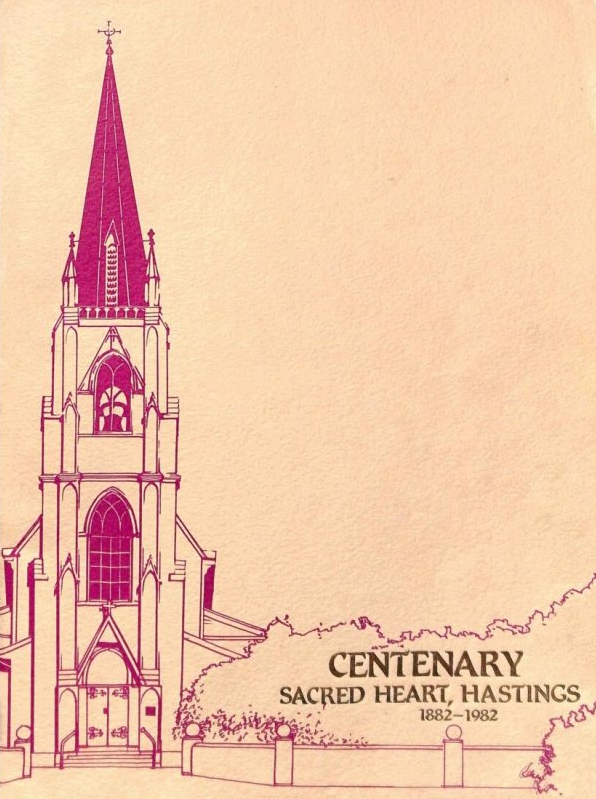
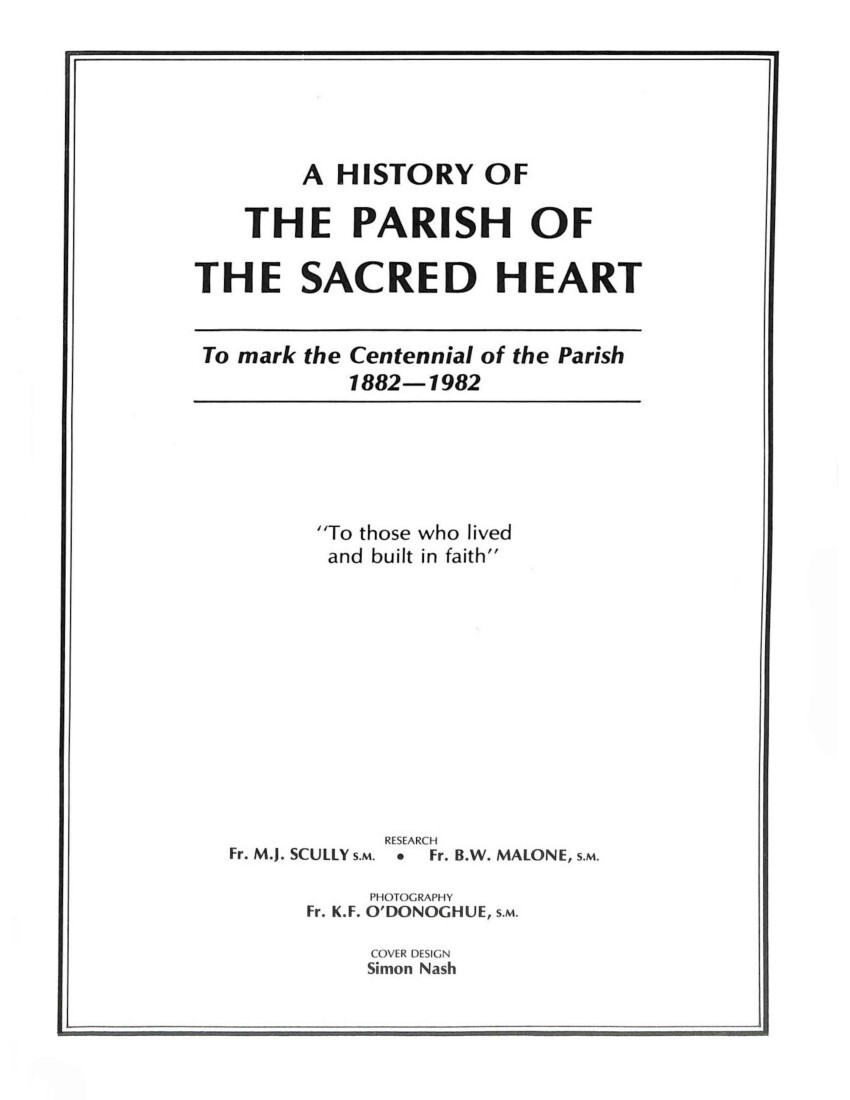
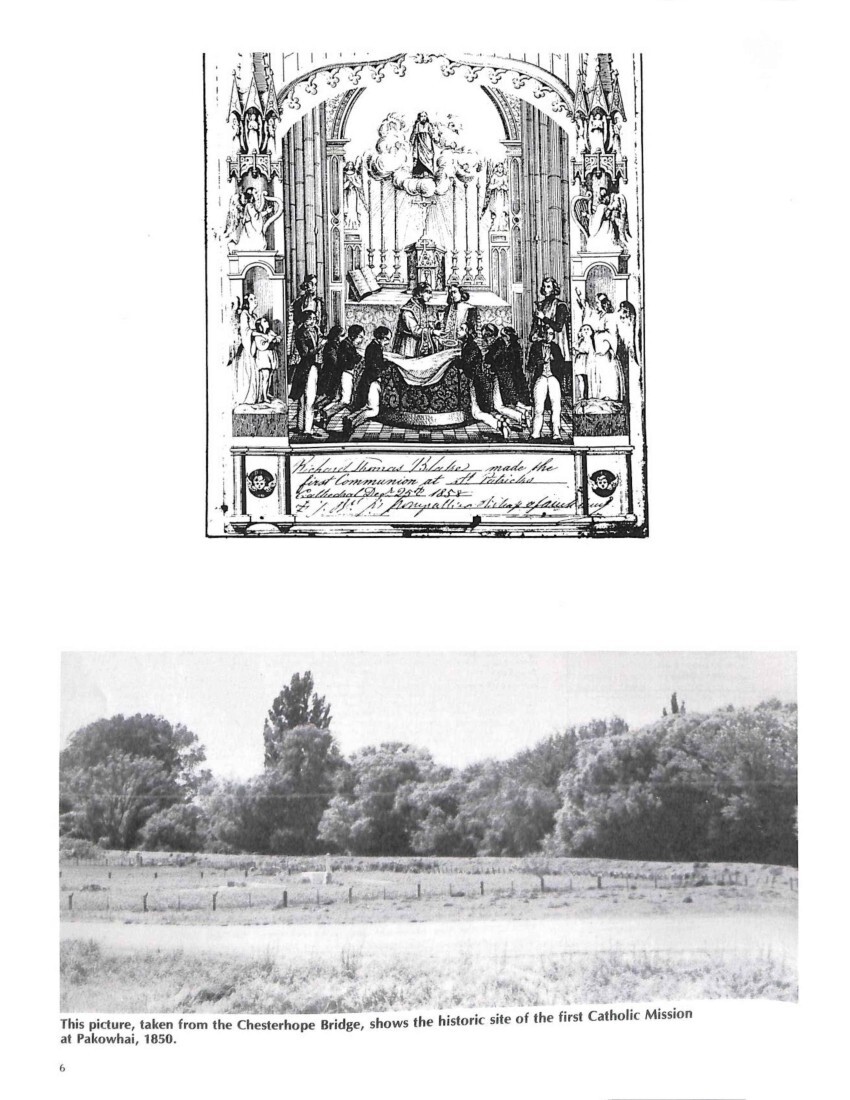
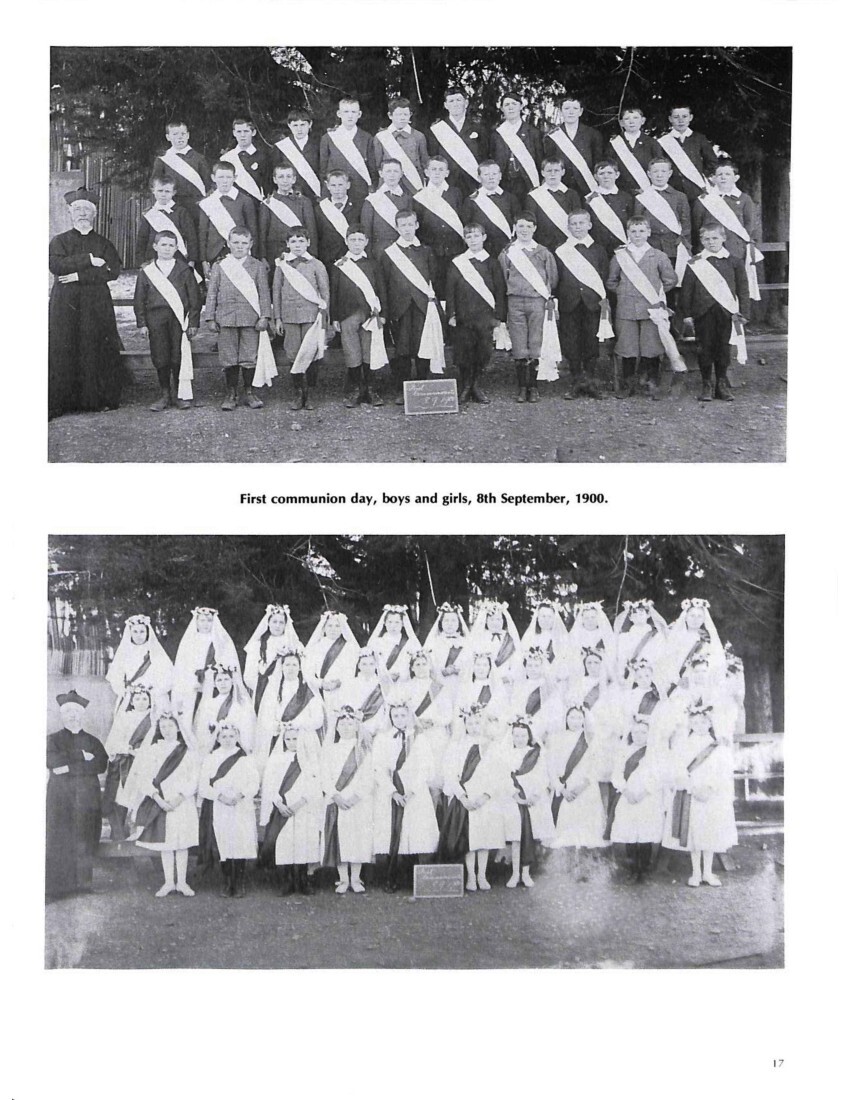
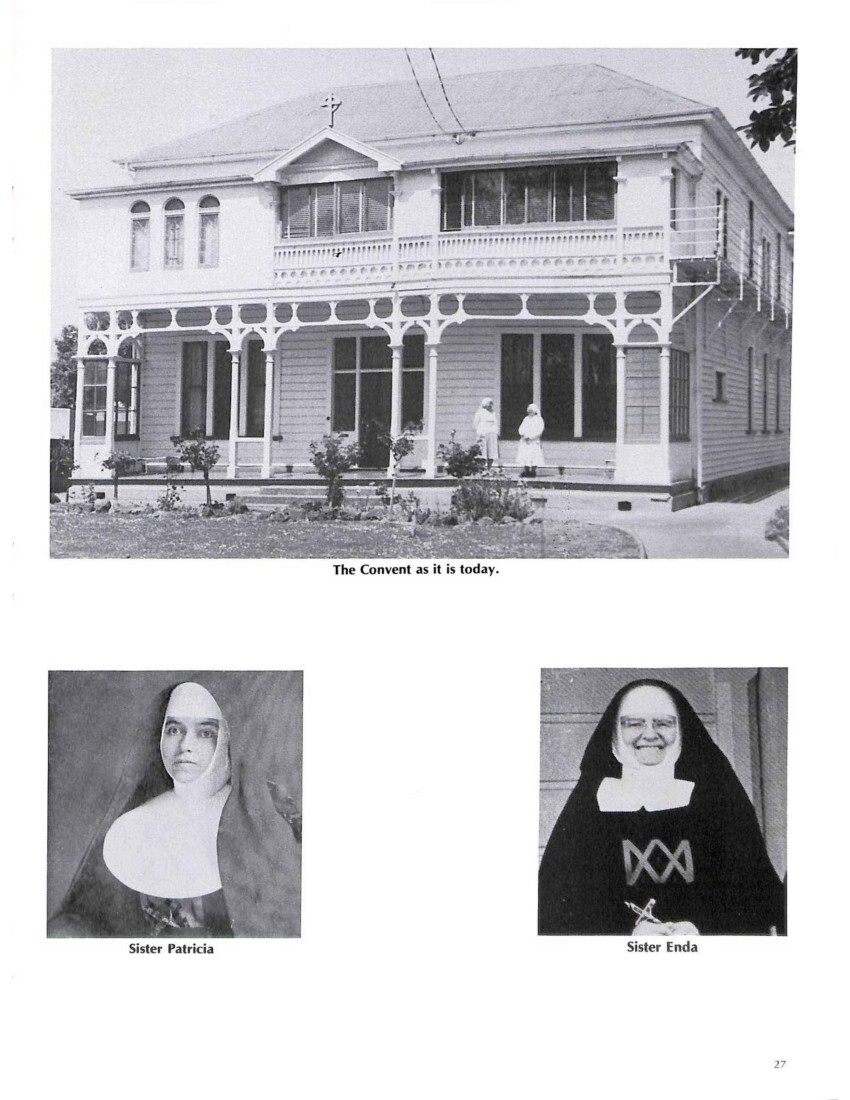
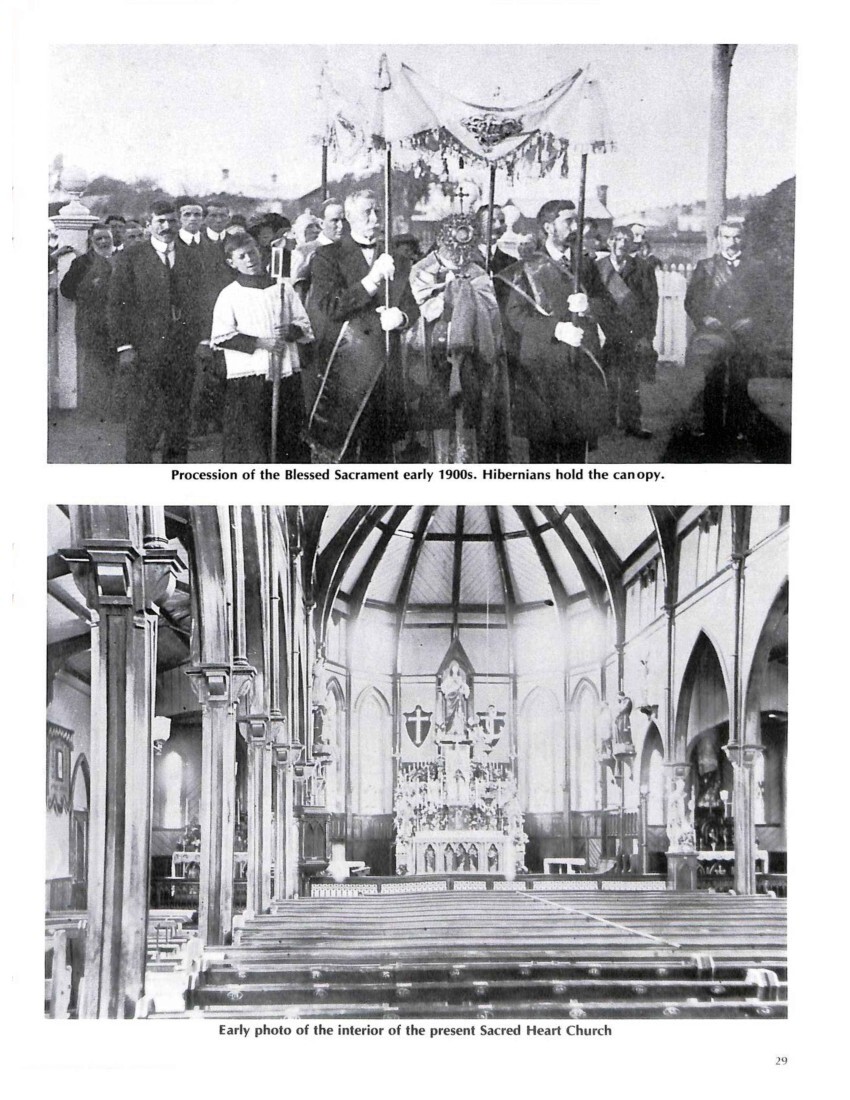
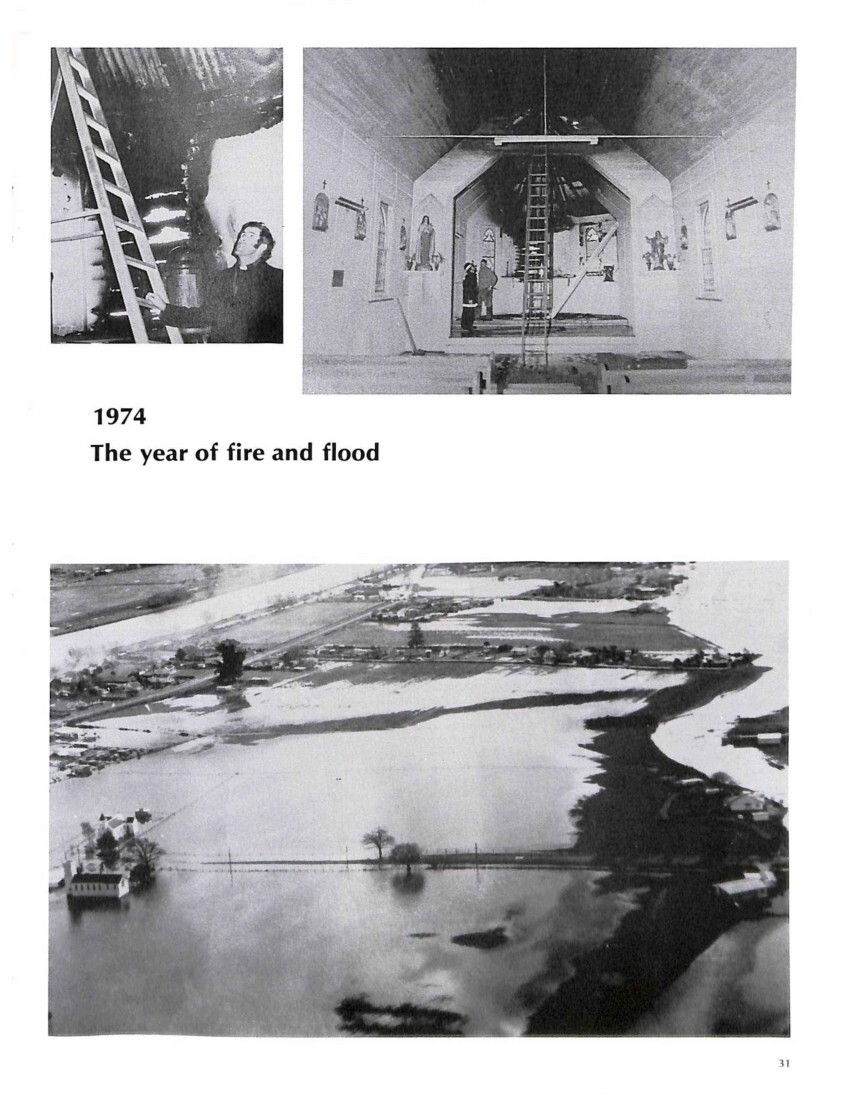
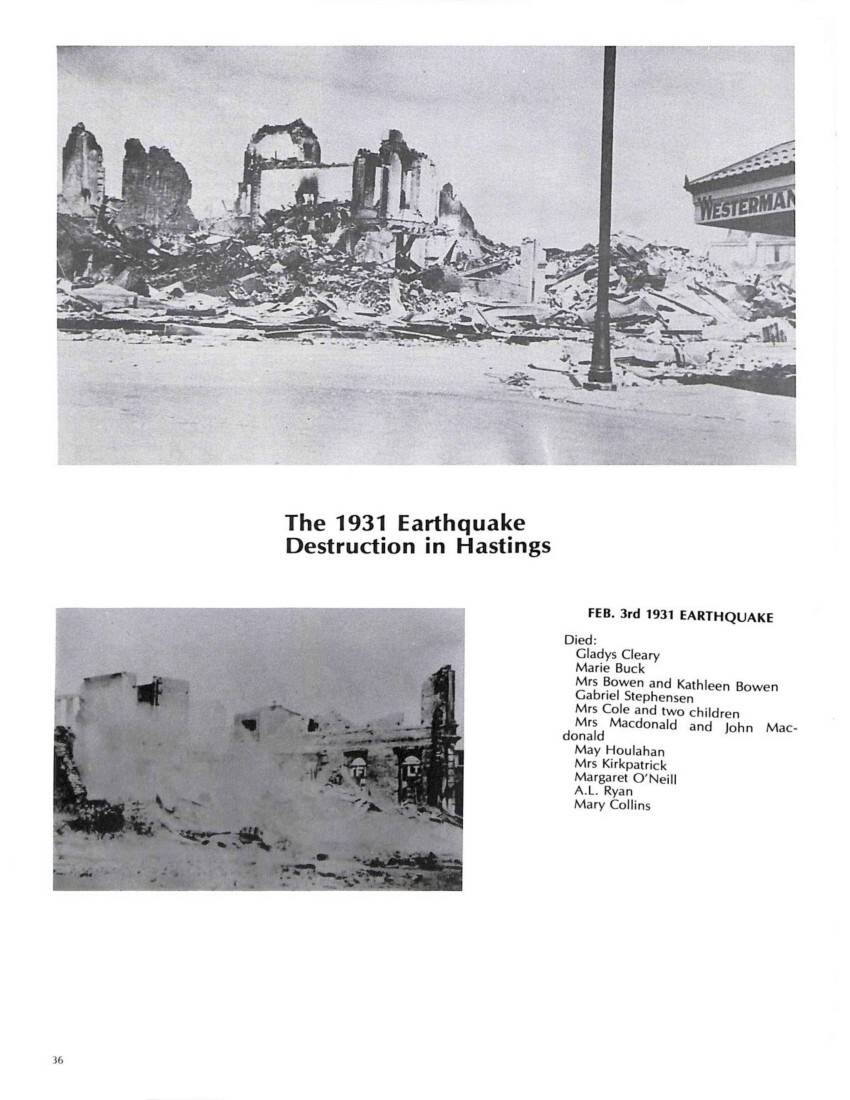
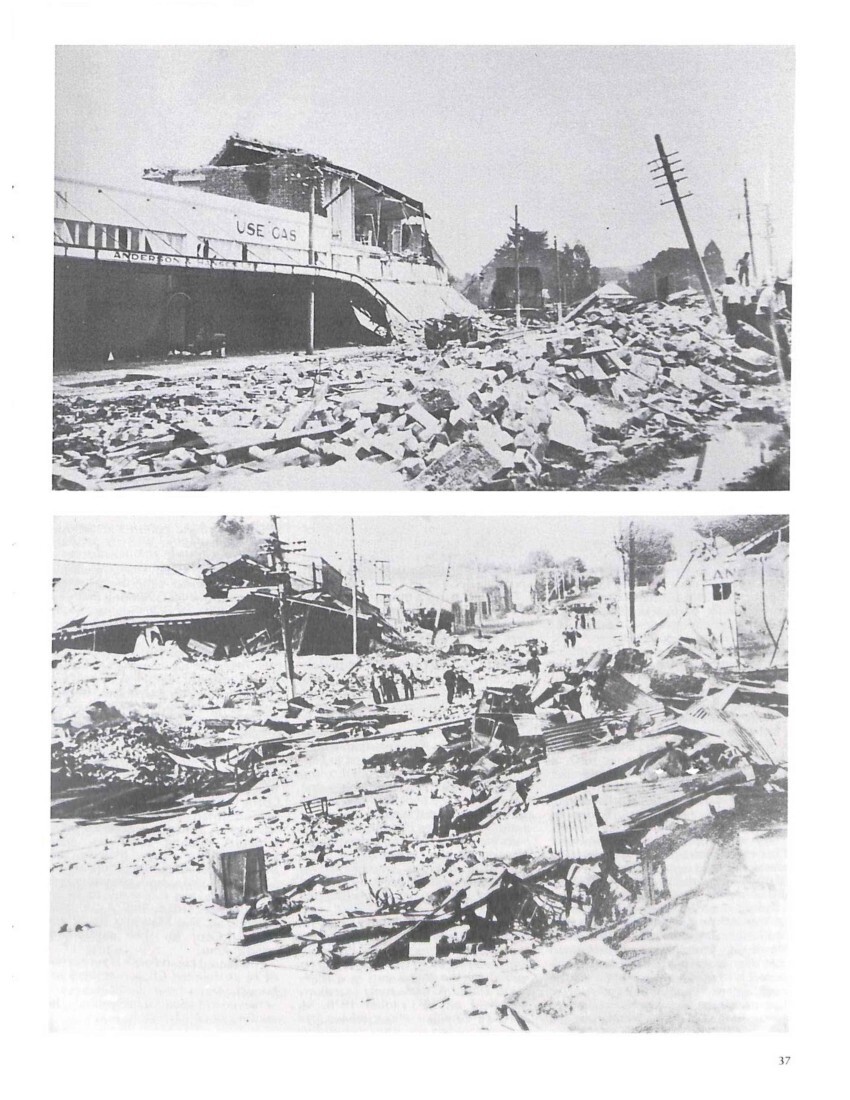
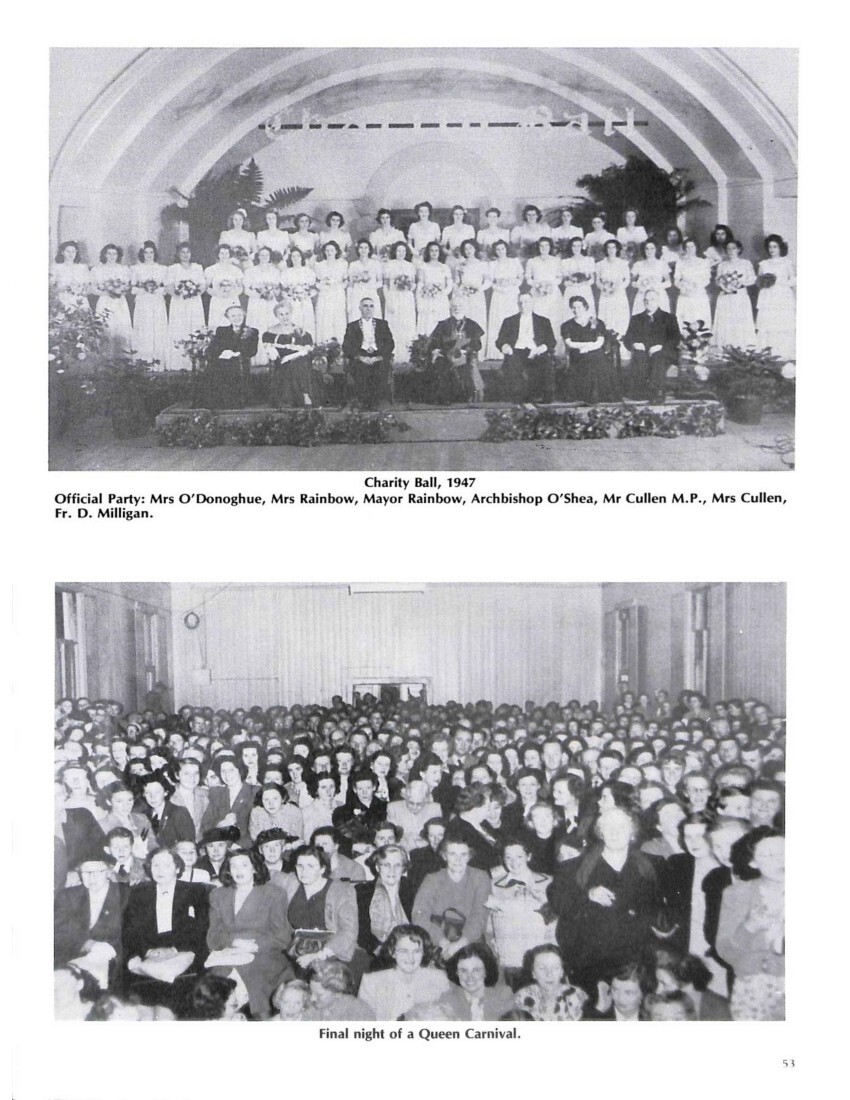
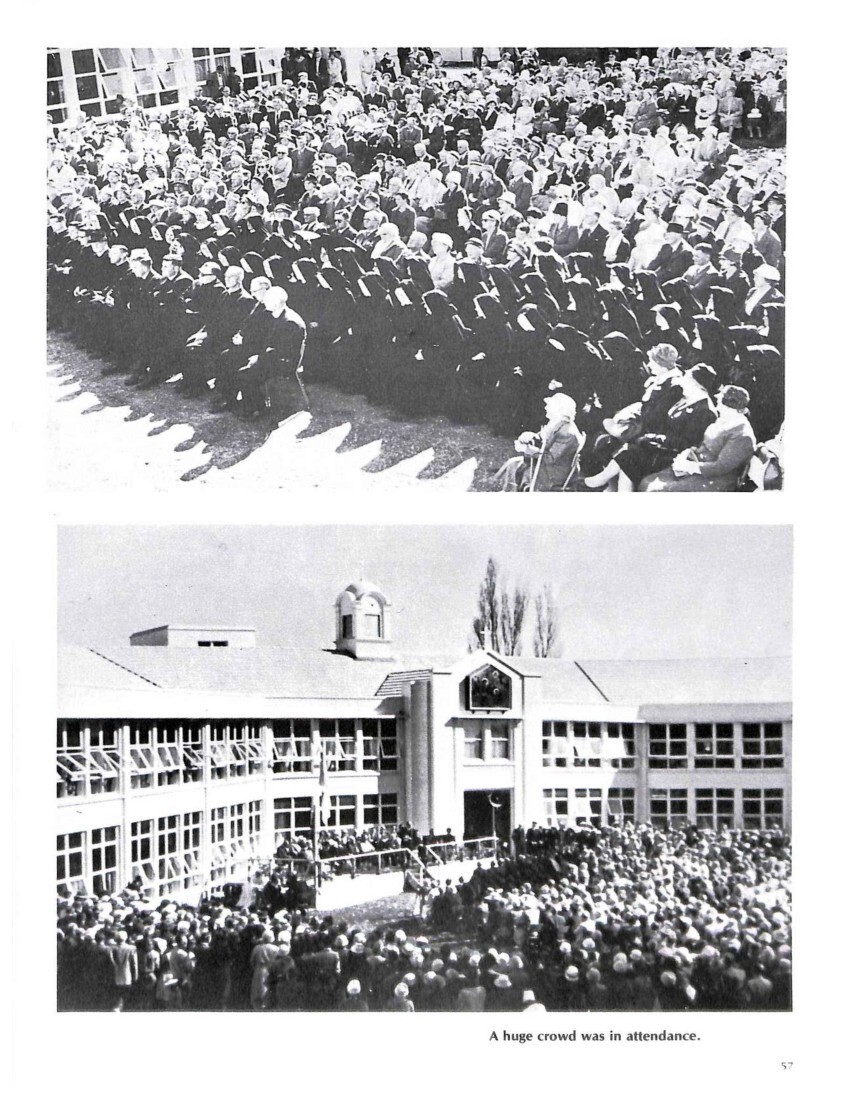

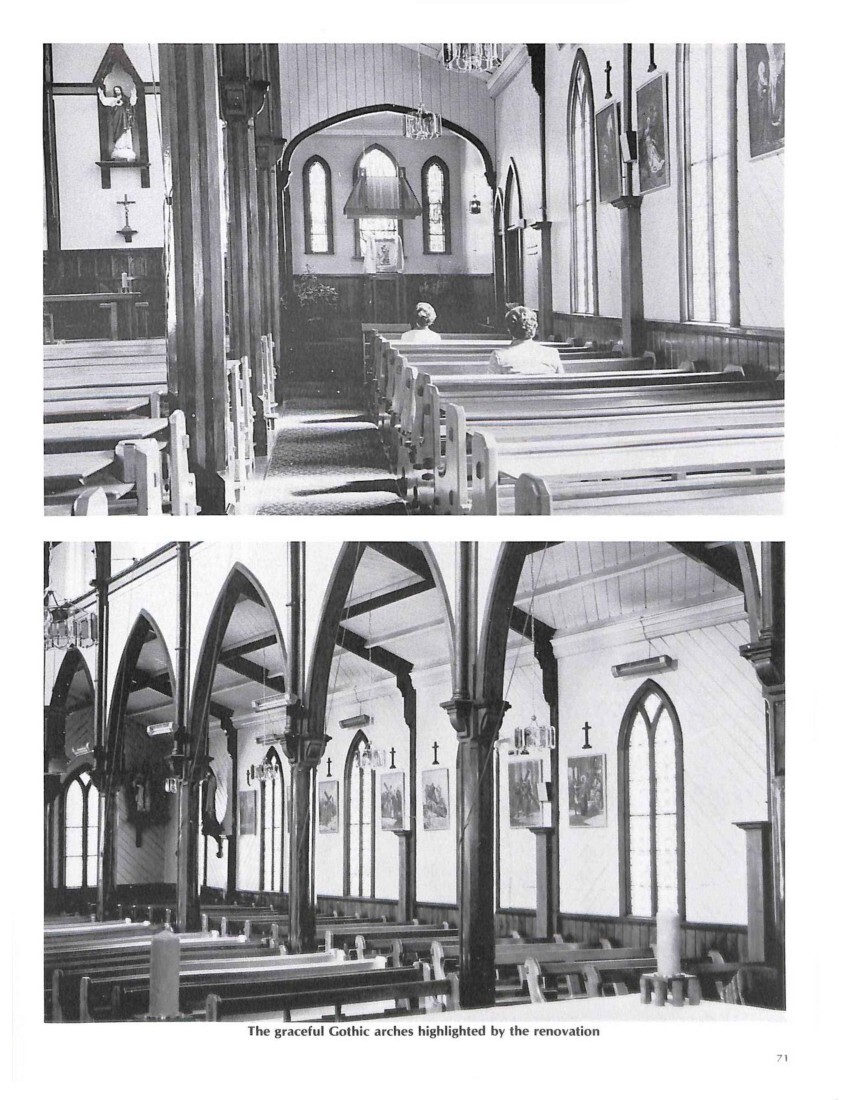
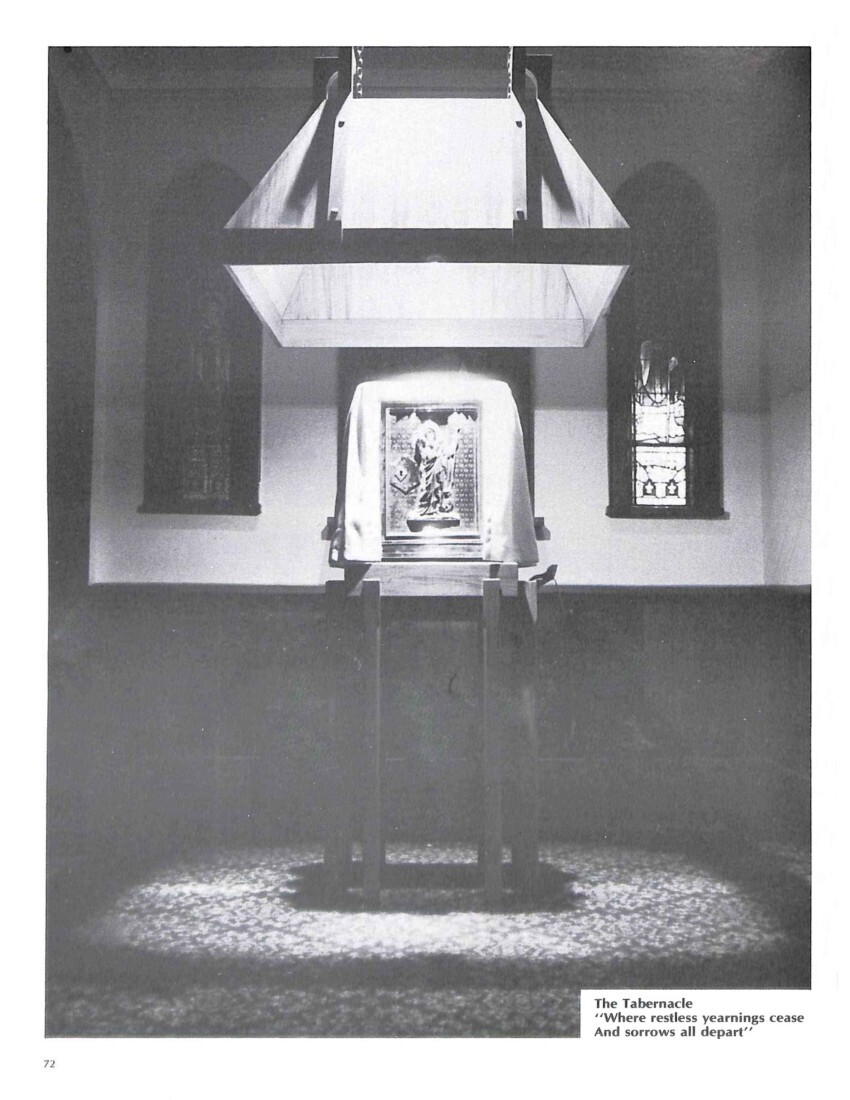
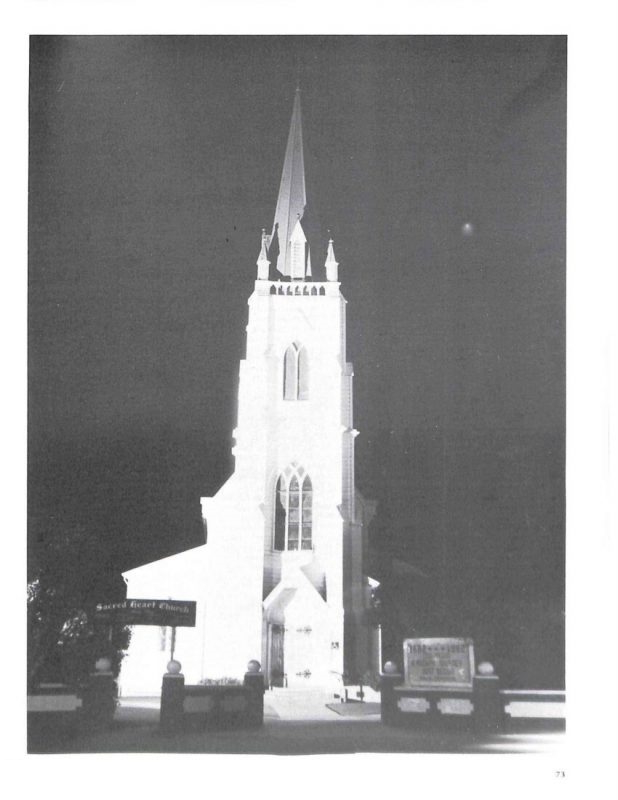
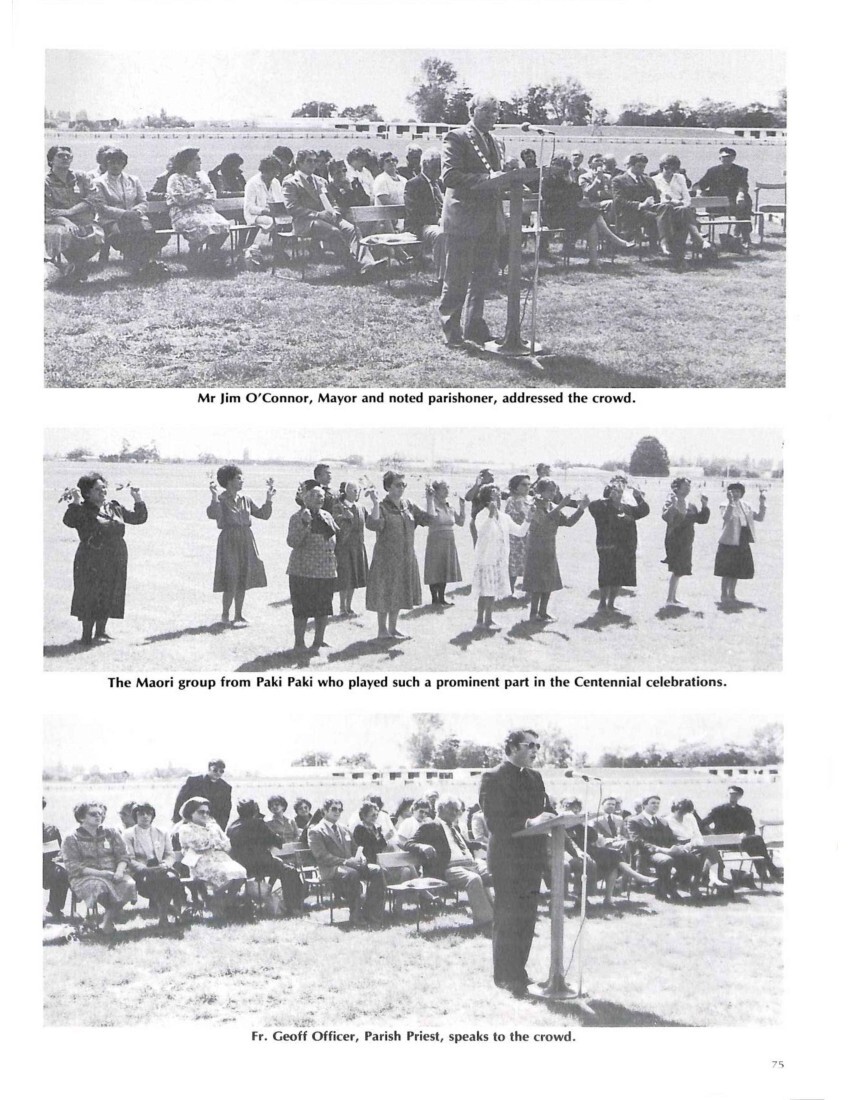
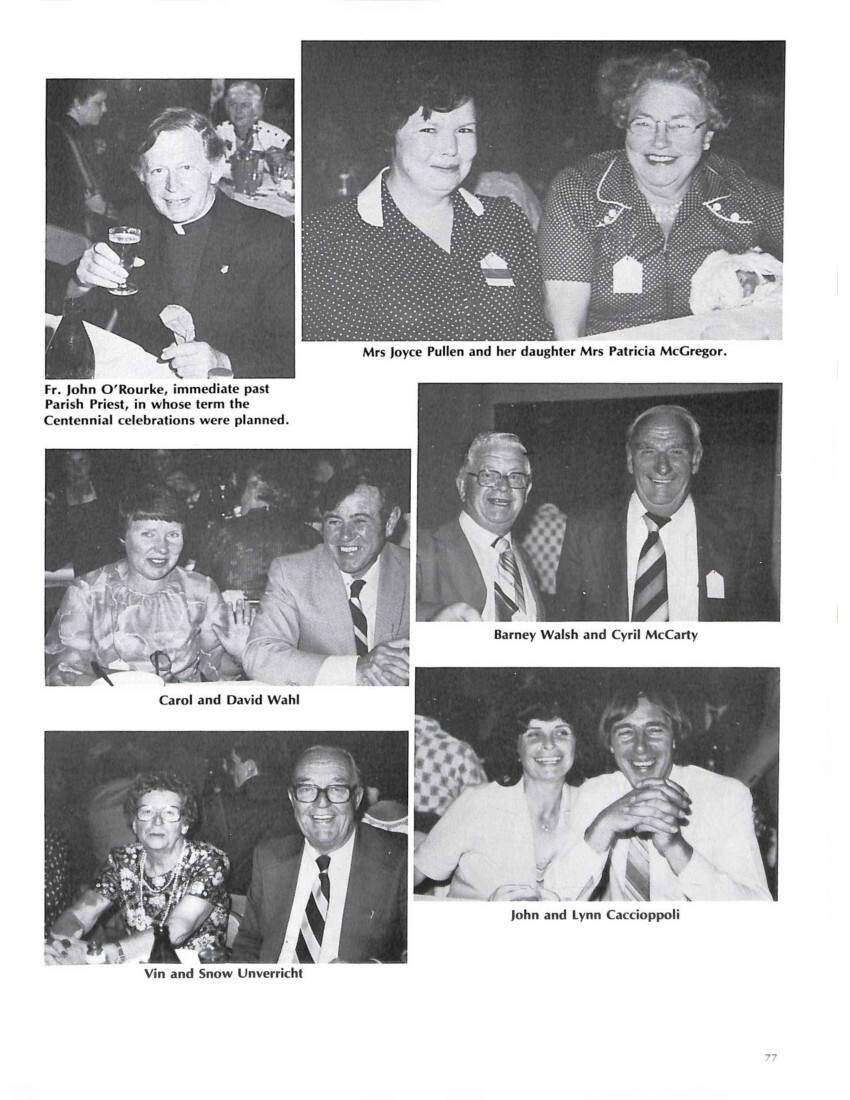

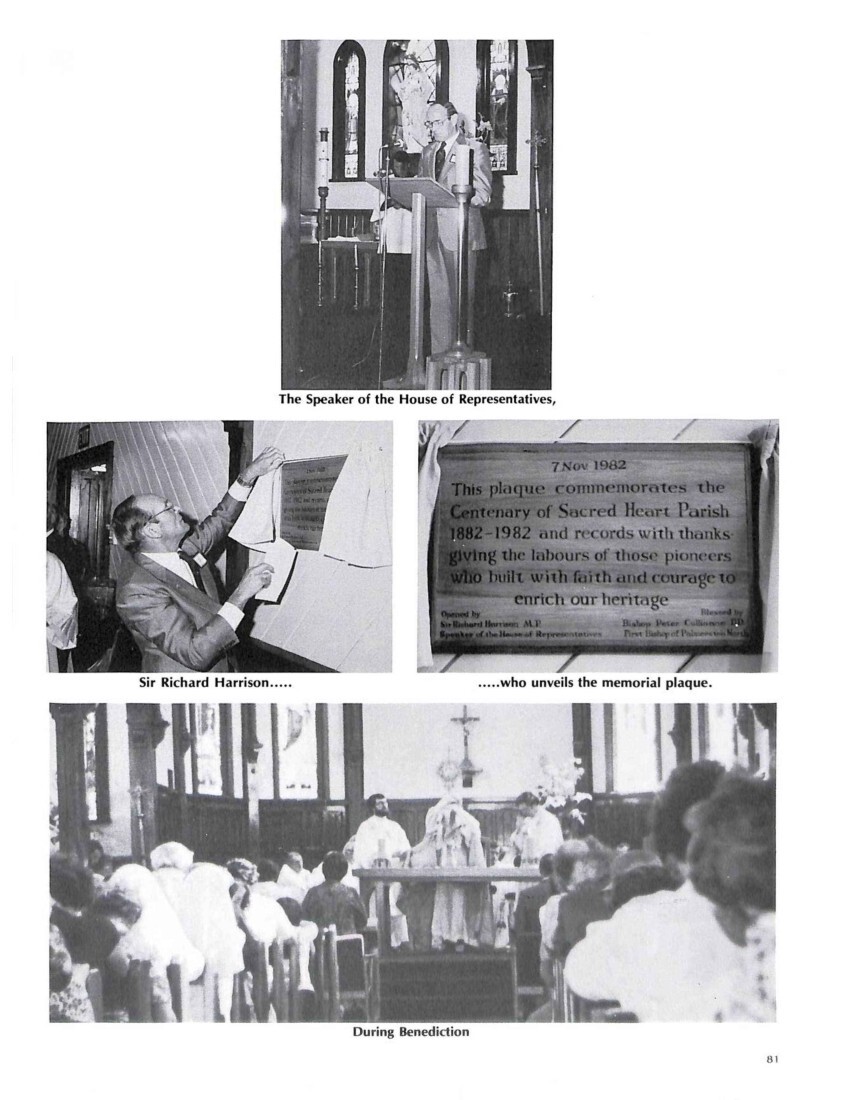











Do you know something about this record?
Please note we cannot verify the accuracy of any information posted by the community.